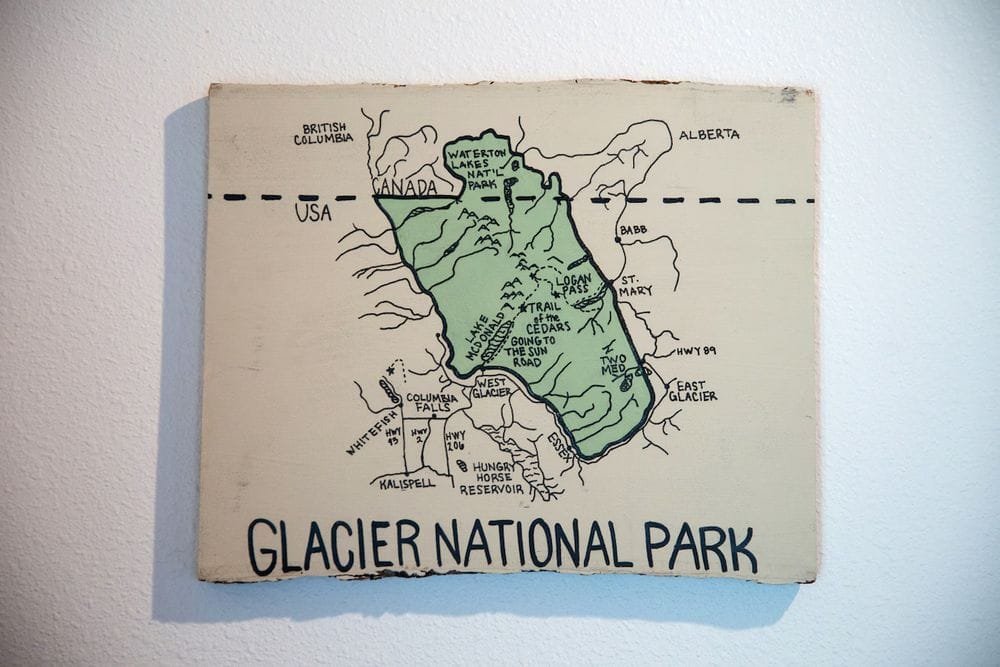Vous pouvez lire le billet sur le blog La Minute pour plus d'informations sur les RSS !
Canaux
6974 éléments (441 non lus) dans 56 canaux
 Dans la presse
(302 non lus)
Dans la presse
(302 non lus)
 Du côté des éditeurs
(19 non lus)
Du côté des éditeurs
(19 non lus)
 Toile géomatique francophone
(91 non lus)
Toile géomatique francophone
(91 non lus)
 Géomatique anglophone
(19 non lus)
Géomatique anglophone
(19 non lus)
 opensource
opensource
-
sur Sean Gillies: A new CLI for GDAL
Publié: 9 November 2024, 6:54pm CET
Even Rouault has proposed a new, modern, and more coherent command line interface (CLI) for the GDAL/OGR project. I think it's a good idea and a good time to do it. I've wanted a better one for about 15 years. Even credits Rasterio for inspiration, and that's gratifying to see. I started writing Rasterio 10 years ago in part because I wanted a better CLI for GDAL.
What I wanted in a GDAL CLI were the following features:
A root command and a few subcommands, one namespace for everything.
Uniform arguments and options with predictable ordering and naming.
Good documentation of arguments and options.
More subcommands with fewer options each. Making gdal_translate into 3-4 commands, for example.
Input and output that favor stdin/stdout and JSON.
Ease of installation. For example, with pip instead of an OS package manager.
I estimated in 2013-2014 that it was not feasible for me to achieve those goals within the GDAL project itself. GDAL and its community had no funding for this kind of work at the time. I found the GDAL project's tests somewhat inscrutable and frustrating. A hefty legacy of documentation and folk wisdom about the old ways would have to be updated. Mostly by me, certainly. And the GDAL user community largely did not care. Free software that was fast and effective (and, most of all, free!) was already more than most people had dreamed of. A GIS analyst had so many business and organizational problems to deal with already that the rough edges of gdalinfo and gdal_translate didn't even crack her top 20. Software polish wasn't a big concern in the second decade of FOSS4G. I think it's still a hard thing to sell. Individual consumers will pay money for slick, well-designed software that makes them feel good. Organizations value polish less. And neither GDAL nor Rasterio sell anything to individual consumers.
Overhauling gdal_translate, ogr2ogr, and friends within the GDAL project looked like a non-starter to me. Pushing a herd of boulders up a hill, by myself, for free, for a community that was largely content with working around and stepping over these boulders. I think I made the right choice for myself. I got to start from scratch, move fast, and use a modern CLI framework. I made a command line interface for Rasterio that, while not perfect, met most of my goals. And I didn't go broke or burn out while doing it.
Today, thanks to years of fundraising work by Howard Butler, Paul Ramsey, Kristian Evers, and Even, the GDAL project does have funding to overhaul its command line interface as an aspect of overall project health and maintenance. Multiple developers can be paid to work on it. They won't have to donate their time to it as I would have. Rasterio's command line interface can't be adopted by GDAL, or be forked to become GDAL's because it doesn't have all the features of existing GDAL programs (or even of gdal_translate and ogr2ogr for that matter), and my decision to have more subcommands with fewer options is kind of against the grain of GDAL. But the new GDAL CLI can adopt the demonstrably useful features and design of Rasterio's. JSON output, for example, is something that GDAL has already picked up from Rasterio.
Rasterio will certainly fade a little if the new GDAL CLI is designed and executed well. But that's in the nature of software and software communities. Rasterio has always depended on GDAL and benefited from being built on a technically solid and well loved foundation. And I didn't invent CLI subcommands and JSON output, not at all. It's not unfair. If you succeed in open source, if you move the needle, you will be emulated. In this case, I think we can call it progress. I'm content.
In the long run, I stand to get half of what I originally wanted from a GDAL CLI, the first three of the six features I listed above. And there's probably still room for a suite of Unix style programs with different opinions and design decisions, especially if it and GDAL agree on basic concepts, arguments, options, and flags.
-
sur Mappery: Kunjapuri
Publié: 9 November 2024, 11:00am CET
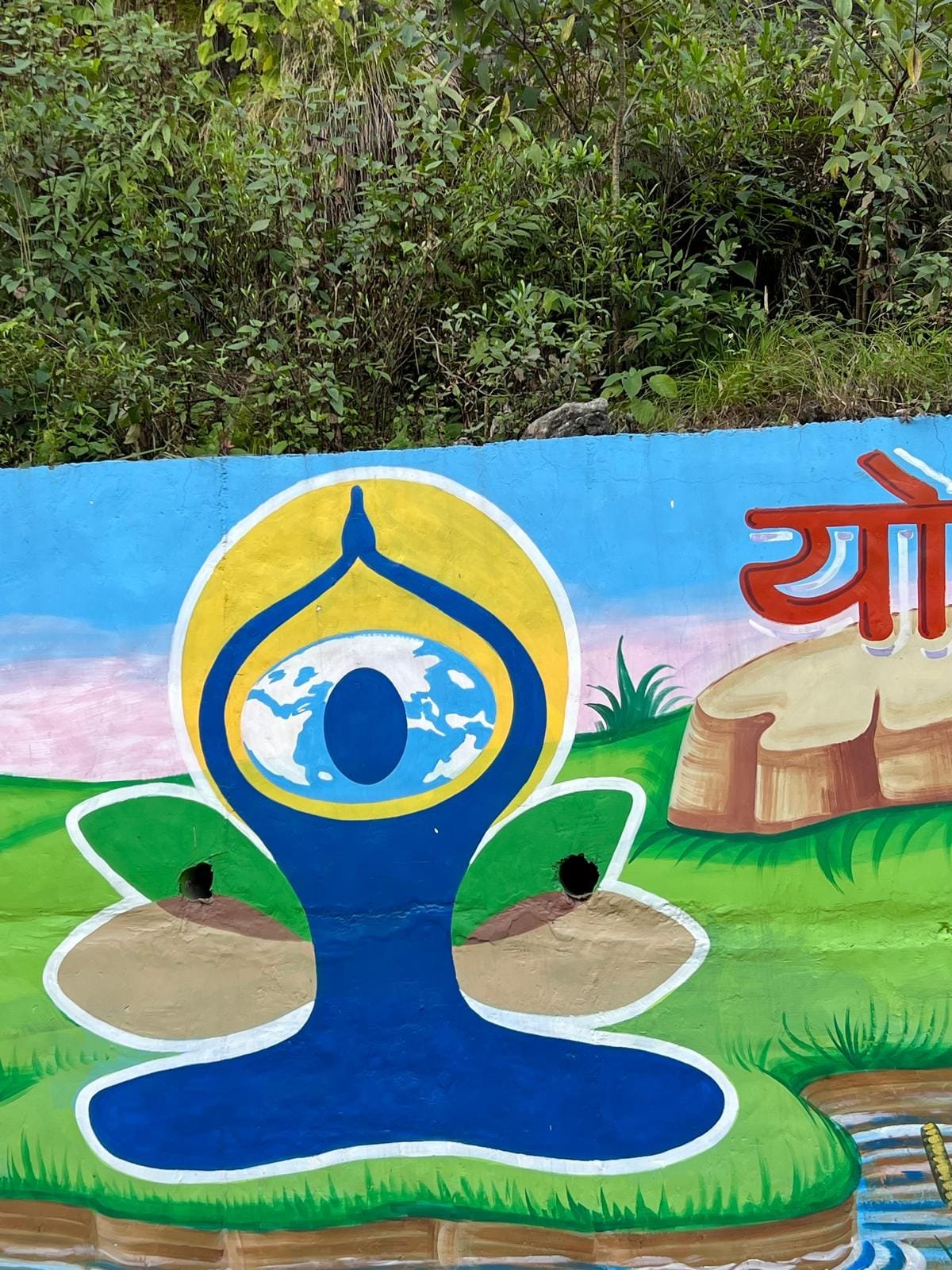

Elizabeth spotted this street art on her way to the Kunjapuri temple. A quick search suggests that it is the symbol for International Yoga Day but you already knew that didn’t you?

-
sur Sean Gillies: Your account is deactivated
Publié: 9 November 2024, 6:03am CET
I stopped using Twitter a while ago. Then it was rebranded as "X". I dithered about deleting my account. Would it be taken over by crypto scammers or an 18 year-old Russian army private or contractor? I've come to the conclusion that I don't care anymore. They can have it if they want. I've downloaded my archive and clicked "deactivate your account".
If you see a post from an @sgillies on X, it isn't me.
-
sur Fernando Quadro: Começou a Black Friday Geocursos!
Publié: 8 November 2024, 1:00pm CET
A maior promoção de 2024 começa hoje, dia 08 e vai até o dia 10 de novembro.
 Essa é a sua chance de adquirir nossos cursos com descontos imperdíveis nessa Black Friday.
Essa é a sua chance de adquirir nossos cursos com descontos imperdíveis nessa Black Friday.Cursos que estão com desconto:
 Combo: PostgreSQL, PostGIS e GeoServer (EAD Videoaula com 38h/aula)
Combo: PostgreSQL, PostGIS e GeoServer (EAD Videoaula com 38h/aula)
 50% de desconto
50% de desconto
 Acesso por 24 meses
Acesso por 24 meses Combo: PostgreSQL, PostGIS, GeoServer e OpenLayers 4 (EAD Videoaula com 53h/aula)
Combo: PostgreSQL, PostGIS, GeoServer e OpenLayers 4 (EAD Videoaula com 53h/aula)
 60% de desconto
60% de desconto
 Acesso por 24 meses
Acesso por 24 meses Os cupons de desconto estão sendo informados no nosso Grupo VIP, basta você clicar no link abaixo :
Os cupons de desconto estão sendo informados no nosso Grupo VIP, basta você clicar no link abaixo : -
sur Mappery: Old T Shirt
Publié: 8 November 2024, 11:00am CET
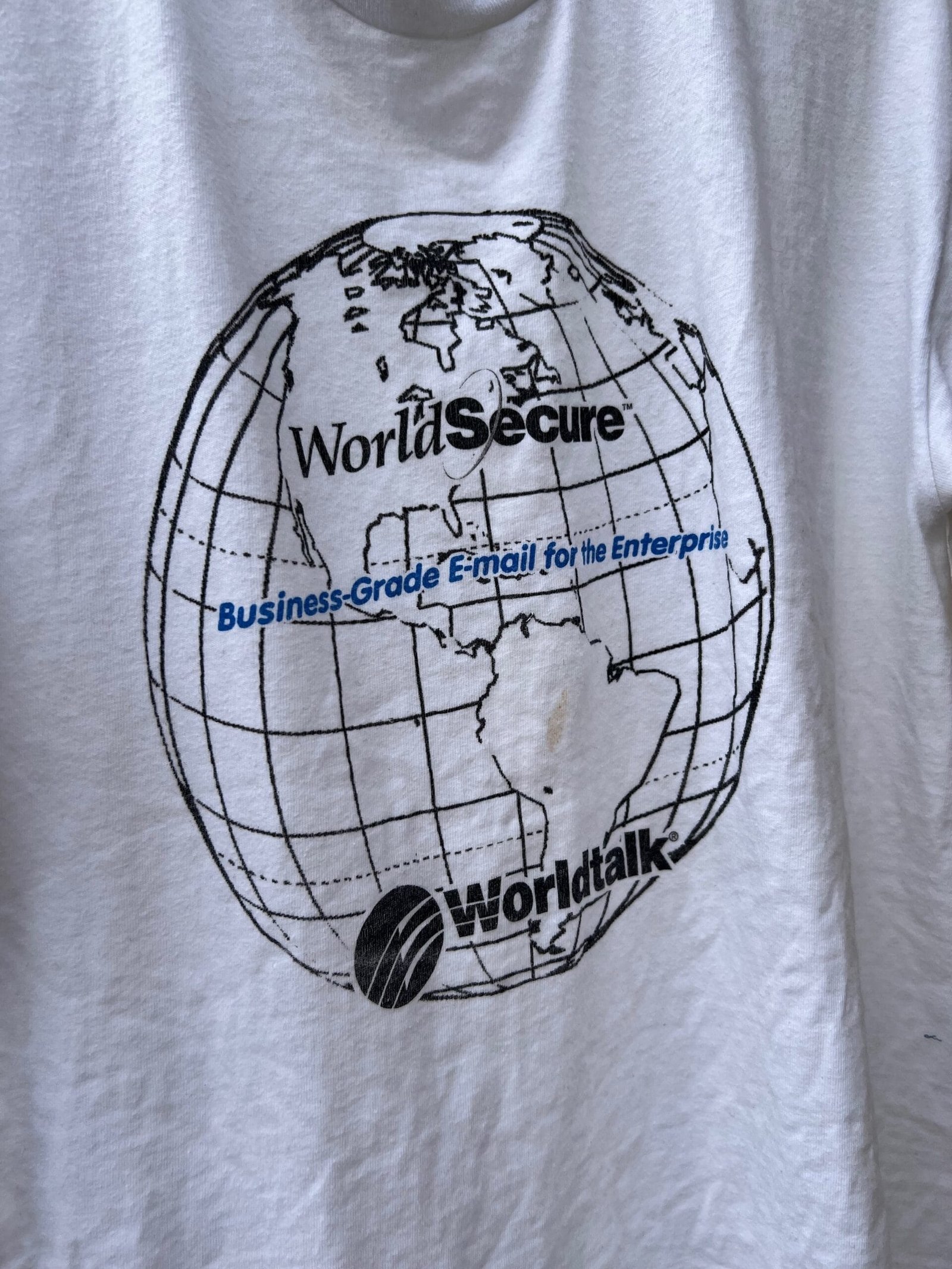

I found this old T-shirt in a box in storage, long forgotten. This was a swag from my first employment.
-
sur Sean Gillies: On my feet
Publié: 8 November 2024, 5:54am CET
Saturday, I reported that I was laid up with a back injury. I'm feeling better today. The pain is manageable and I've been able to spend about half of my time awake upright, standing or sitting on my bed, with regular breaks to touch my toes and do the yoga half lift to stretch my back. I even managed to run a little bit yesterday while helping a guy who was the victim of a hit-and-run incident. Car on car, to be specific. No one was injured, as far as I could tell.
Ban cars. Ban injuries.
-
sur Sean Gillies: It's CyberGIS all over again
Publié: 8 November 2024, 5:23am CET
In a Mastodon thread about "GeoAI" today, I blurted out:
Uh huh. It's CyberGIS all over again.
We don't talk about CyberGIS anymore. I think it's going to be the same for "GeoAI".
-
sur Mappery: New Zealand misses out on global warming
Publié: 7 November 2024, 11:00am CET
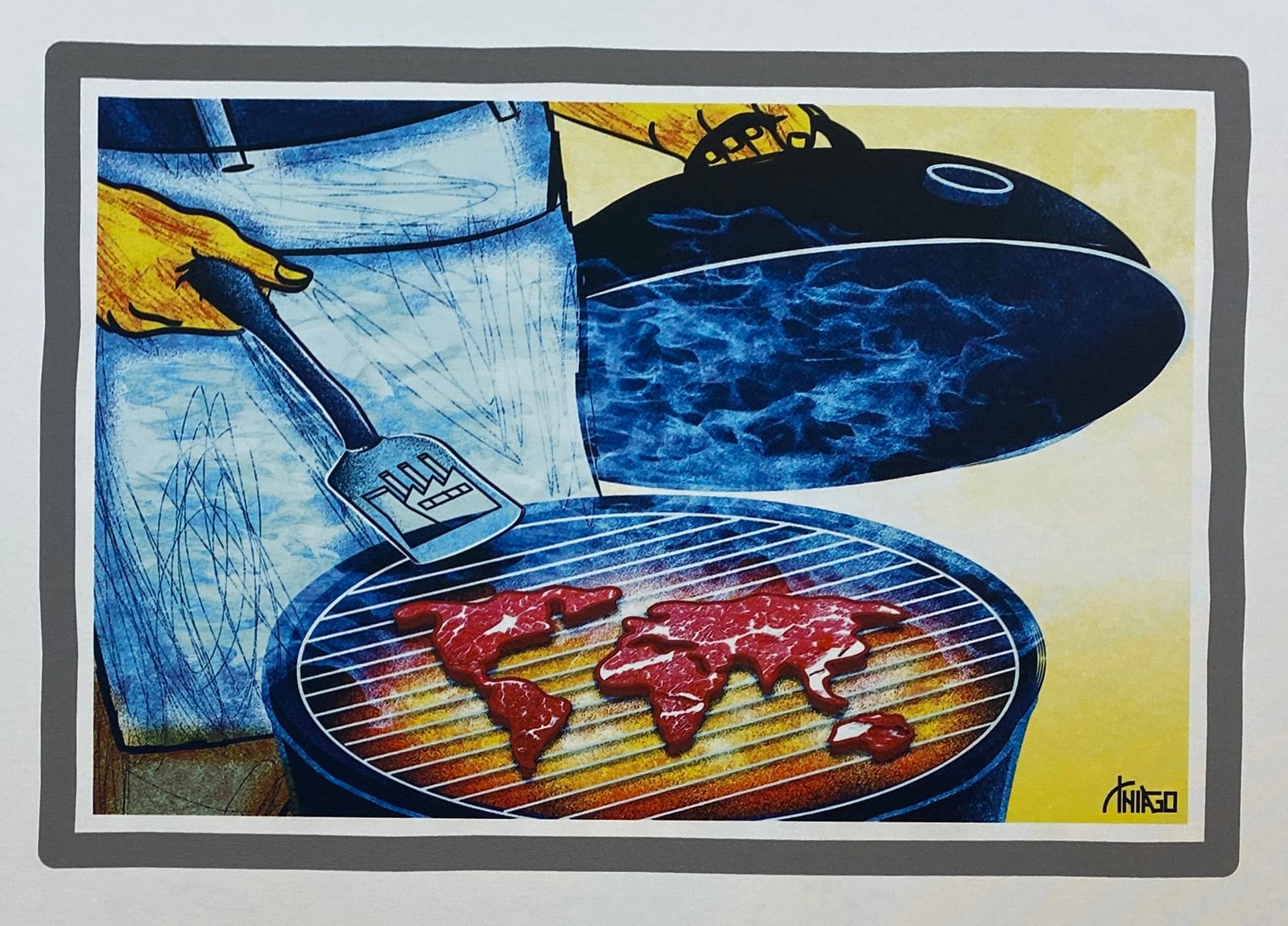

Reinder shared this cartoon by Thiago Lucas which one the European Cartoon Award.
The absence of New Zealand from the map may be a cartographic omission or it might be one more reason to take refuge there.
-
sur Sean Gillies: What the fuck!
Publié: 6 November 2024, 6:35pm CET
I knew that a second Trump presidency was very possible, but I'm still surprised that most American voters chose this sociopath. It's super disturbing to see the veneer of decency entirely stripped away from this country. Apparently, this really is who we are.
-
sur Mappery: Arles photography exhibition
Publié: 6 November 2024, 11:00am CET
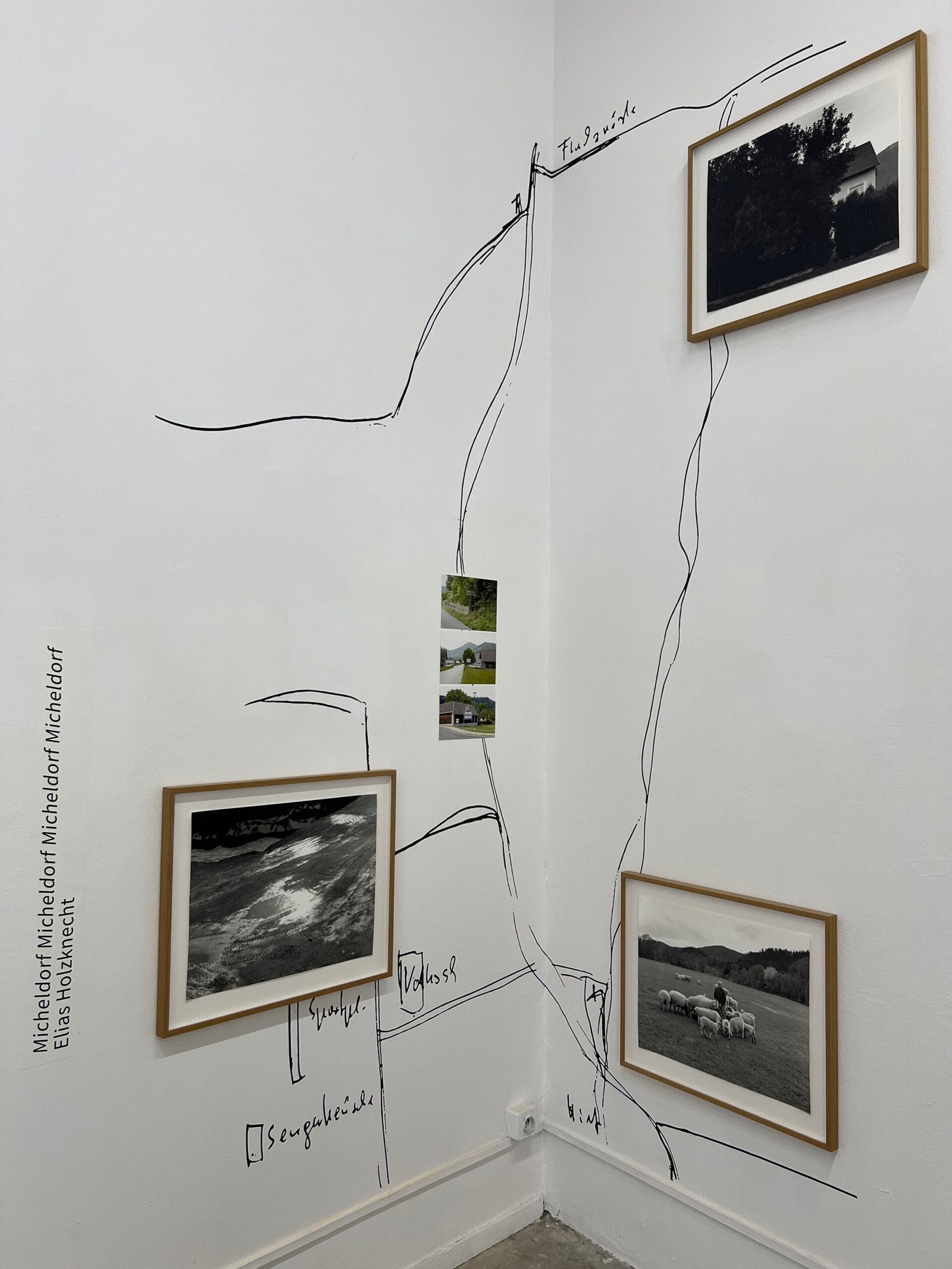

Seen at Arles Photography Exhibition 2024
-
sur PostGIS Day – 21 novembre 2024
Publié: 6 November 2024, 9:29am CET par Caroline Chanlon
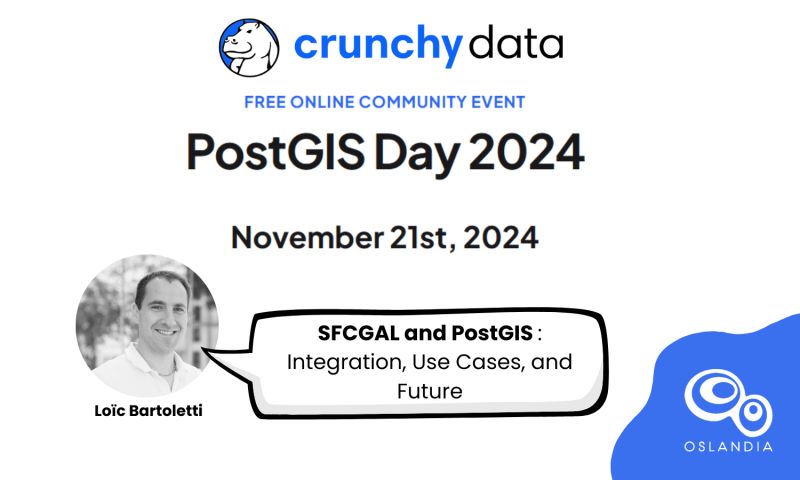
Le PostGIS Day est un événement clé de la « Geography Awareness Week ». Organisé par Crunchy Data, il permet de mettre en évidence les caractéristiques et les utilisations de la base de données spatiale PostGIS en tant qu’élément de l’écosystème SIG.
Cette journée en ligne est l’occasion d’apprendre comment d’autres utilisent PostGIS, de recueillir des conseils et de partager des bonnes pratiques.
Loïc Bartoletti animera une présentation sur SFCGAL et PostGIS : Intégration, cas d’utilisation et avenir.
Plus d’infos : [https:]]
-
sur [Story] Oslandia x QWC : épisode 5 / 8
Publié: 31 October 2024, 6:42am CET par Caroline Chanlon

Nous avons récemment détaillé les ajouts fonctionnels génériques qui ont été intégrés directement dans le cœur de QWC.
Mais parfois, certains développements ne sont pas publiés !
En effet, en plus de ces ajouts aux dépôts de QWC, nous avons également développé certaines fonctionnalités spécifiques pour nos clients, qui n’ont pas forcément leur place dans ces dépôts, étant donné qu’elles ne peuvent être applicables à n’importe quel utilisateur de QWC.
De façon générale, lorsque nous analysons une demande client, nous distinguons parmi les fonctionnalités à développer, celles qui sont génériques et celles qui sont spécifiques. Oslandia veille à contribuer “upstream” toutes les fonctionnalités génériques, afin qu’elles participent à l’enrichissement du bien commun, et qu’elles favorisent la dynamique opensource de mutualisation des projets.
À l’inverse, les fonctionnalités spécifiques sont gardées sur des dépôts privés pour le client, même si elles sont opensource : il n’y a pas d’intérêt à les publier, et elles ont souvent une adhérence à un SI particulier, ou une structure de données particulière.
C’est ainsi que nous avons développé un service de parcours de réseau d’eau potable pour détecter des fuites d’eau ou des incidents, un service de recherche utilisant PostgreSQL Full Text Search, ou une recherche sur des données cadastrales. Ces fonctionnalités sont intégrées dans les applications pour nos clients, et bénéficient des apports précédemment réalisés dans le cœur de QWC.
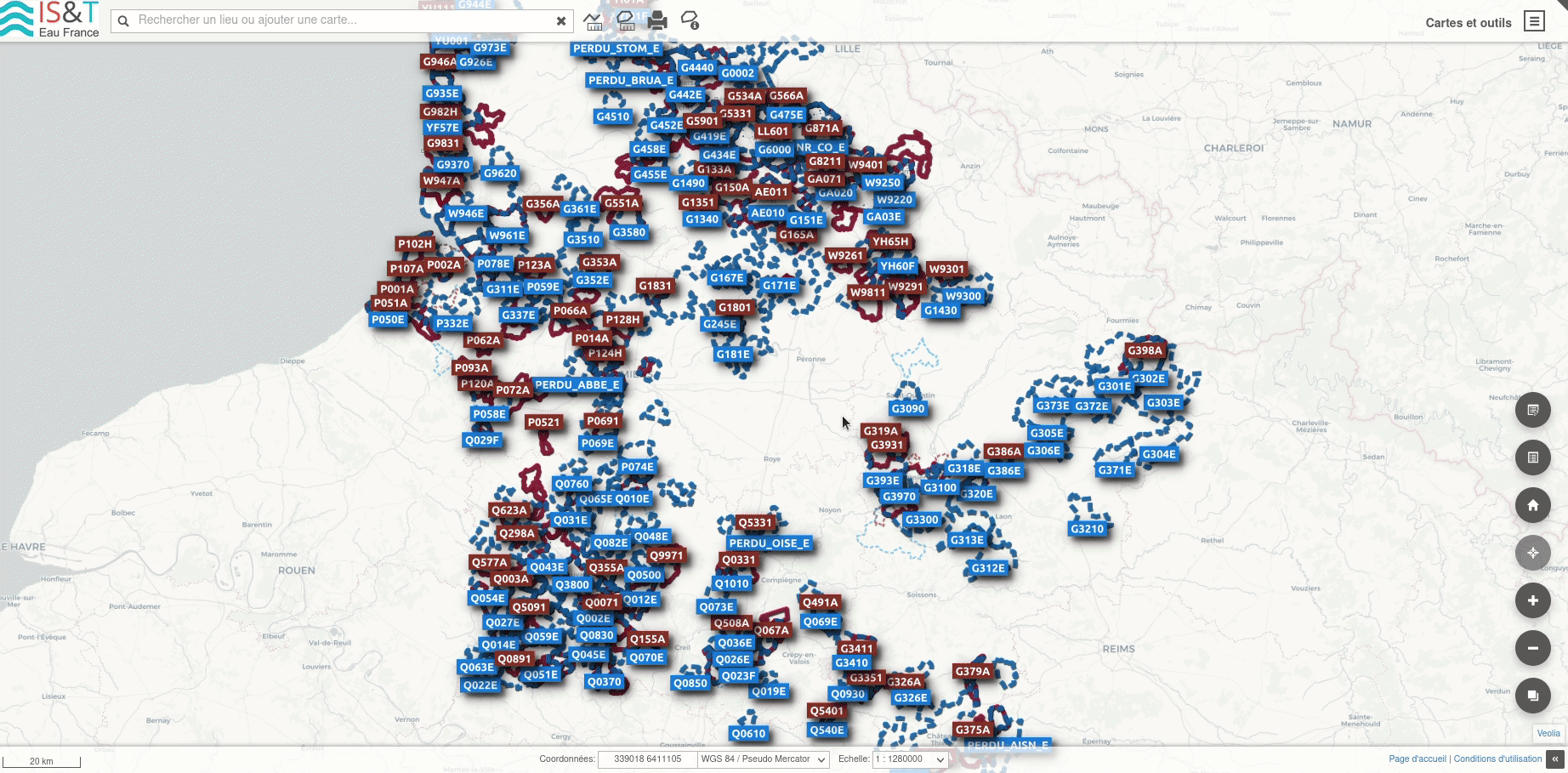
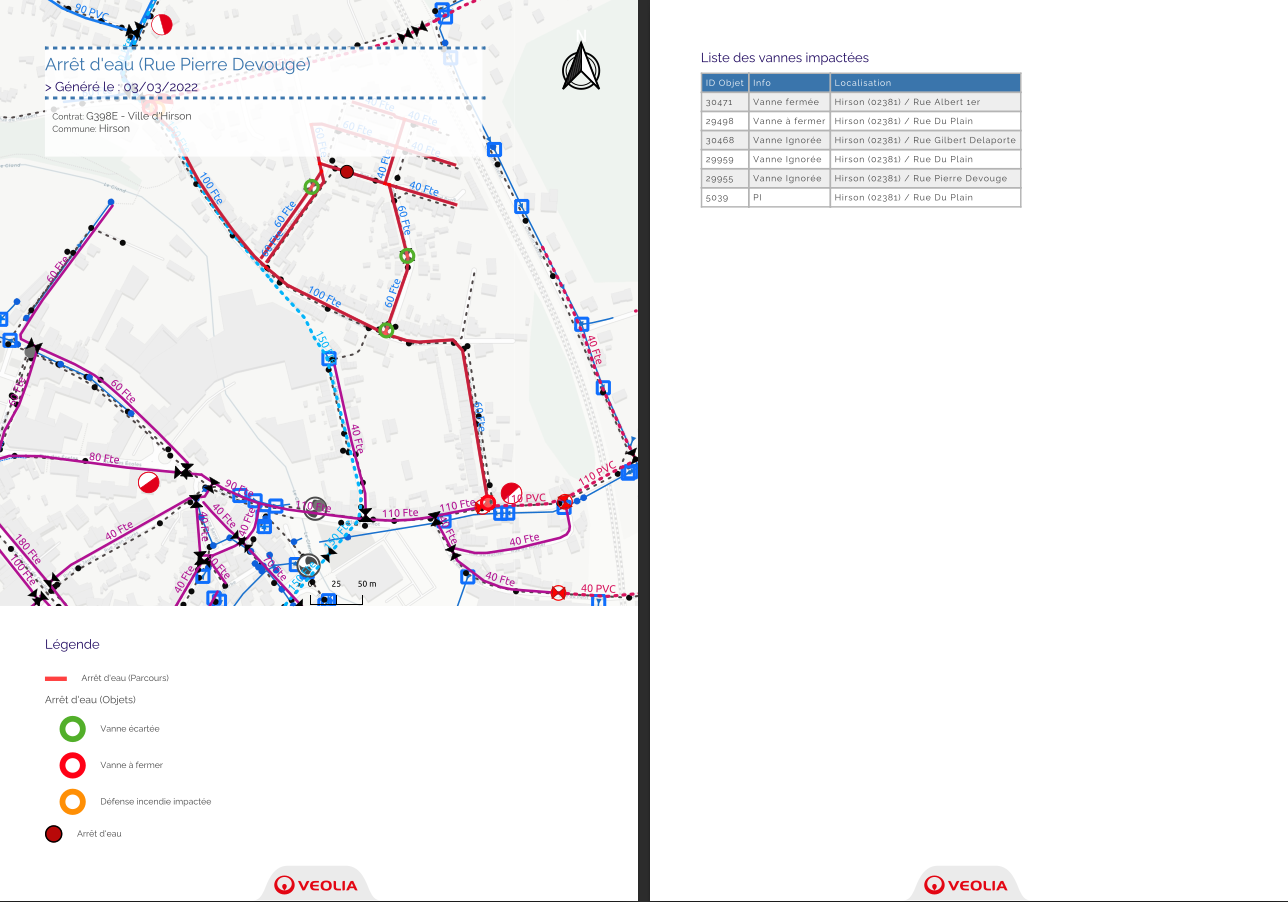
Vous pouvez nous contacter pour toute demande spécifique de développement dans QWC, autant que pour du développement cœur !
-
sur Fernando Quadro: Etapas básicas para criar seu WebGIS
Publié: 30 October 2024, 2:00pm CET
A melhor prática para criar um sistema WebGIS é armazenar todos os seus dados espaciais em um servidor PostgreSQL habilitado para PostGIS. Garanta que a indexação espacial seja aplicada para recuperação de dados mais rápida.
Você pode facilmente construir uma interface intuitiva e amigável usando HTML básico, CSS, Bootstrap e JavaScript.
Use Leaflet ou OpenLayers como sua biblioteca de mapeamento padrão!
Para filtrar dados ou executar consultas, siga estas etapas:
 Colete a entrada do usuário e envie-a para seu script de backend por meio de uma solicitação AJAX.
Colete a entrada do usuário e envie-a para seu script de backend por meio de uma solicitação AJAX.
 Valide a entrada no backend e busque os dados necessários do banco de dados PostgreSQL usando consultas SQL.
Valide a entrada no backend e busque os dados necessários do banco de dados PostgreSQL usando consultas SQL.
 Prepare os dados no backend e envie-os de volta para o cliente (interface do usuário).
Prepare os dados no backend e envie-os de volta para o cliente (interface do usuário).
 O cliente receberá os dados por meio da mesma chamada AJAX e os formatará em camadas Leaflet. AJAX é assíncrono.
O cliente receberá os dados por meio da mesma chamada AJAX e os formatará em camadas Leaflet. AJAX é assíncrono.
 Estilize suas camadas de forma eficaz usando funções JavaScript.
Estilize suas camadas de forma eficaz usando funções JavaScript.
 Exiba as camadas no mapa.
Exiba as camadas no mapa.
 Ajuste automaticamente a visualização do mapa para se ajustar à extensão do recurso pesquisado.
Ajuste automaticamente a visualização do mapa para se ajustar à extensão do recurso pesquisado.
 Adicione-os a um controle de camada para alternar a visibilidade entre ligado e desligado.
Adicione-os a um controle de camada para alternar a visibilidade entre ligado e desligado.
 Crie dicas de ferramentas ou pop-ups para exibir informações detalhadas.
Crie dicas de ferramentas ou pop-ups para exibir informações detalhadas.
 Se o usuário pesquisar por um único recurso, desenhe um círculo, linha ou polígono ao redor dele e amplie o recurso.
Se o usuário pesquisar por um único recurso, desenhe um círculo, linha ou polígono ao redor dele e amplie o recurso.Estas são as etapas básicas para exibir dados em um sistema WebGIS.
Gostou desse post? Conte nos comentários

Fonte: webgis.tech
Instagram: [https:]]
LinkedIn: [https:]] -
sur GeoTools Team: GeoTools 31.4 Released
Publié: 30 October 2024, 1:21pm CET
GeoTools 31.4 released The GeoTools team is pleased to announce the release of the latest maintenance version of GeoTools 31.4: geotools-31.4-bin.zip geotools-31.4-doc.zip geotools-31.4-userguide.zip geotools-31.4-project.zip This release is also available from the OSGeo Maven Repository and is made in conjunction with -
sur Mappery: Where’s this?
Publié: 30 October 2024, 11:00am CET
Pièce jointe: [télécharger]

Marc-Tobias asked “Is this a map (in the wild)? If so of what?”
The answer is Michigan, US and apparently they celebrate something called Plaidurday (massive bonus points to me for working this out). I am going to mark my calendar for next year and wear a check shirt.
-
sur Capitole du Libre – Toulouse
Publié: 30 October 2024, 7:45am CET par Caroline Chanlon
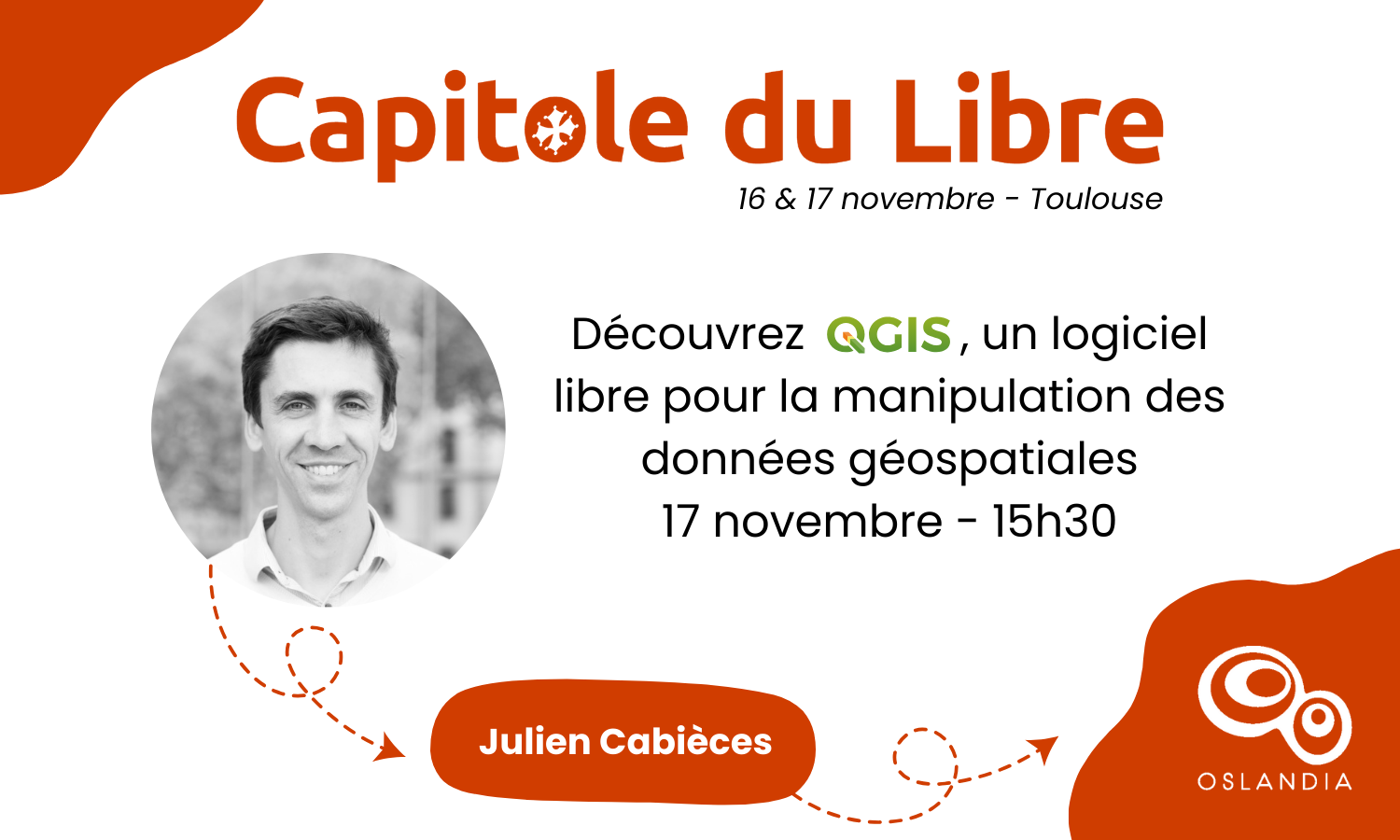
L’édition 2024 du Capitole du Libre se tiendra les 16 et 17 novembre à l’INP-N7, en centre ville de Toulouse. Ce week-end, dédié au logiciel libre à travers environ 100 conférences et 25 ateliers pour les expert?e?s et le grand public, a accueilli 1500 participant?e?s en 2023 !
Julien Cabièces animera la présentation « Découvrez QGIS, un logiciel libre pour la manipulation des données géospatiales. » RDV le 17 novembre à 15:30
Plus d’infos et inscription [gratuite] : [https:]]
-
sur Fernando Quadro: Por que utilizar um WebGIS?
Publié: 29 October 2024, 2:00pm CET
Porque mais e mais empresas estão migrando para publicar seus produtos e serviços como WebGIS ou disponibilizando seus dados e funcionalidades pela web.
Essa mudança faz parte da tendência mais ampla conhecida como “GIS moderno”.
A mudança para o WebGIS oferece benefícios significativos.
 Aqui estão as principais vantagens do WebGIS:
Aqui estão as principais vantagens do WebGIS:1. Alcance um público mais amplo: os aplicativos WebGIS podem ser acessados ??globalmente por qualquer pessoa com uma conexão de internet, simplesmente usando uma URL.
2. Nenhuma instalação necessária: como o WebGIS é baseado em navegador e os navegadores geralmente são pré-instalados na maioria dos dispositivos, os usuários podem acessar os aplicativos instantaneamente sem a necessidade de instalação complexa de software.
3. Compatibilidade entre plataformas: o WebGIS funciona perfeitamente em todos os sistemas operacionais (Windows, Mac, Linux, etc.) usando navegadores da web padrão.
4. Custos mais baixos: as empresas podem reduzir despesas usando infraestrutura de nuvem e evitando ou reduzindo a necessidade de licenças de software caras.
5. Colaboração em tempo real: vários usuários podem interagir com os mesmos dados simultaneamente, permitindo colaboração em tempo real de diferentes locais.
6. Atualizações instantâneas: quaisquer atualizações ou alterações nos aplicativos podem ser disponibilizadas imediatamente para todos os usuários, sem exigir atualizações manuais ou reinstalações — basta atualizar o navegador.
7. Mais fácil para usuários não técnicos/não GIS: os aplicativos WebGIS geralmente oferecem interfaces intuitivas, tornando-os acessíveis até mesmo para especialistas não GIS que precisam executar tarefas específicas.
8. Escalabilidade: as soluções WebGIS podem ser dimensionadas facilmente para lidar com cargas de dados crescentes e demandas do usuário, fornecendo flexibilidade para empresas em crescimento.
O WebGIS ajuda as empresas a fornecer serviços e aplicativos com tecnologia GIS de forma mais eficaz, tornando-os acessíveis, eficientes e fáceis de usar para seus clientes e empresas.
Gostou desse post? Conte nos comentários

Fonte: webgis.tech
Instagram: [https:]]
LinkedIn: [https:]] -
sur Mappery: Glacier National Park
Publié: 29 October 2024, 11:00am CET
Pièce jointe: [télécharger]
-
sur GeoServer Team: GeoServer 2.25.4 Release
Publié: 29 October 2024, 2:00am CET
GeoServer 2.25.4 release is now available with downloads (bin, war, windows), along with docs and extensions.
This is a maintenance release of GeoServer providing existing installations with minor updates and bug fixes. GeoServer 2.25.4 is made in conjunction with GeoTools 31.4, and GeoWebCache 1.25.3.
Thanks to Jody Garnett for making this release.
Security ConsiderationsThis release addresses security vulnerabilities and is considered an important upgrade for production systems.
- GEOS-11557 CVE-2024-45748 High
See project security policy for more information on how security vulnerabilities are managed.
Release notesNew Feature:
- GEOS-11352 REST service for URL checks
Improvement:
- GEOS-11399 Use Catalog streaming API in LayerGroupPage
- GEOS-11427 metadata: “fix all” to support changing config repeatable field
- GEOS-11463 WMS vector dimension validation should query only one feature and only for dimension attribute
- GEOS-11502 Permit resize on user/group/role palette textbox to allow for extra long role names
- GEOS-11503 Update mongo schemaless DWITHIN to support non-point geometry
- GEOS-11557 CVE-2024-45748 High
- GEOS-11588 GWC disk quota, check JDBC connection pool validation query
Bug:
- GEOS-10811 GeoServer 2.22.0 WPS error while clipping raster with GeoJSON input
- GEOS-11071 GeoJSON PPIO goes NPE while decoding a GeoJSON geometry
- GEOS-11107 Open search for EO community module: packaging missing gt-cql-json-xx.x.jar
- GEOS-11453 Failure to look-up default value of custom dimensions on vector layers
- GEOS-11484 DirectRasterRenderer is not respecting advancedProjectionHandling and continuosMapWrapping format_options
- GEOS-11493 Azure blob store may not get environment parameters from property file
- GEOS-11497 WPS execution fails with GeoJSON input
- GEOS-11504 ResourceAccessManagerWrapper misses some delegating methods
- GEOS-11505 OWS Monitor only handles WFS 1.0 requests
- GEOS-11513 WMTS/GetDomainValues - Returned values are not sorted
- GEOS-11514 Fix parsing WPS geometry geojson inputs
- GEOS-11524 csw: default queryables mapping not generated
- GEOS-11543 Unable to use propertyName to filter properties in a GetFeature request when service is not set
- GEOS-11553 SLD Style: Empty SE Rotationelement throws RuntimeException (QGIS generated SLD)
- GEOS-11556 NullPointerException when GWC disk quota monitoring is disabled
- GEOS-11559 The customized attributes editor is prone to setting the wrong attribute source
Task:
- GEOS-11470 Upgrade the version of Mongo driver for schemaless plugin from 4.0.6 to 4.11.2
- GEOS-11506 Upgrade Spring version from 5.3.37 to 5.3.39 and Spring security from 5.8.13 to 5.8.14
- GEOS-11508 Update OSHI from 6.4.10 to 6.6.3
- GEOS-11533 Update org.apache.commons.vfs2 to 2.9.0
- GEOS-11574 Bump org.eclipse.jetty:jetty-server from 9.4.52.v20230823 to 9.4.55.v20240627 in /src
- GEOS-11587 Update map fish-print-v2 2.3.2
For the complete list see 2.25.4 release notes.
Community UpdatesCommunity module development:
- GEOS-11517 Using various OGC APIs results in service enabled check related WARN logs
- GEOS-11518 DGGS JDBC store SQL encoder should not force the timezone to CET
- GEOS-11519 Make DGGS rHealPix tests run again
- GEOS-11560 OGC API modules lack cql2-json in assembly
- GEOS-11563 Allow configuring a DGGS resolution offset on a layer basis
- GEOS-11565 Allow configuring the minimum and maximum DGGS resolution for a layer
- GEOS-11579 DGGS modules prevent GeoServer startup if JEP is not installed
Community modules are shared as source code to encourage collaboration. If a topic being explored is of interest to you, please contact the module developer to offer assistance.
About GeoServer 2.25 SeriesAdditional information on GeoServer 2.25 series:
- GeoServer 2.25 User Manual
- GeoServer 2024 Roadmap Plannings
- Raster Attribute Table extension
- Individual contributor clarification
Release notes: ( 2.25.4 | 2.25.3 | 2.25.2 | 2.25.1 | 2.25.0 | 2.25-RC )
-
sur EOX' blog: EOX IT Services GmbH at Intergeo Expo 2024
Publié: 29 October 2024, 2:00am CET
Intergeo 2024 is one of the world’s leading expos for geospatial solutions, bringing together professionals, innovators, and thought leaders from across the globe. Held this year in Stuttgart, Germany, the event provided a perfect platform for industry experts to showcase the latest advancements in ... -
sur Fernando Quadro: Interação entre Temperatura e Fluxos oceânicos com IA e GIS
Publié: 28 October 2024, 2:00pm CET
A combinação de Inteligência Artificial (IA) e Sistemas de Informação Geográfica (GIS) pode transformar nossa compreensão dos oceanos e suas dinâmicas. Aqui estão algumas formas de como essa interação entre temperatura e fluxos oceânicos pode ser otimizada com essas tecnologias:
 Monitoramento em Tempo Real: Usando sensores e dados via satélite, o GIS pode mapear padrões de temperatura oceânica e fluxos em tempo real, enquanto a IA analisa grandes volumes de dados para prever mudanças futuras.
Monitoramento em Tempo Real: Usando sensores e dados via satélite, o GIS pode mapear padrões de temperatura oceânica e fluxos em tempo real, enquanto a IA analisa grandes volumes de dados para prever mudanças futuras.  Previsões Climáticas Precisas: A IA é capaz de identificar padrões históricos de temperatura e fluxo oceânico para criar modelos preditivos, ajudando a antecipar fenômenos como o El Niño ou a La Niña, além de mudanças em correntes oceânicas.
Previsões Climáticas Precisas: A IA é capaz de identificar padrões históricos de temperatura e fluxo oceânico para criar modelos preditivos, ajudando a antecipar fenômenos como o El Niño ou a La Niña, além de mudanças em correntes oceânicas. Gestão de Riscos e Desastres: Previsões aprimoradas permitem uma melhor gestão de riscos para eventos climáticos extremos, como tempestades ou inundações, dando tempo para se preparar e minimizar impactos.
Gestão de Riscos e Desastres: Previsões aprimoradas permitem uma melhor gestão de riscos para eventos climáticos extremos, como tempestades ou inundações, dando tempo para se preparar e minimizar impactos. Otimização de Rotas Marítimas: Com o uso de GIS e IA, é possível otimizar rotas de transporte marítimo, aproveitando correntes oceânicas e temperaturas favoráveis, economizando combustível e reduzindo emissões.
Otimização de Rotas Marítimas: Com o uso de GIS e IA, é possível otimizar rotas de transporte marítimo, aproveitando correntes oceânicas e temperaturas favoráveis, economizando combustível e reduzindo emissões. Conclusão: A combinação de IA e GIS na análise de temperatura e fluxos oceânicos oferece uma visão mais profunda e preditiva do comportamento dos oceanos, essencial para a gestão ambiental, segurança e planejamento climático.
Conclusão: A combinação de IA e GIS na análise de temperatura e fluxos oceânicos oferece uma visão mais profunda e preditiva do comportamento dos oceanos, essencial para a gestão ambiental, segurança e planejamento climático.Fonte: webgis.tech
Instagram: [https:]]
LinkedIn: [https:]] -
sur Mappery: Bokhoven Mosaic
Publié: 28 October 2024, 11:00am CET


Garett Speed shared this nice mosaic map “another tile mosaic, this one is in the middle of the village Bokhoven in Noord Brabant, the Netherlands”
-
sur Mappery: Map on Beer
Publié: 27 October 2024, 11:00am CET
Pièce jointe: [télécharger]
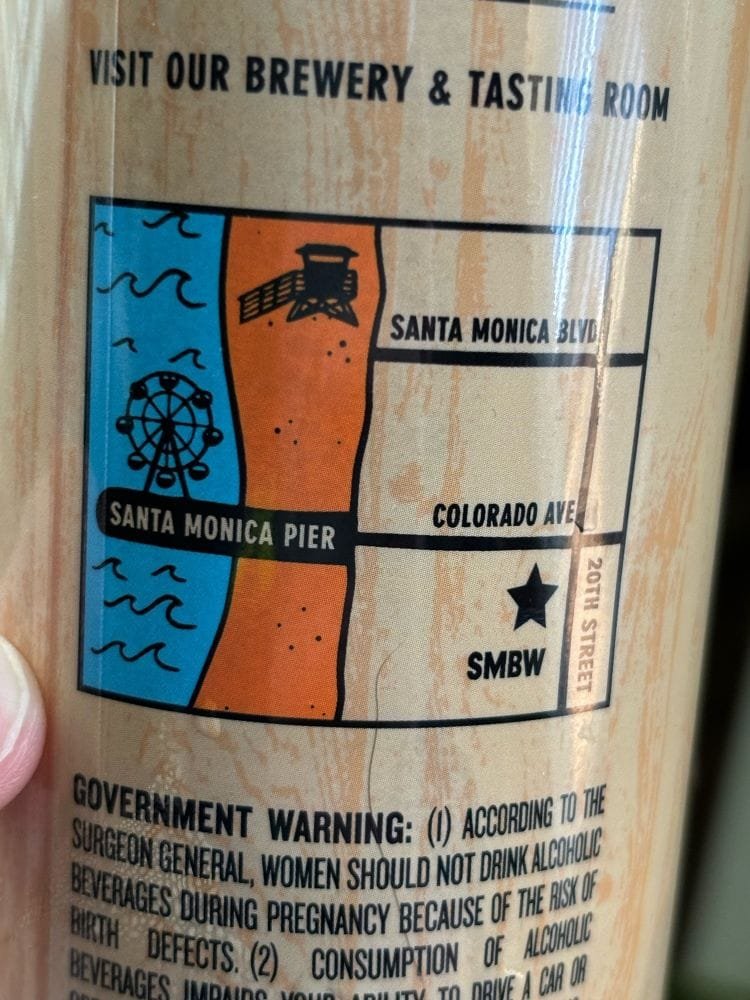
“What’s better than a map to beer?” said SHPMafia
-
sur Mappery: From here you can see
Publié: 26 October 2024, 1:00pm CEST


Andy McIntire shared this with us “Here’s a map I found a few days ago at a rest stop in southern Maryland, right where all the lines on the map join.”
-
sur Mappery: Contoured Neck Warmer
Publié: 25 October 2024, 1:00pm CEST
Pièce jointe: [télécharger]
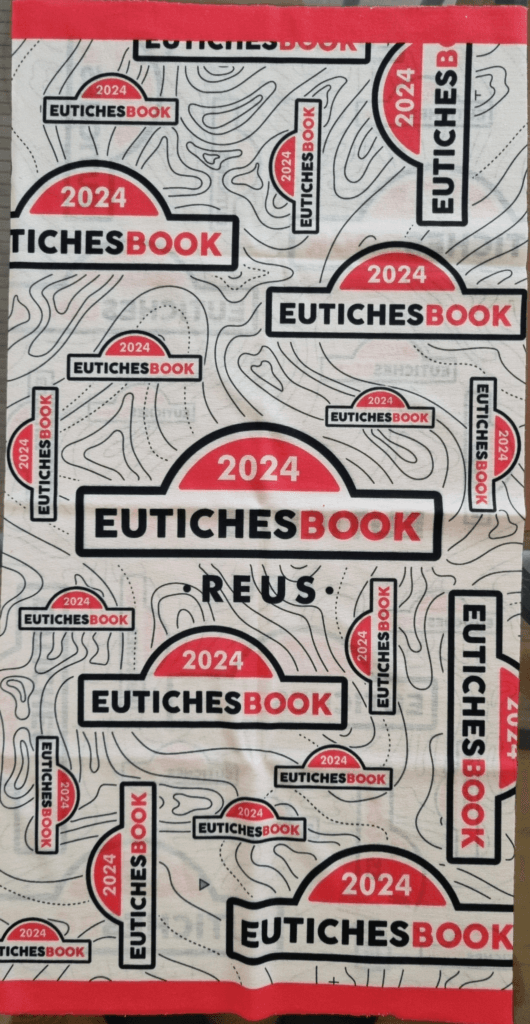
Raf shared this, he said “Neck warmer handed out to participants at the 2024 Eutiches OnRoad motorbike rideout has a contour line vibe”
This looks like fun if you are a motorbike owner.
-
sur Du nouveau pour [CityBuilder] CityForge
Publié: 25 October 2024, 8:56am CEST par Caroline Chanlon

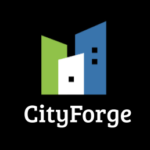 Nous vous présentions en mars CityBuilder, un plugin QGIS qui avait pour objectif de reconstituer les bâtiments 3D à partir d’un fichier nuage de points et d’emprises de bâtiments.
Nous vous présentions en mars CityBuilder, un plugin QGIS qui avait pour objectif de reconstituer les bâtiments 3D à partir d’un fichier nuage de points et d’emprises de bâtiments.
L’été fini, le temps des grandes résolutions et des grands changements est là : CityBuilder fait peau neuve et se nomme désormais CityForge ! Le projet GitLab est renommé, mais l’ancienne adresse continue de fonctionner.Pour ce qui est de l’objectif, il reste le même. Nous en avons même profité pour ajouter quelques fonctionnalités :
- L’utilisation des couches natives QGIS : spécifiez vos couches d’emprise et de nuages de points, l’algorithme se chargera du reste,
- La prise en compte automatique du CRS des couches chargées : si vos couches ont le même CRS, le CityJSON généré aura celui de vos couches; sinon une erreur vous sera remontée,
- Possibilité de générer uniquement le LOD2.2 : pour des fichiers moins volumineux,
- Le plugin est désormais disponible en français et en anglais, selon la langue de votre QGIS
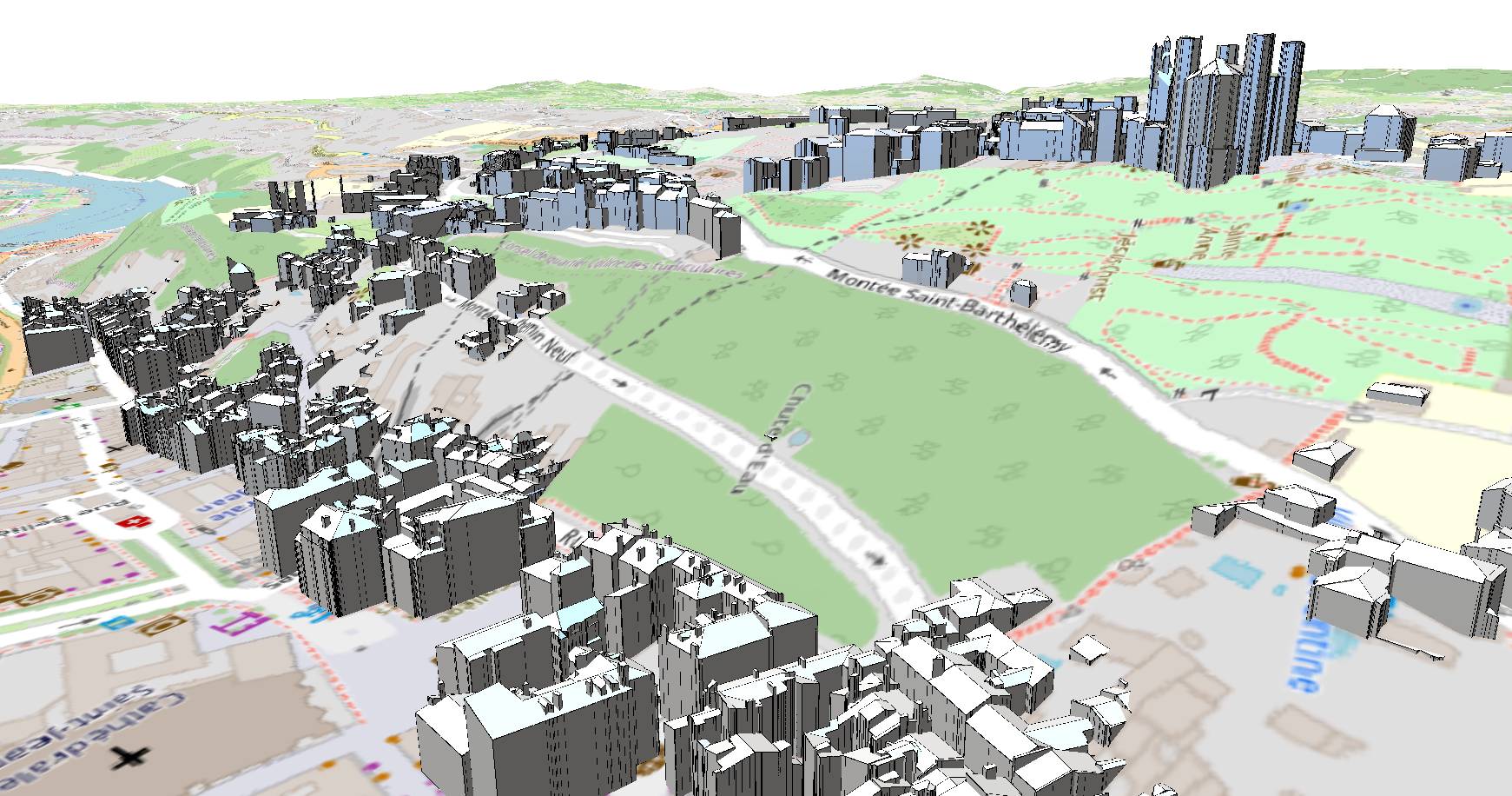
Côté code, l’ajout d’une Intégration Continue (CI) améliore également le processus de développement et de publication de nouvelles versions.
La suiteOutre la maintenance, la prochaine étape est la publication du plugin dans le dépôt des plugins QGIS, ce qui devrait être une formalité étant donné l’utilisation du QGIS Plugin templater.
Dans le cadre du projet Cloud Platform for Smart Cities aux côté d’Eviden, nous nous concentrons également sur l’industrialisation et le passage à l’échelle de la chaîne de traitement. En particulier, nous travaillons d’une part à l’automatisation du traitement via Dagster (avec toujours Geoflow sous le capot), et à l’optimisation du format de sortie pour gérer des données encore plus massives dans le web avec Giro3D et Piero. On vous en reparlera prochainement !
Ce projet est financé par l’Union européenne – Next Generation EU dans le cadre du plan France Relance.
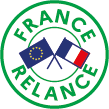
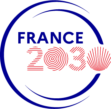
-
sur Fernando Quadro: Análises Espaciais nas Estratégias de Negócio
Publié: 24 October 2024, 4:00pm CEST
Vivemos em uma era onde a informação é o novo petróleo. Mas, como extrair valor dessa vastidão de dados disponíveis? A resposta está na interseção entre tecnologia e geografia: o mapeamento, o sensoriamento remoto e as análises espaciais. Estes recursos não são apenas ferramentas sofisticadas, mas sim catalisadores de transformação estratégica para os negócios. Vamos explorar o porquê.
 Mapeamento: Visualizando Oportunidades
Mapeamento: Visualizando OportunidadesO mapeamento permite visualizar dados geográficos de forma intuitiva, transformando informações complexas em insights claros e acionáveis. Imagine conseguir identificar novas oportunidades de mercado simplesmente observando a distribuição geográfica dos seus clientes! Isso proporciona uma vantagem competitiva inestimável, permitindo decisões mais precisas e eficazes.
 Sensoriamento Remoto:
Sensoriamento Remoto:Com o sensoriamento remoto, temos a capacidade de monitorar e analisar grandes áreas em tempo real, utilizando imagens de satélite e drones. Isso é particularmente valioso para setores como agricultura, mineração e gestão de recursos naturais, onde cada centímetro conta. Através dessas tecnologias, empresas podem aumentar sua eficiência operacional e minimizar impactos ambientais, promovendo um desenvolvimento mais sustentável.
 Análises Espaciais a Cereja do Bolo para Decisões Inteligentes e Estratégicas:
Análises Espaciais a Cereja do Bolo para Decisões Inteligentes e Estratégicas:As análises espaciais vão além do simples mapeamento. Elas integram diferentes camadas de dados para revelar padrões escondidos e prever tendências. Seja na otimização de rotas de logística, na escolha de novos pontos de venda ou na mitigação de riscos ambientais, as análises espaciais oferecem uma perspectiva especializada que se fundamenta em dados concretos que são essenciais para análises e tomadas de decisão fundamentadas em evidências.
 Transformação Digital e Competitividade:
Transformação Digital e Competitividade:Empresas que adotam essas tecnologias ganham um diferencial competitivo significativo, sendo capazes de responder rapidamente às mudanças do mercado e antecipar demandas. Profissionais especializados nessas áreas são fundamentais para aproveitar ao máximo essas ferramentas, e valorizá-los é essencial para o sucesso e melhoria contínua.
 O Futuro Está Aqui
O Futuro Está AquiSe você ainda não considerou essas ferramentas e profissionais da área como parte da sua estratégia, o momento é agora. Com o investimento e a popularização dessas tecnologias em diversos setores, o diferencial competitivo se torna claro. Invista em tecnologia, inteligência espacial e veja seu negócio alcançar novos patamares de sucesso.
A inovação e seus benefícios podem estar “no agora” e você e sua empresa também podem estar!
Fonte: Danielle Gomes
Gostou desse post? Conte nos comentários

-
sur Mappery: Map Mural in Nova Scotia
Publié: 24 October 2024, 1:00pm CEST
Pièce jointe: [télécharger]

Doug shared this superb urban map mural. “Mural on building showing local rivers. Annapolis Royal, Nova Scotia”
-
sur [Équipe Oslandia] Benoit Ducarouge, ingénieur SIG et chef de projet
Publié: 24 October 2024, 8:19am CEST par Caroline Chanlon
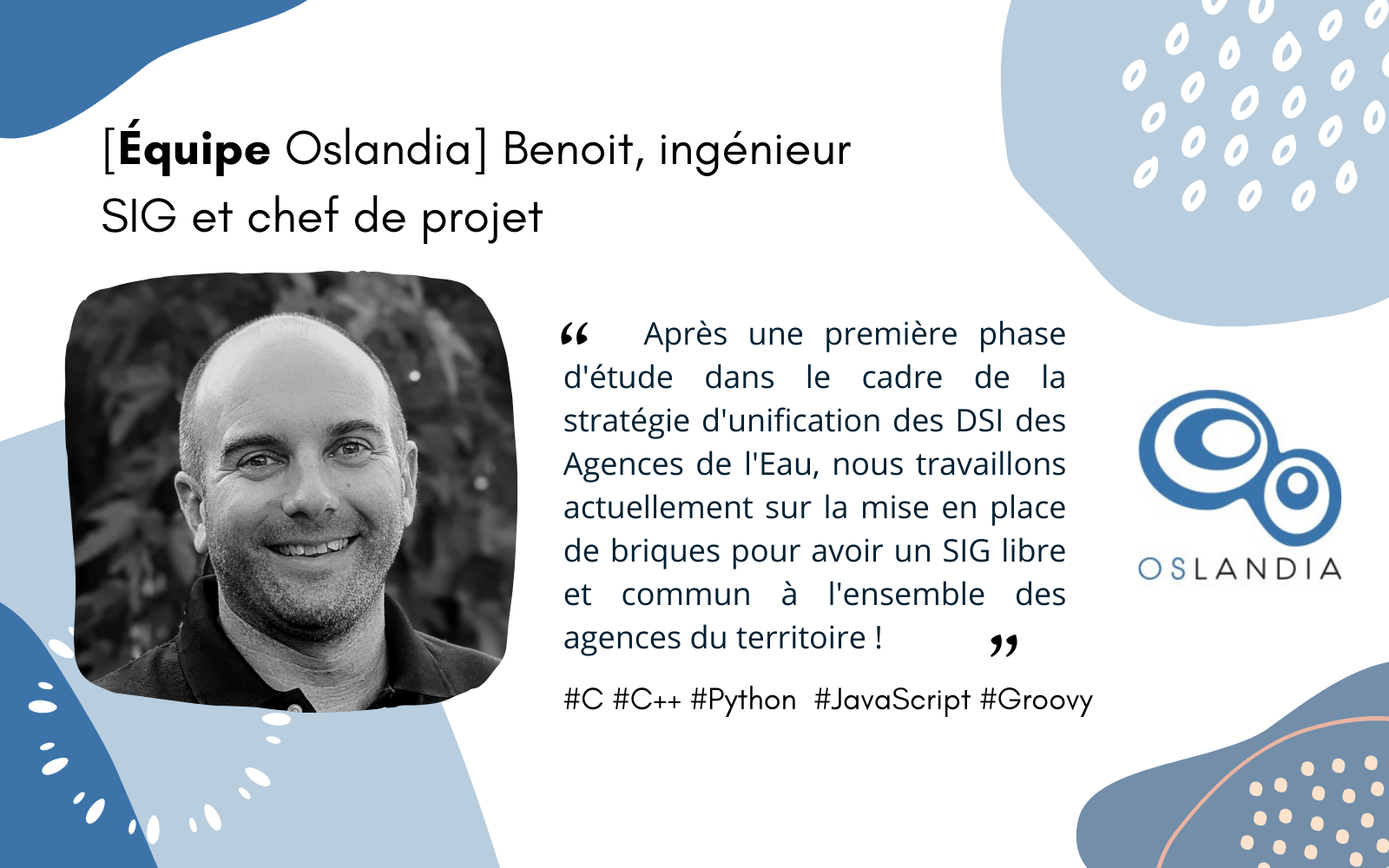
Benoit est diplômé de l’École d’Ingénieurs ISEN Méditerranée – Institut Supérieur de l’Électronique et du Numérique avec une spécialisation en dernière année en Méca Infotronique (notre Robotique aujourd’hui !)
Il réalise son stage de fin d’année dans un laboratoire à Toulouse, le LAAS du CNRS (Laboratoire d’Analyse et d’Architecture des Systèmes) et poursuit son cursus dans ce même laboratoire avec une thèse sur la reconstruction 3D infrarouge par perception active.
Ayant des envies de voyages et de découvrir autre chose, il quitte la France pour la Nouvelle Calédonie où il termine la rédaction de sa thèse.
Le manque d’opportunités en robotique en Nouvelle Calédonie, invitent Benoit à s’orienter vers un autre secteur. Il rejoint une start-up dans le domaine de l’aide à la décision en environnement et y travaille pendant 5 ans.
« Je devais travailler sur une plateforme SIG intégrant des traitements d’images satellite, un domaine que je ne connaissais pas du tout mais auquel j’ai rapidement pris goût »
Après cette expérience, il intègre le service SIG de la province Sud (fonction publique calédonienne). Où il a notamment pour mission d’intégrer les SIG aux applications métiers des agents instructeurs qui ne sont pas géomaticiens.
Il devient responsable du SIG de la Province Sud de Nouvelle Calédonie ! et engage un projet de migration progressif vers des solutions 100% open source et notamment QGIS, QGIS Server et PostgreSQL.
« J’avais aussi pour mission de participer à l’animation de la géomatique interne de l’institution en mettant en relation les géomaticiens. J’ai aussi participé au club de la géomatique commun à toute la Nouvelle Calédonie. Ce club avait pour objectif de fédérer toutes les institutions du territoire. »
Après 10 ans en Nouvelle Calédonie, retour en France, direction le Sud Ouest en ayant au préalable et avant de boucler ses valises, réalisé un entretien chez Oslandia, à distance bien sûr !
Sortie de l’avion mi-juin, Benoit est embauché en juillet 2021 au poste d’ingénieur SIG chez Oslandia. Un poste qui a évolué au fil du temps avec en plus du développement, de la gestion de projets ainsi que la réalisation d’études et d’audits.
Projets emblématiquesBenoit a participé techniquement au Projet IGN de refonte de la Géoplateforme et a assuré la gestion de projet de l’application « Remonter le temps » qui fait partie de la Géoplateforme.
Il a également collaboré sur le Projet EDF de navigation Indoor et avec les agences de l’Eau sur leur stratégie d’unification de leur DSI.
« Après une première phase d’étude, nous travaillons actuellement sur la mise en place de briques pour avoir un SIG libre et commun à l’ensemble des agences de l’eau du territoire ! »
Technologie de prédilectionEn ce moment, c’est le Python ! mais je n’ai pas vraiment de technologies de prédilection, j’ai touché à pas mal de langages : C, C++, Groovy, JavaScript, …
Ta philosophieKeep cool en toute circonstance
Oslandia en 1 mot
Liberté !
-
sur Fernando Quadro: Melhores práticas para gerenciamento de dados geoespaciais
Publié: 23 October 2024, 4:00pm CEST
O gerenciamento eficaz de dados geoespaciais é crucial para organizações que trabalham com GIS. Inclua essas melhores práticas para maximizar o valor de seus dados geoespaciais, melhorar os processos de tomada de decisão e garantir a sustentabilidade dos dados a longo prazo.
 Estabeleça regras claras para o uso de dados
Estabeleça regras claras para o uso de dados
Certifique-se de que todos saibam como lidar com os dados. Isso mantém os dados seguros e consistentes. Crie padrões de dados
Crie padrões de dados
Crie regras sobre como coletar, armazenar e compartilhar dados. Isso ajuda todos a usar os dados da mesma maneira. Use bons sistemas de armazenamento
Use bons sistemas de armazenamento
Escolha sistemas que possam crescer com suas necessidades. O armazenamento em nuvem e bancos de dados espaciais funcionam bem para dados de mapas. Adicione detalhes sobre seus dados
Adicione detalhes sobre seus dados
Anote o que cada pedaço de dados significa. Isso ajuda as pessoas a encontrar e usar os dados certos. Faça backup dos seus dados
Faça backup dos seus dados
Faça cópias dos seus dados para mantê-los seguros. Tenha um plano para recuperar seus dados se algo der errado. Mantenha versões antigas
Mantenha versões antigas
Salve versões diferentes dos seus dados. Isso ajuda você a rastrear alterações ao longo do tempo. Combine dados cuidadosamente
Combine dados cuidadosamente
Aprenda a misturar dados de diferentes fontes. Isso lhe dá uma visão completa para melhores decisões. Faça com que os dados sejam fáceis de encontrar
Faça com que os dados sejam fáceis de encontrar
Organize seus dados para que as pessoas possam encontrar o que precisam rapidamente. Treine sua equipe
Treine sua equipe
Ensine a todos como usar os dados corretamente. Isso ajuda a evitar erros. Verifique a qualidade dos dados com frequência
Verifique a qualidade dos dados com frequência
Certifique-se regularmente de que seus dados estejam corretos e atualizados. Controle quem pode acessar os dados
Controle quem pode acessar os dados
Decida quem pode ver ou alterar diferentes tipos de dados. Isso mantém as informações confidenciais seguras. Planeje o futuro
Planeje o futuro
Pense em como suas necessidades de dados podem mudar. Certifique-se de que seu sistema pode crescer com você.Gostou desse post? Conte nos comentários

Fonte: webgis.tech
Instagram: [https:]]
LinkedIn: [https:]] -
sur Mappery: The Balkan Territory on the side of a building
Publié: 23 October 2024, 1:00pm CEST
Pièce jointe: [télécharger]

Rebecca Seifried shared this. “One of the rare murals in my humble town, adorning a wall outside the Balkan Lounge bar. Obviously not to scale, and with absolutely baffling 3D effects, I still find it charming #MapsintheWild. I feel duty-bound to commemorate it because the bar recently changed ownership – TBD what will happen to the mural!”
-
sur Les styles des features 3D dans Giro3D
Publié: 23 October 2024, 3:00am CEST par Sébastien Guimmara
Pièce jointe: [télécharger]
Cet article concerne des fonctionnalités publiées avec la version 0.38 de Giro3D.
Giro3D 0.38 a introduit une API de styles pour la représentation des features en 3D.
Que sont les features 3D ?Les features OGC (simple feature) peuvent être représentées dans Giro3D de deux façons: drapées et non-drapées.
Les features drapées sont rasterisées sur une entité Map, et utilisent les styles OpenLayers.
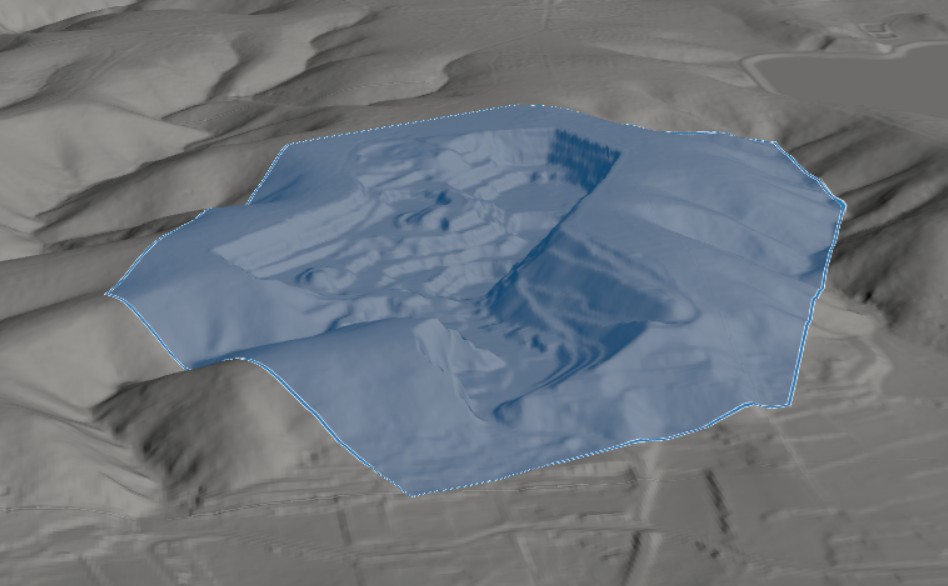
Un polygone drapé sur un terrain via l'entité Map
Les features non-drapées sont représentées par des objets 3D (lignes, points, polygones, polyhèdres…) et permettent de visualiser des features possédant une altitude ou un volume propre (par exemple des bâtiments).
Les features non-drapées sont représentées par l'entité FeatureCollection.
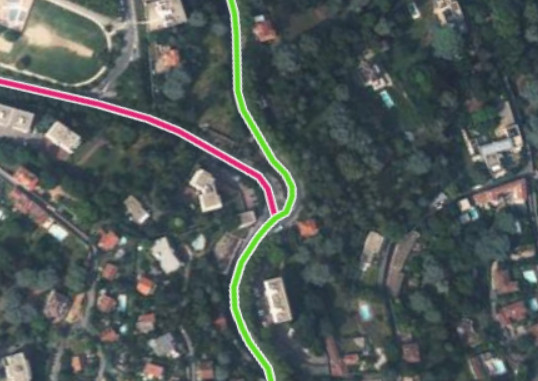
Les features drapées sont rasterisées
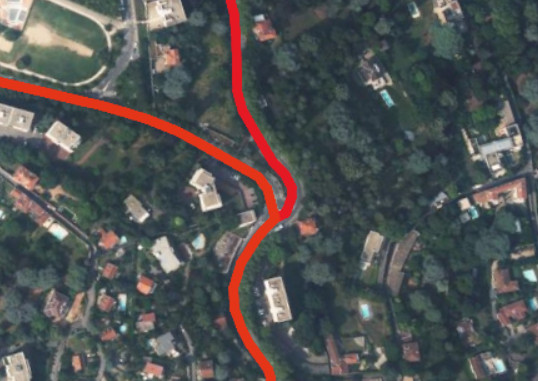
Les features non-drapées sont des objets vectoriels
Pourquoi opter pour des features non-drapées ?Par rapport à leur équivalent drapé (et donc rasterisé), les features 3D offrent un certain nombre d'avantages (mais également d'inconvénients).
Avantages-
Permet de représenter des volumes. Il s'agit bien sûr du principal avantage, car les features rastérisées sont par nature des objets 2D. Il est donc possible de représenter des bâtiments, des volumes comme des zones d'exclusion aérienne, etc.
-
Une meilleure qualité visuelle. L'absence de rastérisation garantit une qualité visuelle parfaite puisque les features sont représentées comme des objets vectoriels sans approximation dûe à la rastérisation.
-
Un usage mémoire moindre. L'absence de rastérisation permet de réduire considérablement les besoins en mémoire vidéo, car les données vectorielles sont beaucoup plus légères.
-
Plus complexe à prendre en main. Par rapport à leur équivalent 2D, les features 3D sont moins intuitives à utiliser, notamment en cas de problèmes d'affichages typique (Z-fighting par exemple).
-
Une API moins riche que son équivalent 2D. Il n'est pas (encore) possible de spécifier plusieurs styles par feature, comme il est possible de le faire dans OpenLayers, par exemple pour ajouter une bordure colorée aux lignes (en combinant 2 styles). Nous espérons faire évoluer cela et ajouter le support multi-style.
-
Ne suit pas le terrain. Le principal avantage des features drapées est qu'elles épousent parfaitement le relief (voir l'image ci-dessus). Il n'est pas possible d'obtenir un tel résultat avec des features non-drapées.
La nouvelle API de style est inspirée par l'API OpenLayers, adaptée aux contraintes des espaces 3D. Il est possible de spécifier la couleur des lignes et des surfaces, leur opacité, l'épaisseur des lignes, ainsi que les symboles à utiliser pour les features de type Point.

Des lignes de bus représentées par des features 3D
L'APILe style d'une feature est représenté par l'objet FeatureStyle, contenant un style de point (PointStyle), un style de ligne (StrokeStyle) et un style de surface (FillStyle).
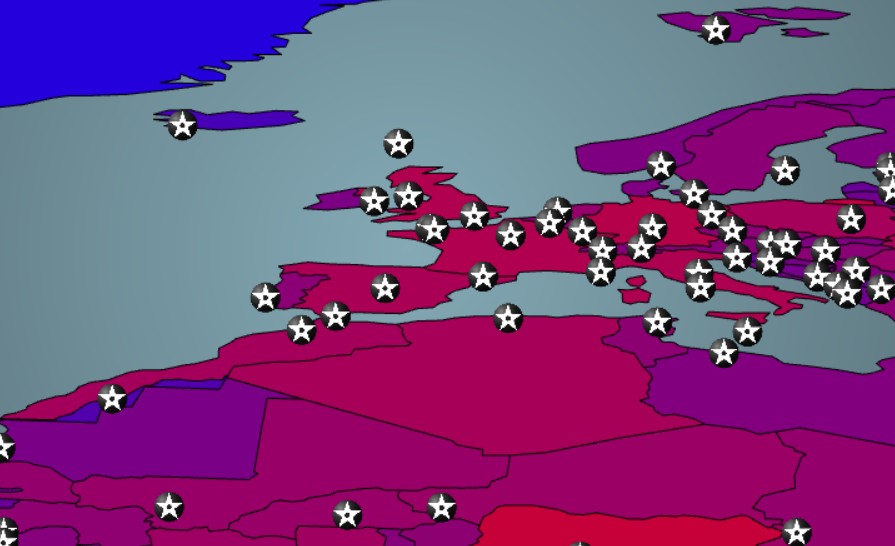
Les symboles sont affichés sous forme de _billboards_
Des styles dynamiquesIl est possible d'assigner un style différent à une feature en fonction de ses attributs. Par exemple, pour changer la couleur d'un polygone lorsque la feature est cliquée ou survolée par la souris.
Voyons un exemple.
function polygonStyle(feature) { const clicked = feature.get("clicked"); let color; if (clicked) { color = "yellow"; } else { color = "blue"; } return { fill: color, }; }Plus tard, nous pouvons modifier l'attribut de cette feature en utilisant l'API OpenLayers, puis notifier la FeatureCollection que les styles doivent être recalculés.
feature.set("clicked", true); featureCollection.updateStyles();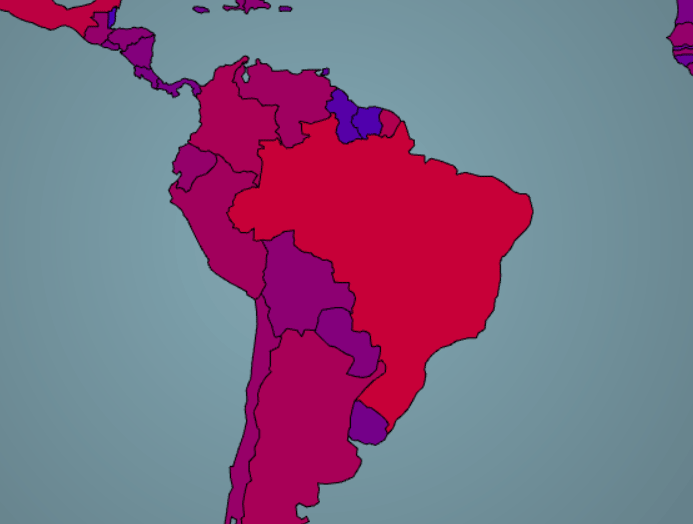
3 styles différents pour une même feature
L'extrusion de polygonesCette fonctionnalité ne fait pas à proprement parler partie de l'API de styles, car elle modifie les géométries plutôt que leur style. Néanmoins, il est intéressant de le mentionner ici.
Un cas d'usage très fréquent consiste à representer des bâtiments à partir de leur empreinte au sol (qui est généralement un Polygon ou MultiPolygon 2D). Nous pouvons utiliser le callback extrusionOffset de l'entité FeatureCollection pour renseigner la distance d'extrusion du polygone.
Dans l'exemple suivant, nous récupérons l'attribut height de la feature pour en faire une distance d'extrusion.
function extrusionOffset(feature) { const height = feature.get('height'); return height; } const entity = new FeatureCollection({ ... extrusionOffset, ... });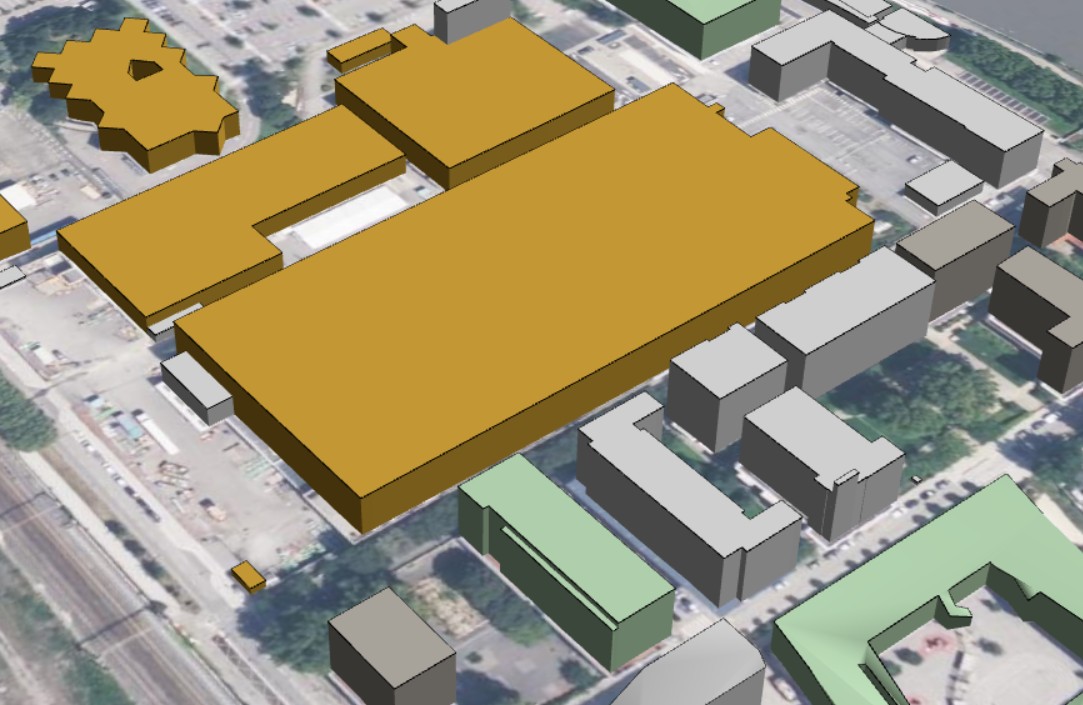
Des polygones de la BD TOPO IGN extrudés
ConclusionL'entité FeatureCollection permet d'afficher des features 2D et 3D, incluant des volumes (bâtiments, polyhèdres arbitraires), des symboles et des lignes. Les styles dynamiques améliorent l'interactivité avec les features et aident les utilisateurs à se repérer dans des scènes complexes.
-
-
sur Fernando Quadro: Black Friday Geocursos, não perca!
Publié: 22 October 2024, 4:00pm CEST
 A BLACK FRIDAY DA GEOCURSOS VEM AÍ!
A BLACK FRIDAY DA GEOCURSOS VEM AÍ!
Quer estudar e crescer na carreira ainda em 2024? Então se liga que teremos cursos com descontos imperdíveis na Black Friday!
 CURSOS COM ATÉ 60%OFF entre os dias 08 e 10 de novembro!
CURSOS COM ATÉ 60%OFF entre os dias 08 e 10 de novembro!
Estarão disponíveis nossos COMBOS com os cursos: PostgreSQL, PostGIS Básico, GeoServer e OpenLayers 4!
Já anota na agenda ai para não esquecer!
Participe do nosso Grupo VIP para ficar por dentro de tudo e pegar seu cupom em primeiro mão:
-
sur Mappery: Wooden Map
Publié: 22 October 2024, 1:00pm CEST
Pièce jointe: [télécharger]

Ana Lucia Gonzalez shared this “Wooden map in Cabo Polonio, Uruguay, manually painted, showing the location of the main square, the path to the sea wolves, the school and the police station.”
-
sur SFCGAL 2.0
Publié: 22 October 2024, 8:09am CEST par Loïc Bartoletti
Pièce jointe: [télécharger]
Sortie de SFCGAL 2.0SFCGAL 2.0 est maintenant disponible. Cette mise à jour de notre bibliothèque open source pour la manipulation et l’analyse de géométries 2D avancé et 3D apporte plusieurs nouvelles fonctionnalités et améliorations.
Principales nouveautés- Compatibilité CGAL
- Support des versions 5.6 et 6.0 de CGAL
- Nouvelles fonctionnalités 3D
- Buffer 3D pour les points et lignes ;
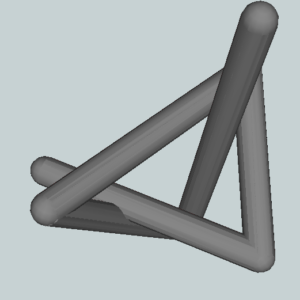
Buffer 3D Round
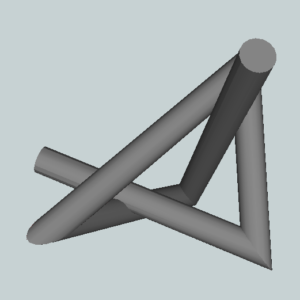
Buffer 3D Flat
- Partitionnement basé sur le squelette polygonal pour la décomposition de polygones. L’algorithme « Straight Skeleton » existe depuis plusieurs versions, il peut désormais retourner un MultiPolygone.

- Améliorations des opérations géométriques
- Nouvelles méthodes pour translater, tourner et mettre à l’échelle les géométries en 2D et 3D. Pour cela, quoi de mieux, de montrer en exemple la construction 3D du logo PostGIS visualisé dans QGIS 3D !

- Nouvelles options d’export
- Possibilité d’exporter les géométries aux formats VTK et OBJ
- Facilité de déploiement
- Images Docker disponibles pour Debian et Windows
L’intégration de SFCGAL 2.0 dans la prochaine version de PostGIS est en cours de développement et les nouveautés devraient être disponibles dans la version 3.6.0. Ce travail ouvre la voie à plus de traitements avancés 2D et 3D directement dans la base de données spatiale de référence !
PySFCGALPySFCGAL, la version Python de SFCGAL, continue son développement, se rapprochant des fonctionnalités d’outils similaires comme Shapely. Une nouvelle documentation est disponible sur le site dédié. Son installation est facilitée par la mise à disposition d’un paquet wheel qui intègre toutes les dépendances pour l’utiliser.
QSFCGALLe développement de QSFCGAL progresse. Ce projet vise à fournir une interface utilisateur QGIS pour les fonctionnalités de SFCGAL.
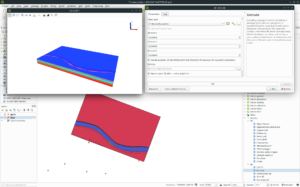 Développement et support
Développement et support
SFCGAL a évolué pour devenir un projet open source indépendant, gouverné par un Project Steering Committee (PSC) dédié. Cette transition marque une étape importante dans la maturité du projet et son ouverture à une plus large communauté de développeurs.
Gouvernance indépendante-
-
- Un PSC a été mis en place pour assurer la gestion du projet, et encadrer le développement et les orientations futures de SFCGAL.
- Le projet accueille désormais des contributeurs de divers horizons, renforçant son statut de projet open source communautaire.
-
-
-
- Oslandia reste un contributeur actif et engagé dans le projet, et se réjouit d’effectuer ce travail de façon encore plus ouverte !
- L’open source est au cœur des valeurs d’Oslandia, et l’entreprise continue de soutenir activement le développement de SFCGAL.
-
-
-
- SFCGAL quitte le giron d’Oslandia, pour se positionner comme un projet open source accessible à toute la communauté.
- Nous encourageons vivement les contributions externes, qu’il s’agisse de code, de documentation, ou de retours d’expérience.
-
-
-
- Les développeurs intéressés par le projet peuvent consulter notre guide de contribution sur le dépôt GitLab du projet.
- Nous accueillons également les rapports de bugs, les suggestions de fonctionnalités et les discussions sur notre espace de discussion.
- Nous encourageons ceux qui utilisent et bénéficient de SFCGAL à envisager de soutenir financièrement le projet pour assurer sa pérennité et son évolution.
-
Pour plus d’informations sur le projet ou pour commencer à contribuer, visitez le site officiel de SFCGAL ou contacter l’équipe SFCGAL par mail.
- Compatibilité CGAL
-
sur Fernando Quadro: WFS-T com OpenLayers, PostGIS e GeoServer
Publié: 21 October 2024, 4:00pm CEST
Outro dia eu estava navegando pela internet quando “esbarrei” com um post muito interessante sobre como utilizar o WFS Transactions (WFS-T), para salvar feições no PostGIS a partir de uma aplicação web com OpenLayers.
Eu já tinha postado algo bem similar a isso a um bom tempo atrás, mas já estava bastante desatualizado, então eu decidir traduzir e (re)postar esse material aqui no blog.
1. O Projeto
Essa aplicação está postada no GitHub e usa no frontend React/OpenLayers para atualizar dados de recursos GIS armazenados em um banco de dados PostGIS usando transações WFS (facilitadas pelo GeoServer).
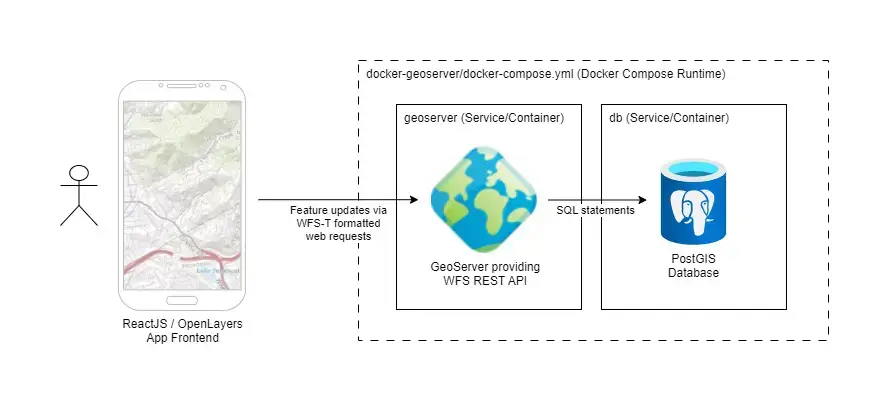
2. Objetivo
O objetivo era exibir um recurso WFS em um mapa com OpenLayers e gravar alguns dados no PostGIS cada vez que o recurso fosse clicado. Isso foi feito incluindo a propriedade interation nos dados do recurso que rastreou o número de cliques.

Foi utilizado o docker kartoza/docker-geoserver para montar o backend com GeoServer e PostGIS. Graças ao trabalho duro do Kartoza, isso foi tão fácil quanto executar docker-compose up no diretório apropriado (mais instruções aqui).
Alguma configuração foi necessária para criar uma tabela e um registro de exemplo no PostGIS. Uma vez que isso foi concluído, mais algumas etapas foram necessárias para criar um workspace, store e uma camada no GeoServer para publicar a tabela do PostGIS.
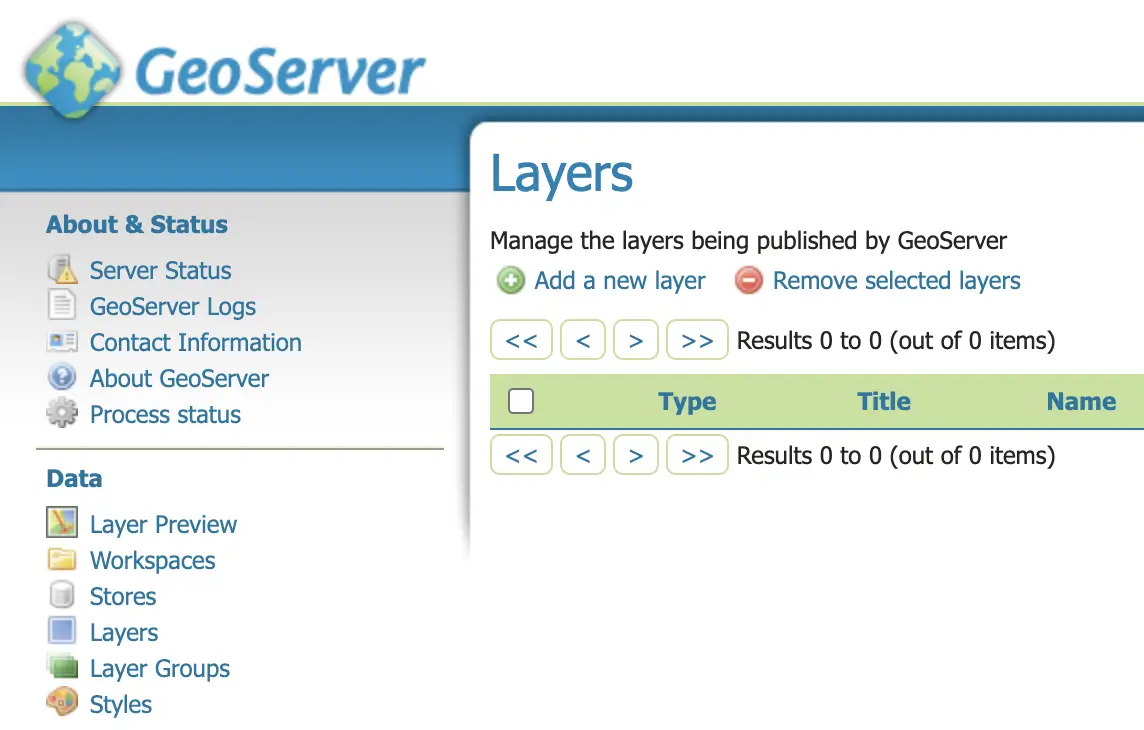
A etapa final é publicar a camada no GeoServer e aí começa a diversão!
3. O Frontend
O aplicativo frontend foi baseado em React com OpenLayers. Alguns call-outs específicos e lições aprendidas são compartilhados abaixo, mas confira o projeto no GitHub para o código-fonte completo.
3.1 Criando a camada WFS do GeoServer no OpenLayers
Definir a camada e os estilos do WFS foi simples usando a estratégia bbox padrão, usada para instruir o OpenLayers sobre como/quando carregar os recursos do WFS. Veja:
import VectorSource from 'ol/source/Vector'; import GeoJSON from 'ol/format/GeoJSON.js'; import {bbox as bboxStrategy} from 'ol/loadingstrategy.js'; import VectorLayer from 'ol/layer/Vector'; const GEOSERVER_BASE_URL = 'http://localhost:8600/geoserver/dev'; // create geoserver generic vector features layer const featureSource = new VectorSource({ format: new GeoJSON(), url: function (extent) { return ( GEOSERVER_BASE_URL + '/ows?service=WFS&' + 'version=1.0.0&request=GetFeature&typeName=dev%3Ageneric&maxFeatures=50&' + 'outputFormat=application%2Fjson&srsname=EPSG:3857&' + 'bbox=' + extent.join(',') + ',EPSG:3857' ); }, strategy: bboxStrategy, }); const featureLayer = new VectorLayer({ source: featureSource, style: { 'stroke-width': 0.75, 'stroke-color': 'white', 'fill-color': 'rgba(100,100,100,0.25)', }, });3.2 Usando React Refs para acessar objetos OpenLayers
Ao integrar o OpenLayers com o React, é importante inicializar os objetos do OpenLayers uma vez (por exemplo, em um hook onload) e usar Refs para manter referências a esses objetos entre as renderizações.
Isso também permite que a versão atual desses objetos seja acessível em funções de retorno de chamada. Caso contrário, uma versão obsoleta do objeto pode ser fornecida ao retorno de chamada (capturada no momento do fechamento do retorno da chamada).
// react import React, { useEffect, useRef } from 'react'; import Map from 'ol/Map' function MapWrapper(props) { // refs are used instead of state to allow integration with 3rd party map onclick callback; // these are assigned at the end of the onload hook // [https:] const mapRef = useRef(); const mapElement = useRef(); const featuresLayerRef = useRef(); // other logic removed for brevity // react onload hook useEffect( () => { // create map const map = new Map({ // config removed for brevity }) // save map and featureLary references into React refs featuresLayerRef.current = featureLayer; mapRef.current = map },[]) return ( <div> <div ref={mapElement} className="map-container"></div> </div> ) } export default MapWrapperNo exemplo acima, os objetos OpenLayers map, featuresLayer e até mesmo o div mapElement são armazenados como Refs para uso em funções de retorno de chamada fora do React.
3.3 Executando transações WFS a partir de funções de retorno de chamada do OpenLayers
O ponto crucial de todo esse aplicativo é enviar as solicitações de transação WFS para o GeoServer com os dados de recurso do OpenLayers para gravar no PostGIS. Isso é tratado na função de retorno de chamada no onclick do mapa.
import WFS from 'ol/format/WFS'; import GML from 'ol/format/GML32'; const GEOSERVER_BASE_URL = 'http://localhost:8600/geoserver/dev'; // map click handler - uses state and refs available in closure const handleMapClick = async (event) => { // get clicked feature from wfs layer // TODO: currently only handles a single feature const clickedCoord = mapRef.current.getCoordinateFromPixel(event.pixel); const clickedFeatures = featuresLayerRef.current.getSource().getFeaturesAtCoordinate(clickedCoord); if (!clickedFeatures.length) return; // exit callback if no features clicked const feature = clickedFeatures[0]; // parse feature properties const featureData = JSON.parse(feature.getProperties()['data']); // iterate prop to test write-back if (featureData.iteration) { ++featureData.iteration; } else featureData.iteration = 1; // set property data back to feature feature.setProperties({ data: JSON.stringify(featureData) }); console.log('clicked updated feature data', feature.getProperties()) // prepare feature for WFS update transaction // [https:] const wfsFormatter = new WFS(); const gmlFormatter = new GML({ featureNS: GEOSERVER_BASE_URL, featureType: 'generic', srsName: 'EPSG:3857' // srs projection of map view }); var xs = new XMLSerializer(); const node = wfsFormatter.writeTransaction(null, [feature], null, gmlFormatter); var payload = xs.serializeToString(node); // execute POST await fetch(GEOSERVER_BASE_URL + '/wfs', { headers: new Headers({ 'Authorization': 'Basic ' + Buffer.from('admin:myawesomegeoserver').toString('base64'), 'Content-Type': 'text/xml' }), method: 'POST', body: payload }); // clear wfs layer features to force reload from backend to ensure latest properties // are available featuresLayerRef.current.getSource().refresh(); // display updated feature data on map setFeatureData(JSON.stringify(featureData)); }O código acima é executado quando o recurso WFS é clicado. Isso aciona a seguinte lógica:
Linhas 11-14: o objeto de feição OpenLayers clicado é identificado
Linhas 17-25: a propriedade iteration do recurso é aumentada em 1 e salva de volta no recurso
Linhas 30-38: o recurso é convertido no formato apropriado para a transação WFS
Linhas 41-48: a solicitação de transação WFS é definida para a instância do Docker GeoServer criada anteriormente no projeto
Linhas 52-55: solicita que o OpenLayers recarregue os dados WFS do GeoServer para garantir que as propriedades de atualização estejam presentes4. Para onde ir a partir daqui
Agora que temos um exemplo de como gravar dados GIS do OpenLayers no PostGIS, podemos expandir este aplicativo para suportar criação e edição de recursos mais complexos. Por exemplo, desenhar recursos com o OpenLayers.
Fonte: Taylor Callsen
-
sur Mappery: Lisbon Metro Map
Publié: 21 October 2024, 1:00pm CEST
Pièce jointe: [télécharger]
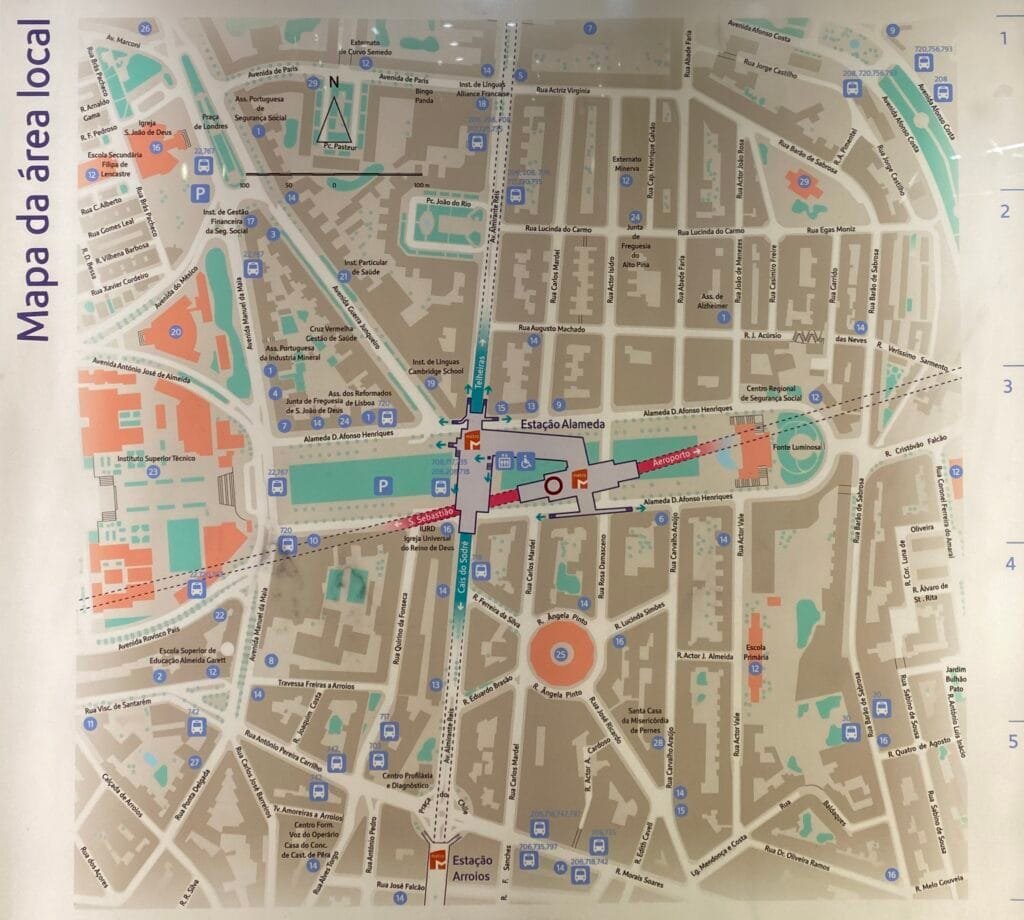
Reinder sent this and said “In metro stations in Lisbon, one can find maps that present a plan of the streets above your head. What I saw there for the first time is that the metro station and metro lines themselves are also depicted on the map: quite convenient for better orientation!”
Impressive.
-
sur Mappery: Chloropleth Embroidery
Publié: 20 October 2024, 1:00pm CEST
Pièce jointe: [télécharger]
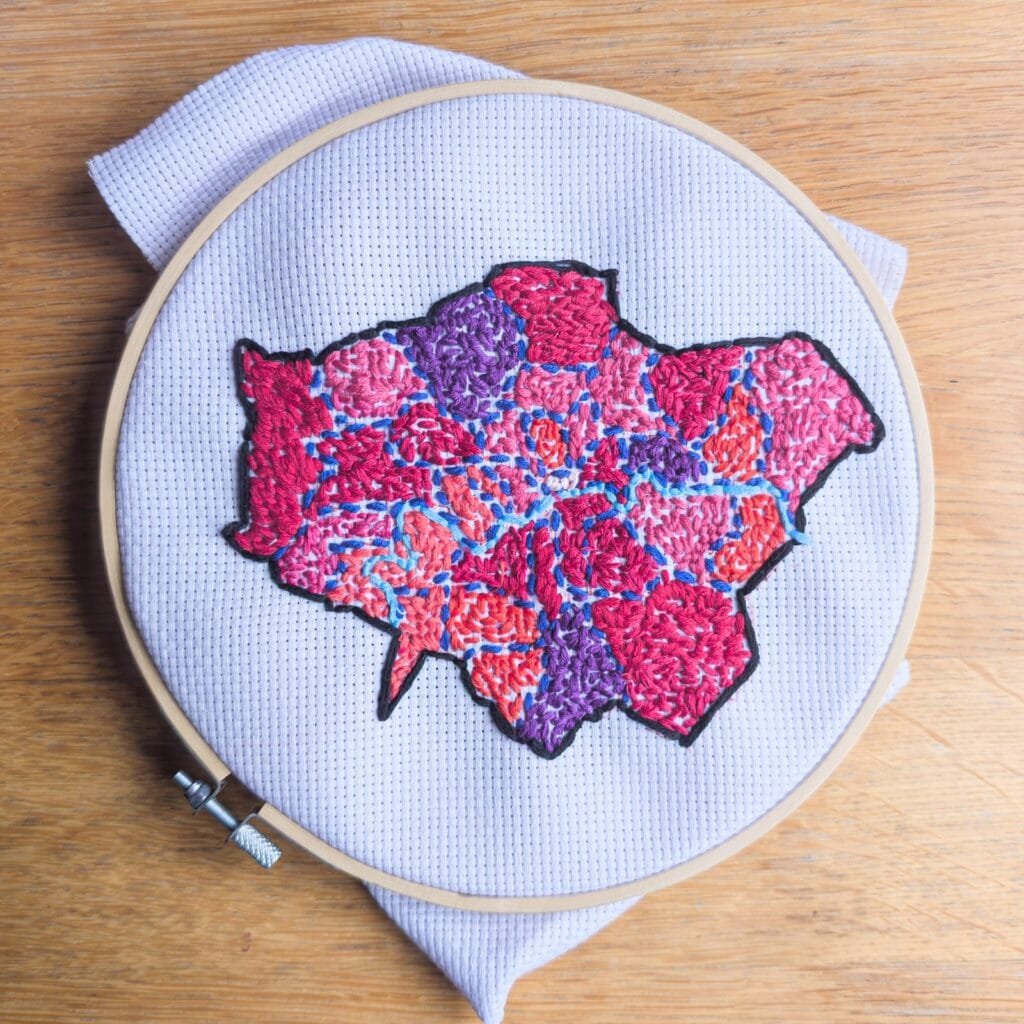
My pal Giuseppe Sollazzo has an incredibly wide range of interests which include geography and embroidery. He recently completed his latest project – “Mission accomplished ? Choropleth of London councils by population, with a terrible palette choice! Data from wikipedia, shapefile from Ordnance Survey”
I asked him what prompted the idea for this embroidered map – “The idea fundamentally came from my recent interest in trying more analogue experiences while not completely giving up my data & digital passions. Which means I’m doing less internet, more ham radio, and less javascript maps and more physical ones. Having recently learned crochet, I thought that embroidery would be great for data visualization. It takes a while so it’s an act of love to data ? But the result is oddly pleasant.”
I think we can all agree that it is more than oddly pleasant! If there was a Nobel Prize for geogeekery, I think Giuseppe would be a winner.
-
sur Mappery: Lighting up Lisbon Airport
Publié: 19 October 2024, 1:00pm CEST
Pièce jointe: [télécharger]
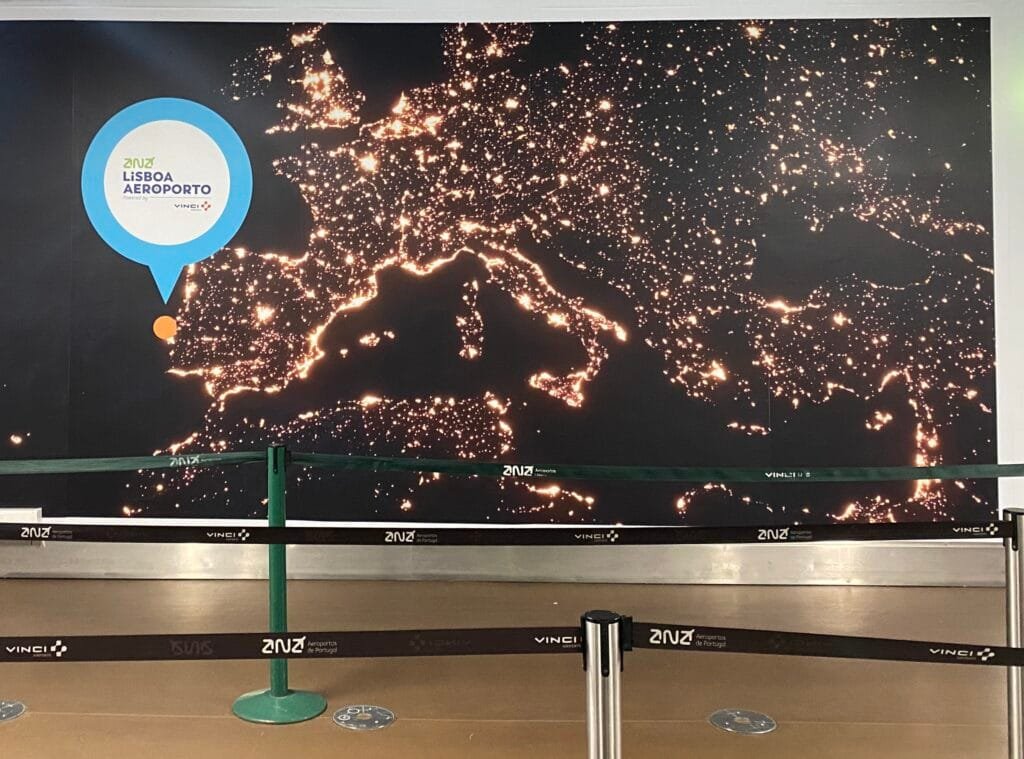
Reinder sent this from Lisbon. Sparkly!
-
sur Markus Neteler: How to contribute to GRASS GIS development
Publié: 18 October 2024, 8:06pm CEST
How to contribute to GRASS GIS development: Guidance for new developers in the GRASS GIS Project.
The post How to contribute to GRASS GIS development appeared first on Markus Neteler Consulting.
-
sur Mappery: Map van
Publié: 18 October 2024, 1:00pm CEST
Pièce jointe: [télécharger]
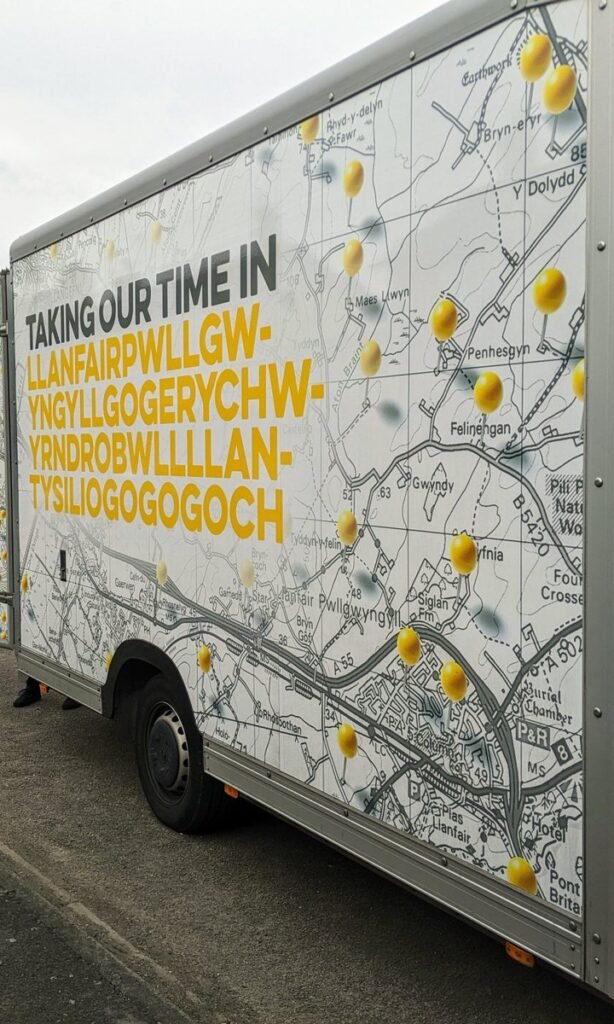
We love Maps on Vans. This one comes from Bob Chell. Thanks for sharing.
-
sur 3liz: Sortie de Lizmap Web Client 3.8
Publié: 17 October 2024, 2:00pm CEST
Lizmap Web Client 3.8Nous sommes heureux d'annoncer la sortie de Lizmap Web Client 3.8, la nouvelle version majeure de l'application.
Financeurs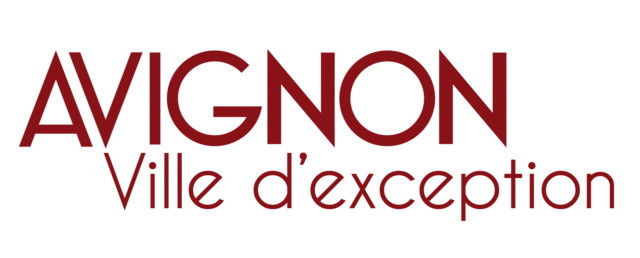
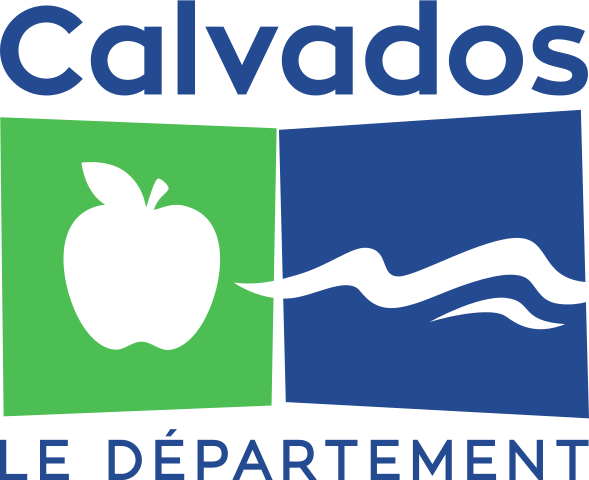
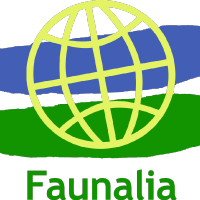


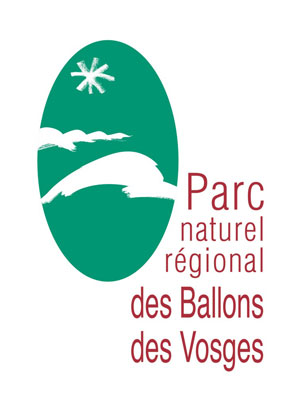
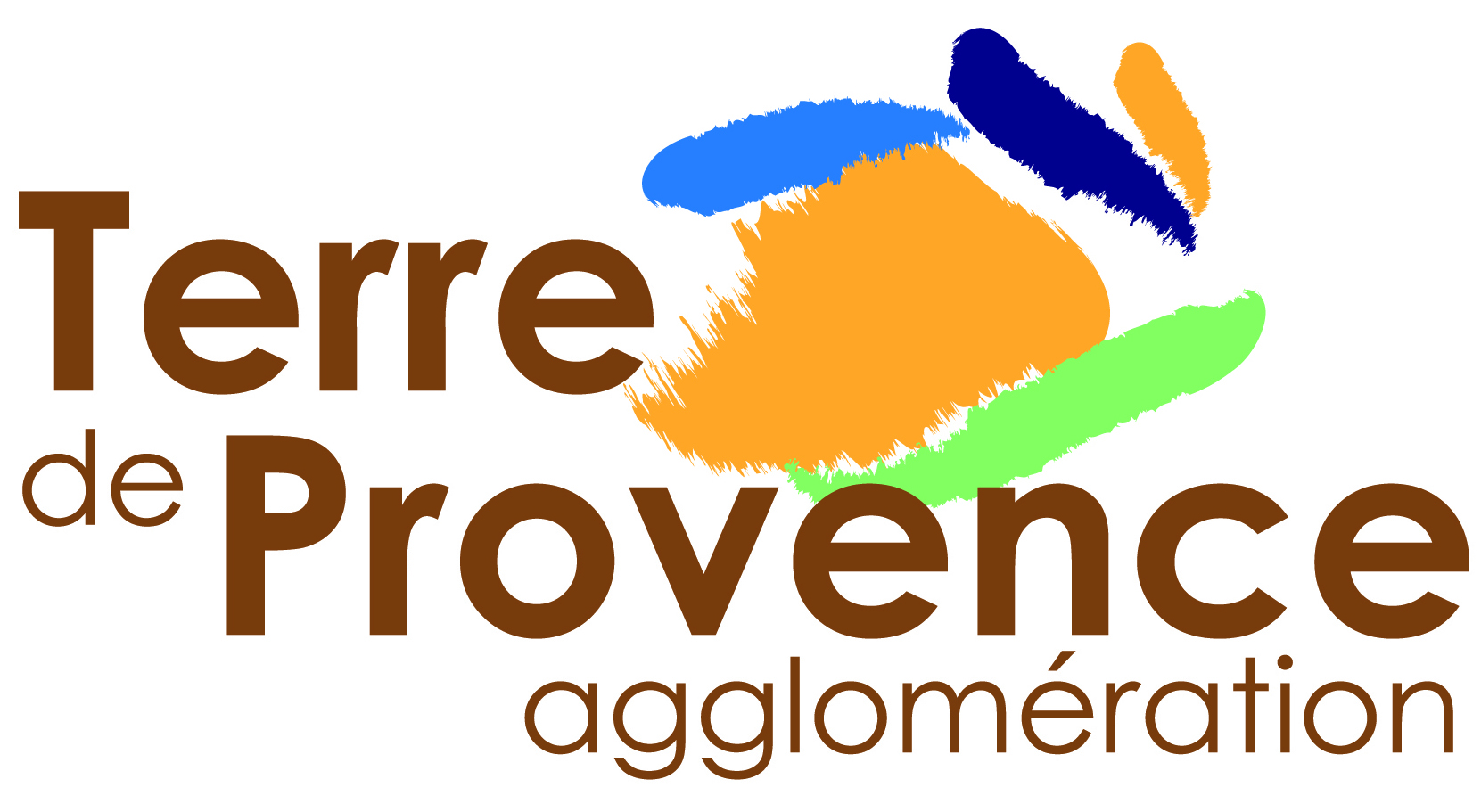
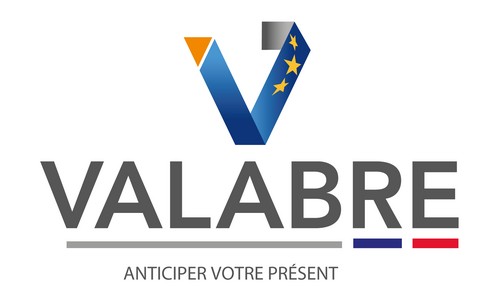
 Pré-requis et installation
Pré-requis et installation
Il est désormais requis d'avoir un QGIS serveur minimum 3.28. Cependant, nous recommandons fortement d'utiliser une version LTR plus récente, comme la version 3.34. Consultez la feuille de route QGIS.
Pour utiliser pleinement cette version 3.8, n'oubliez pas de mettre à jour votre extension Lizmap dans QGIS bureautique. Nous avons écrit un article dédié sur cette version.
Fonctionnalités Demande de tuile unique pour toutes les couchesJusqu'à la version 3.7, Lizmap Web Client effectuait une requête HTTP au serveur QGIS par couche visible.
Désormais, grâce à Faunalia qui a contribué au code source, Lizmap Web Client peut effectuer une seule requête HTTP
GetMapà QGIS Serveur pour toutes les couches visibles (sauf pour les couches ayant un cache actif).Les deux méthodes ont des avantages et des inconvénients. Cette nouvelle option de l'extension peut être très utile pour les projets lourds.

Petite astuce également disponible sur la dernière version 3.7, il est désormais possible de désactiver le permalien automatique avec la case à cocher.
AccrochageLorsque l'accrochage est activé sur une couche, l'utilisateur peut désormais sélectionner dans l'interface Web sur quelle couche s'accrocher.
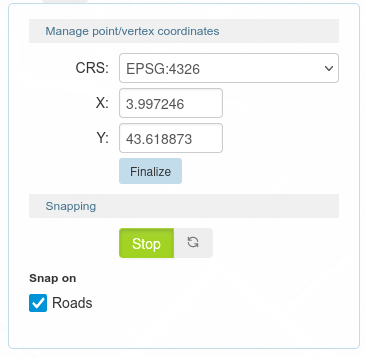
Cette nouvelle fonctionnalité a été développée par Faunalia.
InfobulleLa fonctionnalité d'Infobulle de Lizmap Web Client a été grandement améliorée dans cette dernière version. Avant, côté gauche de la capture d'écran, vous ne pouviez sélectionner qu'un champ à afficher lorsque vous survoliez une entité dans le navigateur Web. Maintenant, comme nous pouvons voir sur le côté droit, nous pouvons écrire un modèle HTML. Comme cela peut prendre en charge des expressions QGIS, nous vous encourageons à migrer votre "ancienne" configuration pour ajouter du HTML.
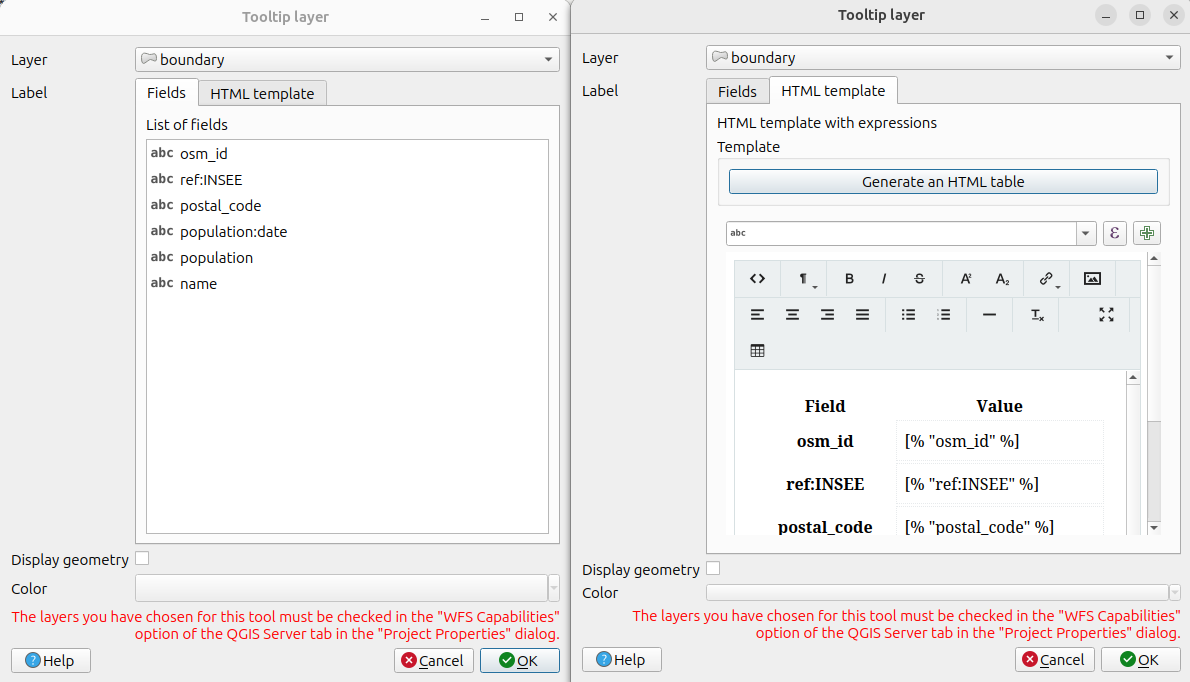
Cette nouveauté a été financée par le PNR Ballons des Vosges.
Navigation sur la carteEn raison de la transition, sous le capot, d'OpenLayers 2 vers OpenLayers 10, la transition entre les différents le niveau de zoom est désormais plus fluide que dans la version 3.7.
Dans 3.7, le choix dans Lizmap concernant la légende était de suivre exactement ce que faisait QGIS Bureautique lors d'un clic dans la légende sur les groupes, sous-groupes et couches.
Après quelques retours d'utilisateurs, nous avons introduit le double clic dans la légende pour basculer tous les éléments enfants.
Filtrage par attribut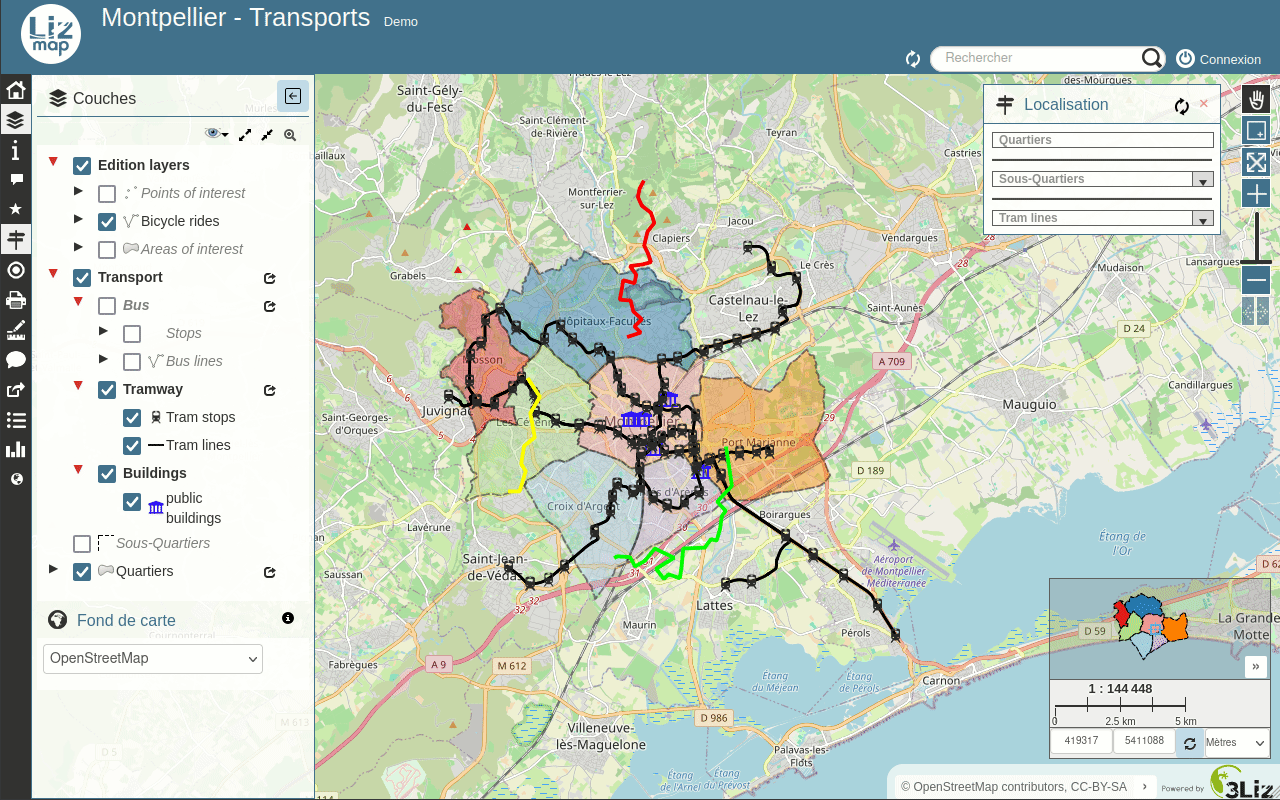
Lorsqu'une couche dispose d'un filtrage attributaire sur les utilisateurs ou les groupes, il est désormais possible d'avoir une liste de valeurs séparées par des virgules dans le champ :
id name filter_field 1 one group_a,group_b 2 two group_b 3 three group_b,all 4 four all Cette nouvelle fonctionnalité a été financée par le département du Calvados.
Numérisation et relations au sein du projetPour les relations 1:n et n:m, lorsqu'elles sont dans une popup, les éléments enfants sont correctement placés à l'intérieur de la popup parent selon la configuration QGIS Glisser&Déposer.
Le même comportement existe lors de la modification d'une entité.
De nouveaux boutons pour ajouter des entités liées ont été ajoutés, par exemple dans la table attributaire ci-dessous :

Cette nouvelle fonctionnalité a été développée par Faunalia.
Lors de la numérisation, il y a un bouton Effacer tout.
PopupNous avons introduit un nouveau composant HTML
lizmap-features-tablepour avoir une liste compacte d'entités et les étiquettes d'une couche vecteur. Le Nom d'affichage (Display name) de QGIS est utilisé comme étiquette de l'entité : une expression peut être utilisée pour modifier son contenu, configuré dans l'onglet Info-bulle des propriétés de la couche vecteur de QGIS. Par exemple :CONCAT("quartiers_libquart", ' - ', "libsquart", ' (', to_int(area(@geometry)/10000), ' ha)')produira un texte comme
MONTPELLIER CENTRE - Les Aubes (85 ha)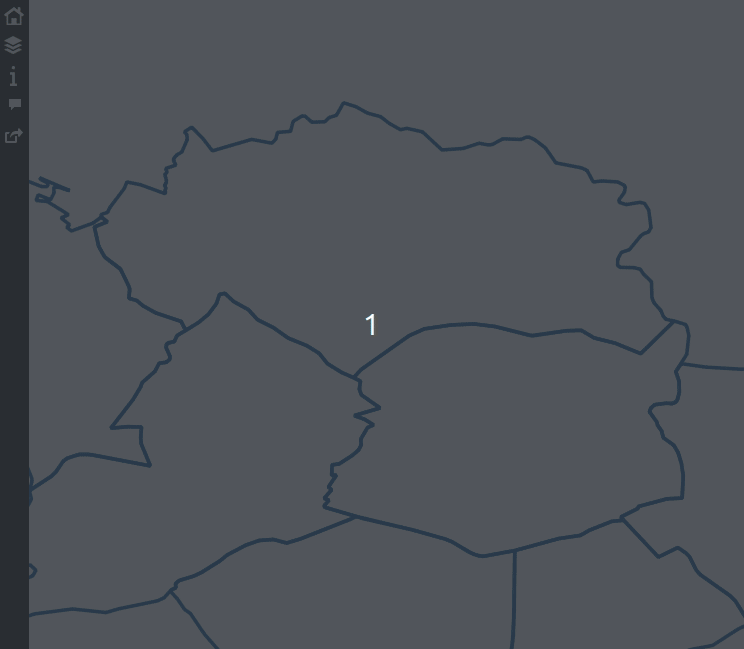
Vous pouvez trouver plus d'informations sur la page dédiée sur GitHub sur la syntaxe de ce composant HTML.
Cette nouveauté a été financée par la ville d'Avignon.
AdministrationDans le panneau d'administration, sur la page Information serveur, similaire à la liste des extensions QGIS Serveur installées, on peut désormais retrouver la liste des modules Lizmap installés, avec sa version correspondante.
Concernant les extensions, nous avons ajouté un lien HTML vers la page d'accueil de l'extension, afin de vous guider vers quelques informations complémentaires. Cette dernière fonctionnalité viendra également sur les modules plus tard.
Chargement du JavaScript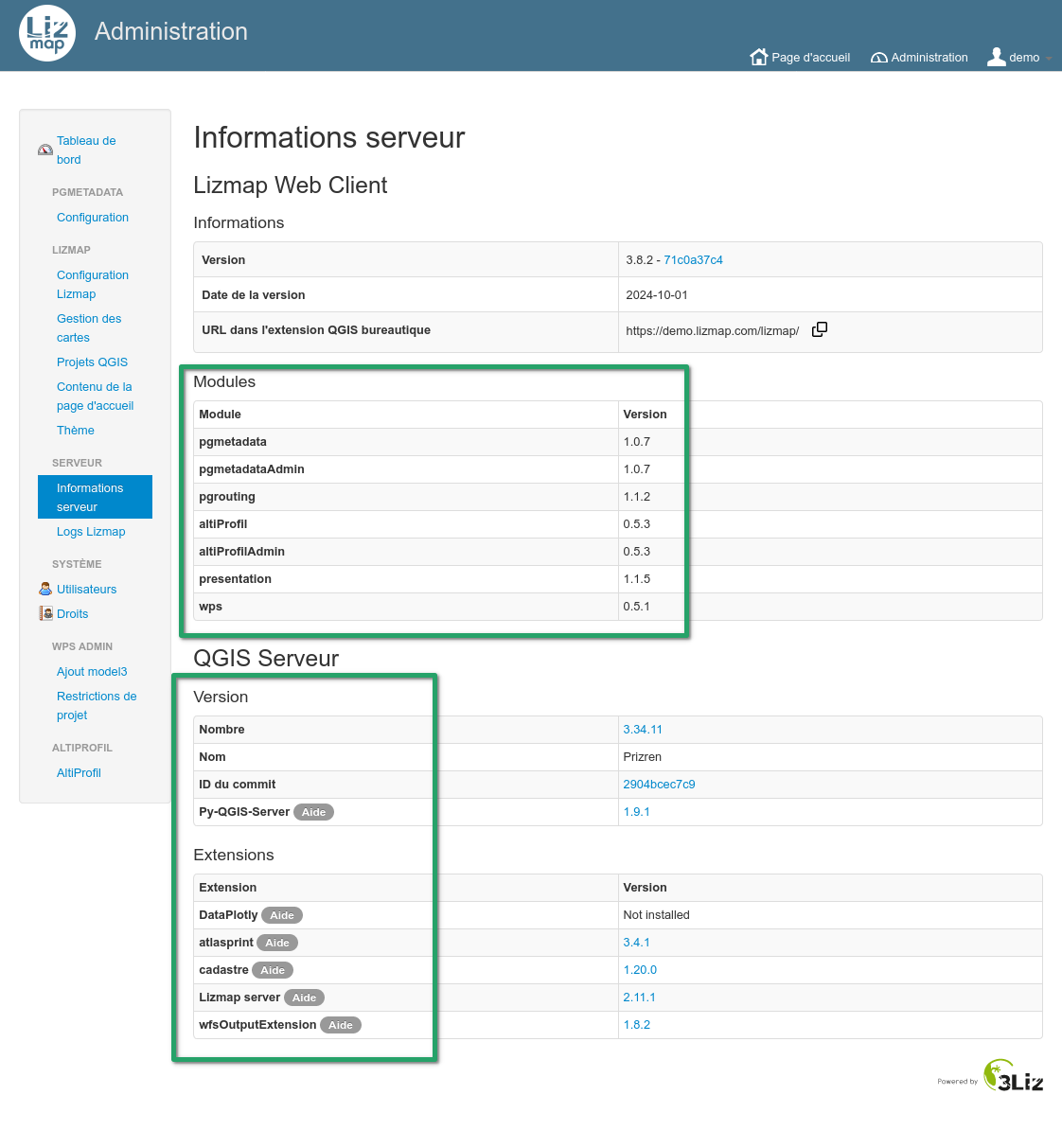
Si un JavaScript génère une erreur lors du chargement de la carte, il existe désormais un bouton pour ouvrir temporairement la carte sans JavaScript complémentaire grâce au paramètre
no_user_defined_js=1dans l'URL. Cela vous permet de charger la carte et vérifiez si l'erreur provient d'un script complémentaire.En passant, nous avons également travaillé sur XSS. Ce travail a commencé il y a quelques versions (en 3.6), mais maintenant en 3.8, il n'est plus possible d'intégrer directement du code JavaScript dans l'info-bulle HTML de QGIS. Vous devez utiliser un fichier
Sous le capot*.jsdédié.La carte OpenLayers 10 est maintenant par-dessus la carte "historique" OpenLayers 2. Certains outils ont été migrés d'OpenLayers 2 vers OpenLayers 10, comme les popups et la localisation par surbrillance d'une couche. Par conséquent, cette version supprime à nouveau certaines dépendances d'OpenLayers 2.
Vous devrez peut-être adapter des scripts JavaScript complémentaires définis par l'utilisateur pour dessiner vos couches OpenLayers par-dessus la carte OpenLayers 10, par exemple.
Documentation sur le codeDepuis la version 3.7, de nombreuses refactorisations de code ont été effectuées du côté JavaScript et PHP. Nous pouvons désormais fournir une documentation HTML sur ces deux langages. Elles sont disponibles sur docs.3liz.org par exemple pour PHP ou pour JavaScript.
Nous vous recommandons fortement d'utiliser la nouvelle API JavaScript lors de l'écriture d'un script JavaScript complémentaire personnalisé.
TéléchargementVous pouvez télécharger le dernier zip sur notre page des sorties.
Pensez à installer la dernière version
3.8.X(et non pas3.8.0par exemple)Vous pouvez également consulter la liste des modifications complètes ("changelog") de la version 3.8.0, en anglais.
ModulesÀ la date du 15 octobre 2024, voici la liste des modules qui ont été mis à jour pour 3.8 :
Les autres modules sont en cours.
Nous espérons que vous allez apprécier cette nouvelle version ?
L'équipe 3Liz
-
sur 3liz: Release of Lizmap Web Client 3.8
Publié: 17 October 2024, 2:00pm CEST
Lizmap Web Client 3.83Liz is pleased to announce the release of Lizmap Web Client 3.8, the new major version of the application.
Funders







 Pre-requirements and installation
Pre-requirements and installation
It is now required to have a minimum QGIS server 3.28. However, we highly recommend using the latest LTR version, i.e. version 3.34. Check the QGIS roadmap.
To take full advantage of this version 3.8, don't forget to update your Lizmap plugin in QGIS desktop. We've written an article dedicated to this version.
Features Single tile request for all layersUntil version 3.7, Lizmap Web Client was doing one HTTP request to QGIS server per visible layer.
Now, thanks to Faunalia which contributed to the source code, Lizmap Web Client can make a single HTTP request
GetMapto QGIS Server for all visible layers (except for layers having a cache enabled).Both methods have strengths and weaknesses. This new option in the plugin, can be very useful for heavy projects.

Quick tip which is available on latest 3.7 as well, it's now possible to disable the automatic permalink with the checkbox.
SnappingWhen snapping is enabled on a layer, the user can now select from the web interface on which layer to snap on.

This new feature have been developed by Faunalia.
TooltipThe "Tooltip" feature in Lizmap Web Client got a great improvement in this latest version. Before, on the left side of the screenshot, you could only select one field to display while hovering a feature in the web browser. Now, as we can see on the right side, we can write an HTML template. We can support QGIS expression, se we encourage you to migrate your "old" configuration to add some nice HTML.

This new feature have been funded by PNR Ballons des Vosges.
Map viewerDue to the transition, under the hood, from OpenLayers 2 to OpenLayers 10, the map transition between different zoom level is now smoother than in the 3.7 release.
In 3.7, the choice in Lizmap about the legend was to follow exactly what QGIS Desktop is doing when clicking in the legend about groups, subgroups and layers.
After some user feedbacks, we could introduce the double click in the legend to toggle all child items.
Attribute filter
When a layer has an attribute filtering about user or groupes, it's now possible to have a comma separated list of values in the field :
id name filter_field 1 one group_a,group_b 2 two group_b 3 three group_b,all 4 four all This new feature have been funded by Calvados province.
Digitizing and relations within the projectFor both 1:n and n:m relations, when displayed in a popup, the child items are correctly placed inside the parent popup according to the QGIS Drag&Drop configuration relations have been improved.
The same behavior exists when editing a feature.
New buttons to add linked features have been added, for instance in the attribute table below :

This new feature have been developed by Faunalia.
When digitizing, there is a button Erase all.
PopupWe have introduced a new HTML component
lizmap-features-tableto have a nice compact list of vector layer features and labels.The QGIS Display name is used as the feature label: an expression can be used to tweak its content, configured in the Tooltip tab of the QGIS vector layer properties. For example:
CONCAT("quartiers_libquart", ' - ', "libsquart", ' (', to_int(area(@geometry)/10000), ' ha)')will produce a text like
MONTPELLIER CENTRE - Les Aubes (85 ha)
You can find more information on the dedicated page on GitHub about the syntax of this HTML component.
This new feature have been funded by Avignon city.
AdministrationIn the administration panel, on the Server information page, similar to the list of QGIS Server plugins installed, we can now find the list of Lizmap modules installed with its own version.
About the plugins, we have added an HTML link to the plugin home page, we can lead you to some information about the plugin itself. This latest feature will come as well on modules later.
JavaScript loading
If a JavaScript raises an error while loading the map, there is now a button to temporarily open the map without additional user JavaScript script thanks to the flag in the
no_user_defined_js=1. This allows you to ty the map and check if the error come from an additional script.Side note, we have also worked on XSS. This work started a few version ago (in 3.6), but now in 3.8, it's not possible to embed JavaScript code into QGIS HTML maptip directly. You must use a dedicated
Under the hood*.jsfile.The OpenLayers 10 map is now on top on the legacy OpenLayers 2 map. Some tools were migrated from OpenLayers 2 to OpenLayers 10, like popup and locate by layer highlight. Therefore, this version removes again some OpenLayers 2 dependencies.
You might need to adapt some additional user defined JavaScript to draw your OpenLayers layers on top of the OpenLayers 10 map for instance.
Documentation about the codeSince version 3.7, a lot of code refactoring was done on the JavaScript and PHP side. Therefore, we can now provide an HTML documentation about these two languages. Both are available on docs.3liz.org for instance for PHP or for JavaScript.
We strongly recommend you to use the new JavaScript API when writing custom additional JavaScript script.
JavascriptDue to the work which have been done during the legend or other features in Lizmap, some previous Javascript script might not work anymore and need to be adapted.
DownloadYou can download the latest zip on our releases page.
Do not forget to install the latest
3.8.X(and not3.8.0for instance).You can also check the full changelog of version 3.8.0.
ModulesAs of October 15th 2024, this is the list of modules which have been released for 3.8 :
Other modules are work-in-progress.
We hope you will enjoy this new version ?
The 3Liz team
-
sur Mappery: Worn Clothing
Publié: 17 October 2024, 1:00pm CEST
Pièce jointe: [télécharger]
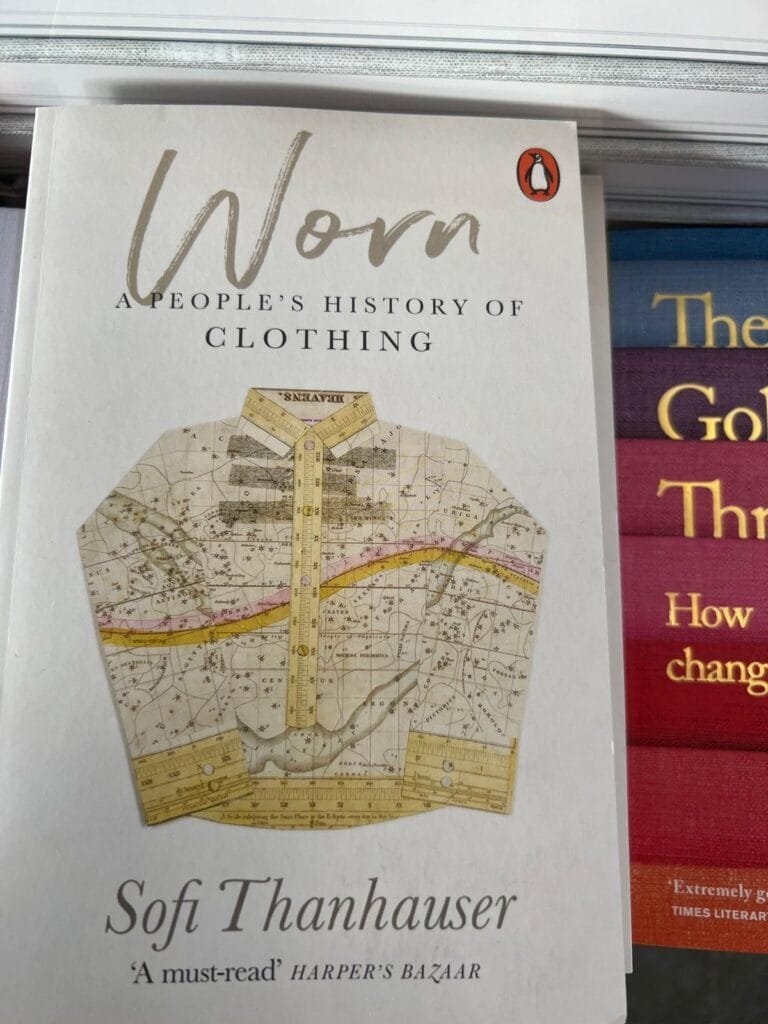
Elizabeth sent me this, beyond the cover I am not sure that this is a book for map lovers.
“A captivating and deeply researched study of the five main fabrics from which clothing is made: linen, cotton, silk, synthetics, and wool. Positing that “there is scarcely a part of the human experience, historic or current, that the story of clothes does not touch,” – Publishers Weekly
-
sur Fernando Quadro: 8 Funções do GIS na Inteligência de Negócios
Publié: 16 October 2024, 4:00pm CEST
O Sistema de Informações Geográficas (GIS) é uma tecnologia que pode ser usada para inteligência de negócios de diversas formas, como:
 Análise de Localização
Análise de Localização
Identifica localizações ideais para novas lojas, armazéns e instalações com base em dados geográficos e demográficos. Segmentação de Mercado
Segmentação de Mercado
Estratégias de marketing adaptadas para regiões específicas. Otimização da Cadeia de Suprimentos
Otimização da Cadeia de Suprimentos
Planejamento de rotas, logística e gerenciamento de estoque identificando os caminhos mais eficientes para transporte. Gerenciamento de Riscos
Gerenciamento de Riscos
Mapeia riscos ambientais e geopolíticos, zonas de desastres naturais, instabilidade política ou pontos críticos de crimes. Insights sobre o Comportamento do Cliente
Insights sobre o Comportamento do Cliente
O GIS rastreia os comportamentos do consumidor geograficamente, identificando padrões e preferências de compra regionais. Gerenciamento de Ativos
Gerenciamento de Ativos
Gerenciamento e monitoramento de ativos físicos como equipamentos, veículos ou infraestrutura em vários locais. Análise de Concorrentes
Análise de Concorrentes
Mapeia as localizações e o alcance de mercado dos concorrentes, fornecendo insights sobre lacunas ou oportunidades. Integração de dados em tempo real
Integração de dados em tempo real
GIS integra dados em tempo real de várias fontes, permitindo a tomada de decisões dinâmicas para ambientes de rápida mudança.Fonte: webgis.tech
Instagram: [https:]]
LinkedIn: [https:]]Gostou desse post? Conte nos comentários

-
sur WhereGroup: Mapbender 4 – Praxisbericht nach dem Major Release
Publié: 16 October 2024, 2:32pm CEST
Seit dem Major Release Mapbender 4.0.0. gibt es erste positive Rückmeldungen. Wir berichten über bereits umgezogene Projekte und nehmen noch einmal Bezug auf unser QGIS2Mapbender-Plugin, mit dem Sie Mapbender-Anwendungen direkt aus QGIS erstellen können. -
sur Mappery: Another embroidery from Anne
Publié: 16 October 2024, 1:00pm CEST
Pièce jointe: [télécharger]

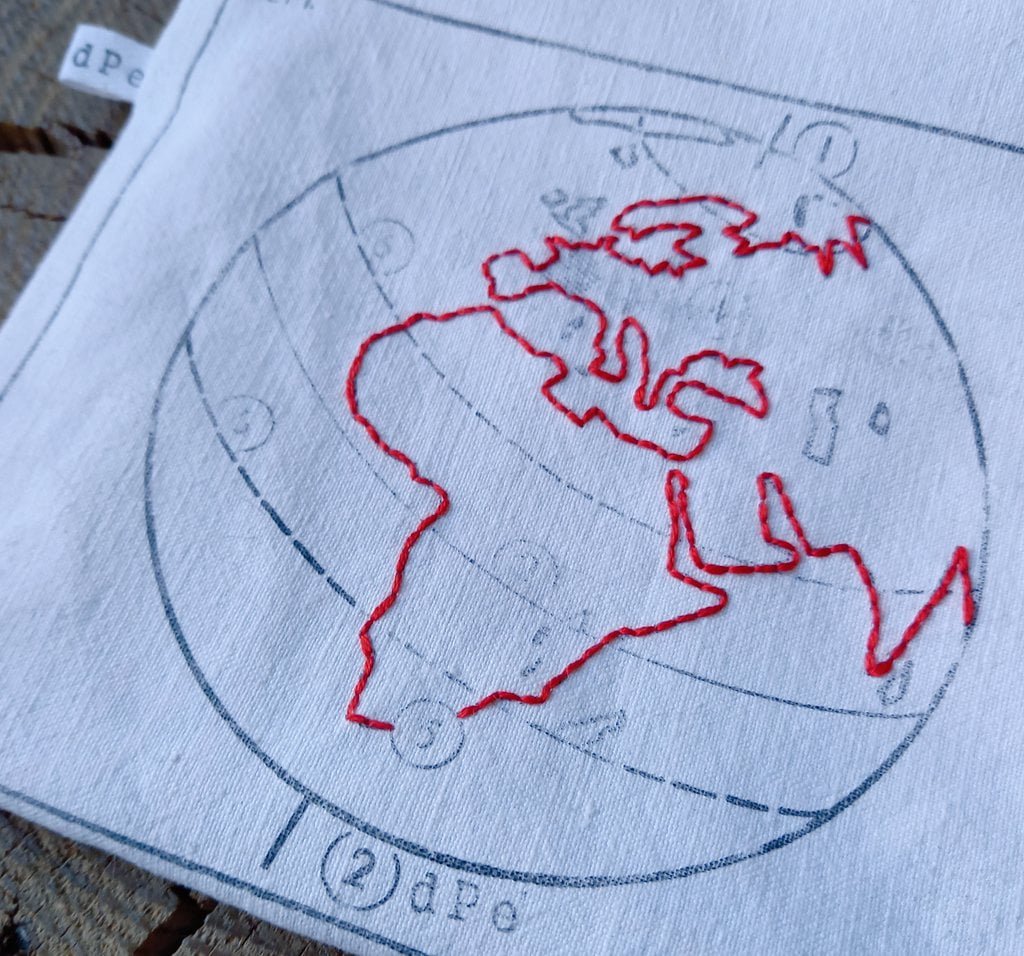
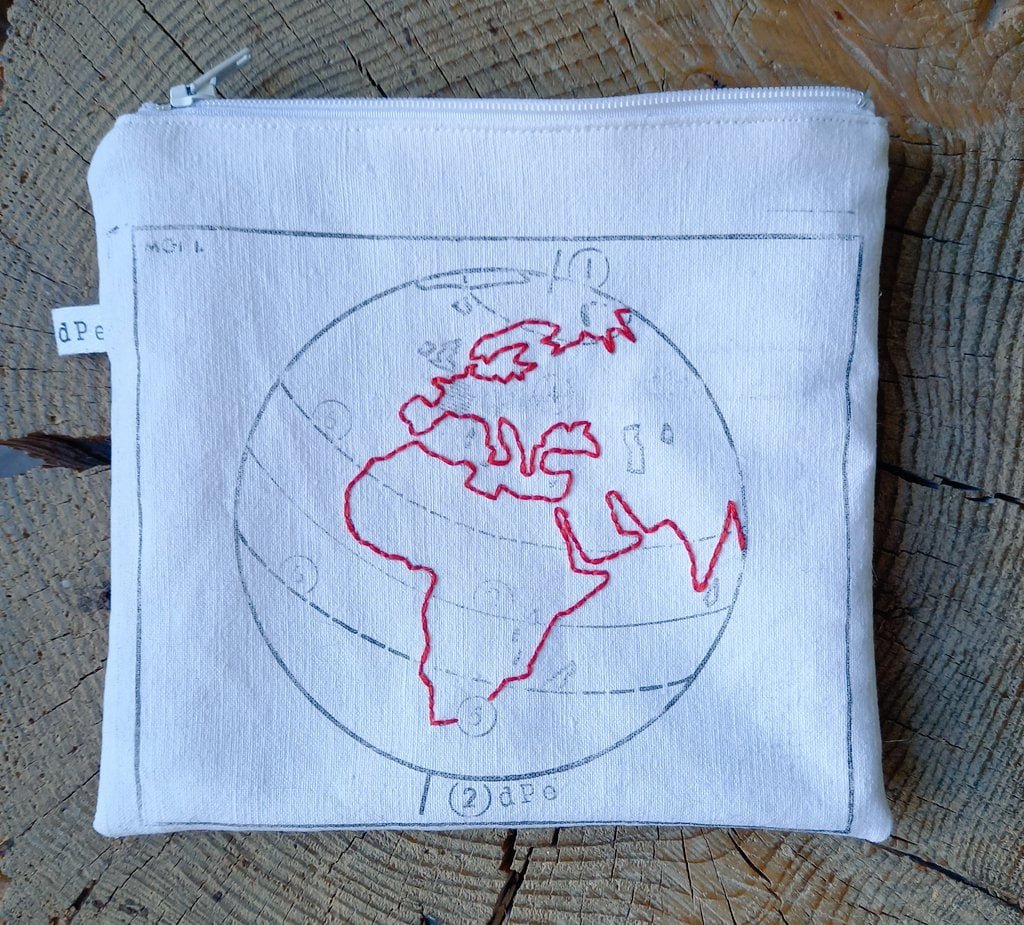
Anne L. shared this Map In The Wild, crafted over a weekend while enjoying the sun in her courtyard.
-
sur [Story] Oslandia x QWC : épisode 4 / 8
Publié: 16 October 2024, 8:57am CEST par Caroline Chanlon
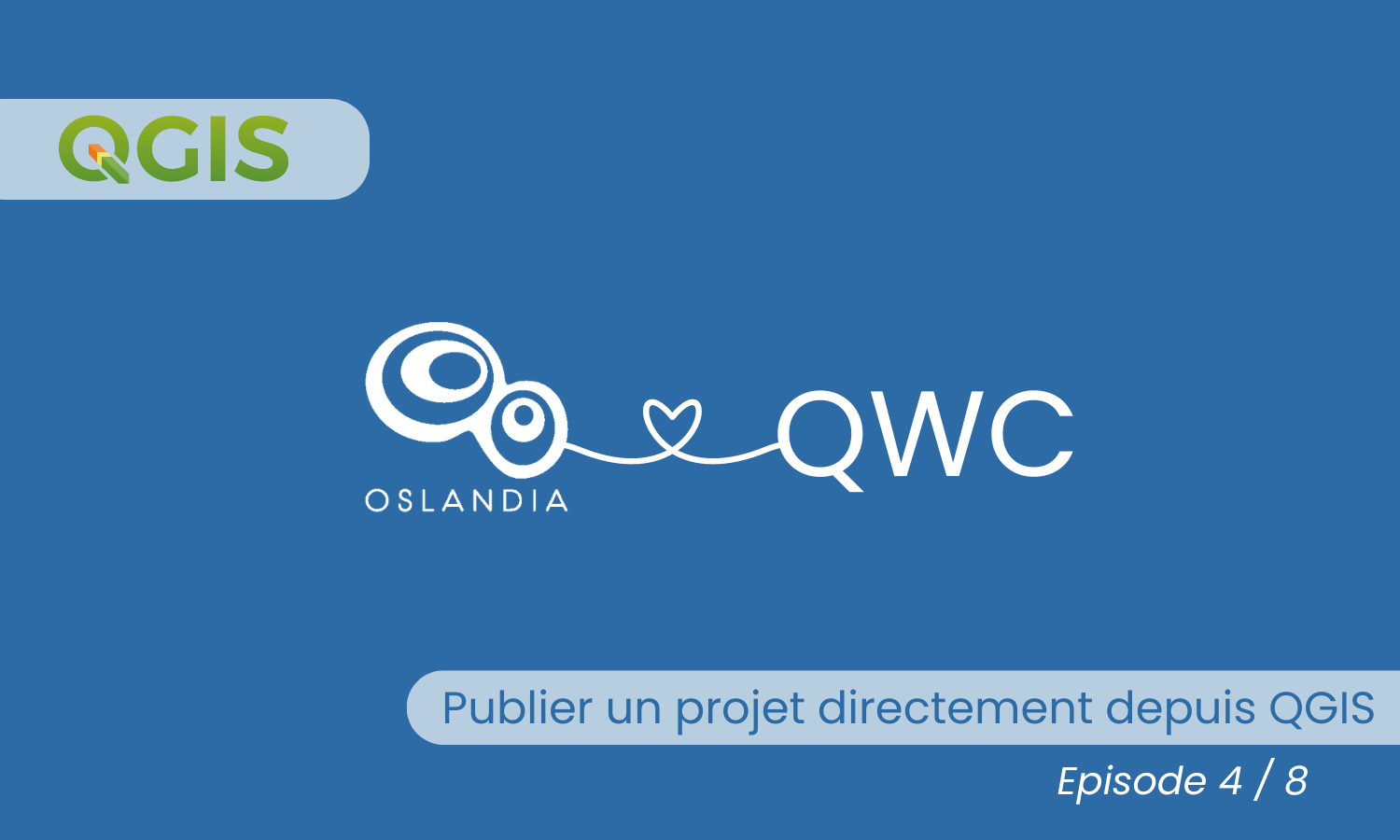
Nous présentions déjà plus tôt cette année un nouveau plugin QGIS pour QWC qui permet de publier un projet dans son application QWC sans quitter QGIS : [https:]]
 Depuis la publication de cet article, nous avons eu l’occasion d’apporter de nombreux correctifs et des améliorations (financés par Les Agences de l’eau | Direction des Systèmes d’Information et des Usages Numériques) au plugin QGIS ainsi qu’au service de publication associé.
Depuis la publication de cet article, nous avons eu l’occasion d’apporter de nombreux correctifs et des améliorations (financés par Les Agences de l’eau | Direction des Systèmes d’Information et des Usages Numériques) au plugin QGIS ainsi qu’au service de publication associé.Parmi les nouveautés, on retrouve :
- la possibilité d’ouvrir un projet publié dans le navigateur
- la gestion de plusieurs instances QWC (multi-tenant)
Dans chaque épisode de cette série dédiée à QWC – QGIS Web Client, nous abordons spécifiquement un aspect, un sujet pour terminer par la roadmap. Tous les épisodes sont à suivre sur notre site : [https:]
Vous aussi vous pouvez contribuer à QWC, directement ou en finançant les évolutions ! N’hésitez pas à nous contacter à infos@oslandia.com
-
sur Fernando Quadro: Interpolação de dados usando GDAL
Publié: 16 October 2024, 12:03am CEST
Interpolação espacial é uma técnica para estimar valores desconhecidos em locais com base em valores conhecidos em pontos próximos, criando uma superfície contínua a partir de dados discretos.
 Como pode ser útil?
Como pode ser útil?? Prevê valores em locais não amostrados.
? Preenche lacunas de dados para cobertura de área completa.
? Cria superfícies contínuas a partir de dados de pontos.
? Suporta tomada de decisão em vários campos.
? Permite mapeamento temático e visualização de padrões. A interpolação espacial com GDAL aprimora seus dados GIS
A interpolação espacial com GDAL aprimora seus dados GISA interpolação espacial é uma técnica crucial de engenharia de recursos em GIS que estima valores desconhecidos entre pontos de dados conhecidos.
GDAL (Geospatial Data Abstraction Library) oferece ferramentas poderosas para implementar vários métodos de interpolação. Aqui está uma visão geral das principais técnicas:
 Ponderação de distância inversa (IDW)
Ponderação de distância inversa (IDW)
? Método simples e rápido
? Assume que pontos próximos têm mais influência
? Ideal para estimativas rápidas Krigagem
Krigagem
? Método geoestatístico
? Considera a autocorrelação espacial
? Fornece estimativas de incerteza Vizinho Natural
Vizinho Natural
? Adapta-se a dados irregularmente espaçados
? Interpolação suave, sem efeito de alvo
? Bom para modelagem de terreno Spline
Spline
? Cria uma superfície suave
? Útil para fenômenos gradualmente variáveis
? Suporta parâmetros de tensão e regularizaçãoA escolha do método de interpolação correto depende das características dos seus dados e dos requisitos do seu projeto.
Gostou desse post? Conte nos comentários

Fonte: webgis.tech
Instagram: [https:]]
LinkedIn: [https:]] -
sur Mappery: The World with Chandeliers
Publié: 15 October 2024, 1:00pm CEST
Pièce jointe: [télécharger]
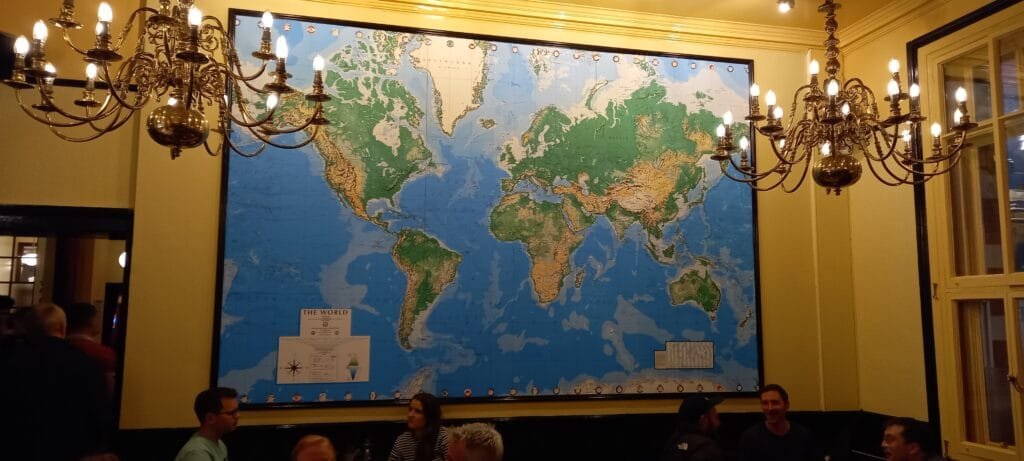
Berl sent me this, he said “Seen on one of the walls of the ‘Leyton Engineer’ pub in East London in what used to be Leyton Town Hall. I was on my way to see a Leyton Orient game and popped in to have a bite to eat and a tipple and meet my son.”
Glad to see that Leyton Council had such a global view.
For those of our readers who don’t know of Leyton Orient, they are a football club based in East London. The name apparently came about as a suggestion from one of their players, Jack R Dearing, who had worked on the Orient Stream Navigation Company (otherwise known as the Orient Line).
-
sur Sean Gillies: Mastodon #20albums
Publié: 15 October 2024, 6:15am CEST
There was this trend a few weeks ago on Mastodon where once a day, for 20 days, you posted the cover of an album that was, for whatever reason, a big deal in your life. I really got into it, thanks to Ed Summers.
20 albums are threaded in the link below. They are in an order that is kind of chronological, enough that you can see me evolve from teenage headbanger to aging hipster.
Post by @sgillies@mastodon.social View on Mastodon
-
sur Mappery: Chart of Knowledge
Publié: 14 October 2024, 1:00pm CEST
Pièce jointe: [télécharger]
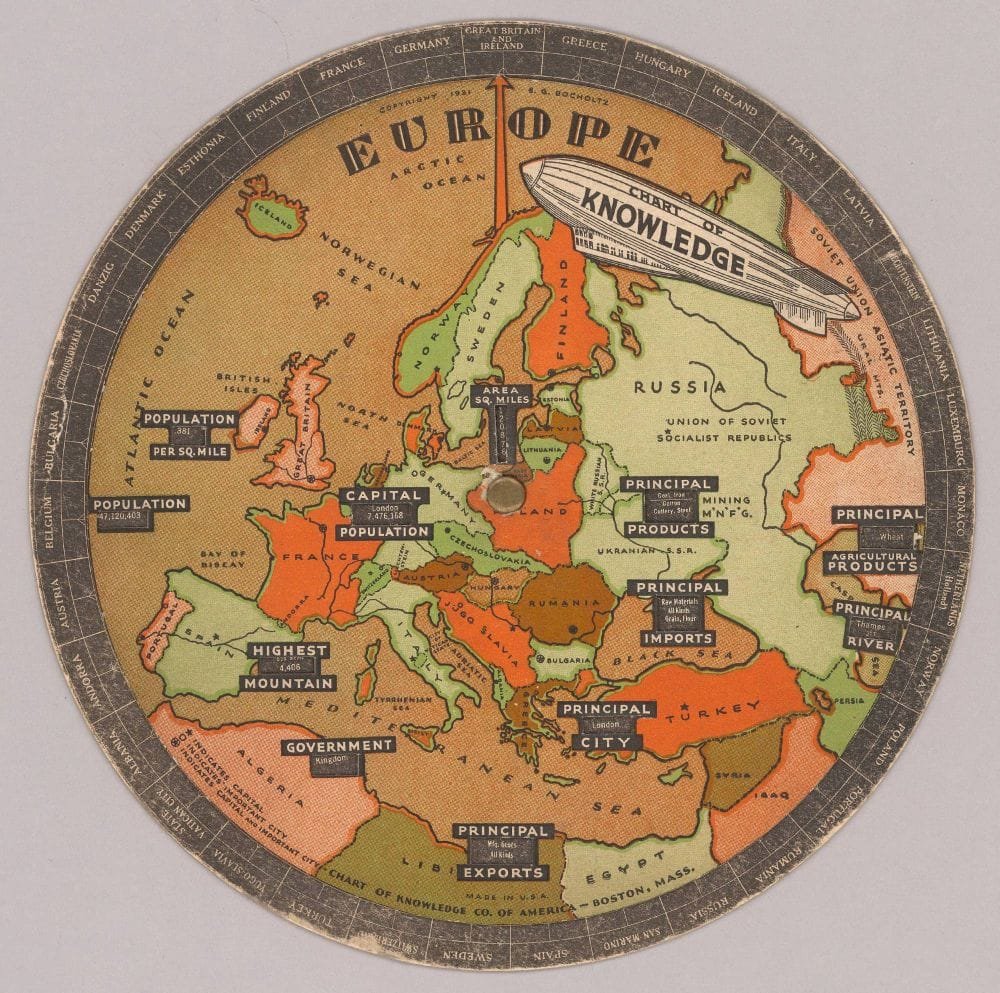
Monsieur LeCartograhe, now also on BlueSky, shared this Chart of Knowledge, 1931 – Bocholtz, S.G.
-
sur GeoSolutions: FREE Webinar: GeoServer 2.26.0 and Beyond
Publié: 14 October 2024, 10:42am CEST
You must be logged into the site to view this content.
-
sur QMapOD opensourced !
Publié: 14 October 2024, 8:44am CEST par Christophe Damour
Pièce jointe: [télécharger]
 QMapOD est la version 2 de l’application MapOD, initialement développée sous Access et ArcGis / MapInfo.
QMapOD est la version 2 de l’application MapOD, initialement développée sous Access et ArcGis / MapInfo.Elle se présente comme une extension (plugin) du système d’information géographique et s’appuie sur une base de données spatiale SQLite / SpatiaLite. La version 2 de QMapOD apporte la compatibilité avec QGIS 3.x.
Elle permet de cartographier les résultats d’enquêtes origine / destination réalisées sur un réseau de transport en commun, en réalisant des filtrages multicritères sur un jeu de données d’enquêtes, puis en élaborant des analyses cartographiques à partir des données filtrées.Initialement développée par SIGéal, QMapOD est désormais maintenue par Oslandia, et financée par Test-SA et Oslandia.
QGIS et QMapOD sont diffusés sous licence opensource (GNU General Public License).
 La publication par Oslandia de QMapOD sur le portail officiel des plugins QGIS a pour objectif d’attirer de nouveaux contributeurs et/ou de nouveaux financeurs pour accélérer le développement de nouvelles fonctionnalités et améliorer la fiabilité de l’extension.
La publication par Oslandia de QMapOD sur le portail officiel des plugins QGIS a pour objectif d’attirer de nouveaux contributeurs et/ou de nouveaux financeurs pour accélérer le développement de nouvelles fonctionnalités et améliorer la fiabilité de l’extension.
Cette publication a d’ores et déjà permis d’industrialiser le code de l’extension en l’alignant sur les normes habituellement utilisées par les développeurs Oslandiens, et en ajoutant au dépôt gitlab des fonctionnalités de CI/CD qui contribuent à fiabiliser le code produit.
-
sur Mappery: A Street Guide that is not Mobile
Publié: 13 October 2024, 1:00pm CEST
Pièce jointe: [télécharger]
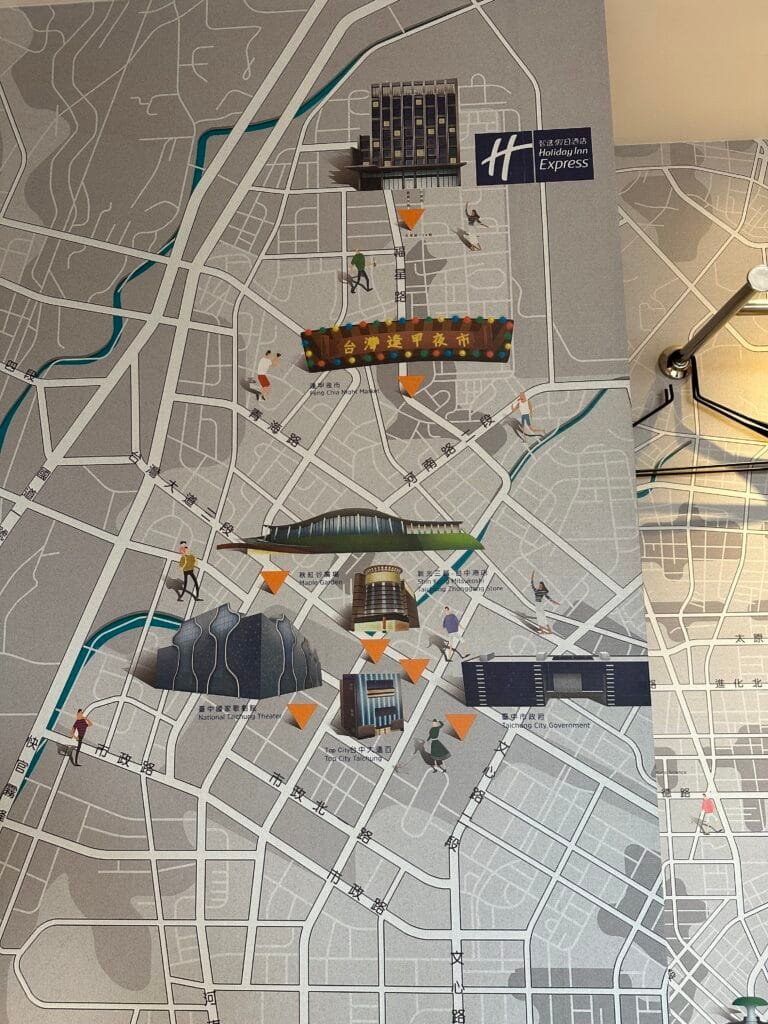
Scott Simmons found this street guide in his hotel, “Just got into my room in Taichung, Taiwan and found the wall to be a handy guide. Problem is, I cannot easily carry the wall into the streets, so the picture will have to do. This hotel is just a few blocks from GIS.FCU (GIS Research Center at Feng Chia University), a huge contributor to international standardization ( [https:]] ).”
I wonder what the thinking was to use this street map as decoration?
-
sur Sean Gillies: Running again
Publié: 13 October 2024, 3:51am CEST
After I gave up on The Bear 100 and Black Squirrel in August, I stopped running for 6 weeks to let my Achilles tendonitis subside. I quit using the stair stepper and elliptical machines at the gym, too. My only activities were bike commuting, yoga, weight lifting, and a weekly "HIIT the water" class. I've joked about aquasizing, but have really been getting into this class. The instructor is gung ho, the regulars are friendly, and it's a good, low impact, workout. I'm going to keep doing it this fall and winter, for sure.
On the 20th of September I went for a flat 2 mile run at Pineridge Open Space. It felt great to run outdoors on dirt, and I didn't feel any worse afterwards. I did another easy, flat trail run 4 days later. This week I did two 3.5 mile runs on trails and another session on an elliptical trainer. 2 hours in all. I'm going to try to increase to 3 hours a week by the end of the year.
I'm grateful to be able to run again. With some luck, 2025 could be a good year.
-
sur Mappery: Spot the Map
Publié: 12 October 2024, 1:00pm CEST
Pièce jointe: [télécharger]

Reinder sent this pic of a shop window in Mafra in Portugal. He said there is quite a lot of Mappery in there. I found 6 and maybe 7, how about you?
-
sur Sean Gillies: Rasterio 1.4.0
Publié: 12 October 2024, 5:35am CEST
A month ago I wrote a long-ish post about Fiona 1.10.0. I'll try to keep this one shorter. Rasterio 1.4.0 has three main changes: Python openers, detailed error chaining, and a new statistics API.
Python openers can connect filesystems implemented in Python, like fsspec or tiledb.vfs, to GDAL's own virtual filesystem machinery. In most cases, you should reply on GDAL's built-in virtual filesystem handlers. On the other hand, if you have unique or proprietary data access protocols, then Rasterio's new openers may be useful.
Often enough, I want more visibility into the errors that occur during GDAL I/O functions. I'd like to see all the errors, not just the last one. So, I've implemented Python-like chaining of GDAL errors. It's not perfectly analogous, because we don't have frames for GDAL code like we do for Python, but look at the kind of details you can get now:
>>> src.read() rasterio._err.CPLE_AppDefinedError: TIFFFillTile:Read error at row 512, col 0, tile 3; got 38232 bytes, expected 47086 The above exception was the direct cause of the following exception: rasterio._err.CPLE_AppDefinedError: TIFFReadEncodedTile() failed. The above exception was the direct cause of the following exception: Traceback (most recent call last): File "rasterio/_io.pyx", line 968, in rasterio._io.DatasetReaderBase._read io_multi_band(self._hds, 0, xoff, yoff, width, height, out, indexes_arr, resampling=resampling) File "rasterio/_io.pyx", line 207, in rasterio._io.io_multi_band with stack_errors() as checker: File "rasterio/_io.pyx", line 213, in rasterio._io.io_multi_band return checker.exc_wrap_int(retval) File "rasterio/_err.pyx", line 307, in rasterio._err.StackChecker.exc_wrap_int raise last rasterio._err.CPLE_AppDefinedError: /app/tests/data/corrupt.tif, band 1: IReadBlock failed at X offset 1, Y offset 1: TIFFReadEncodedTile() failed. The above exception was the direct cause of the following exception: Traceback (most recent call last): File "<console>", line 1, in <module> File "rasterio/_io.pyx", line 650, in rasterio._io.DatasetReaderBase.read out = self._read(indexes, out, window, dtype, resampling=resampling) File "rasterio/_io.pyx", line 971, in rasterio._io.DatasetReaderBase._read raise RasterioIOError("Read or write failed. See context for details.") from cplerr rasterio.errors.RasterioIOError: Read or write failed. See context for details.
Lastly, the flawed, multimodal
statistics()method of datasets has been deprecated and is replaced by new, simplerstats(),clear_stats(), andupdate_stats()methods.Rasterio 1.4.0 remains limited to "classical" rasters, those with a handful of bands or channels all of the same type. For hyperspectral data cubes and the like, you should use h5py, xarray, or other emerging software. I'm quite interested in working on new software in that area, but I'd like to do so without any classical raster legacy.
-
sur Mappery: Arctic Circle
Publié: 11 October 2024, 1:00pm CEST
Pièce jointe: [télécharger]

Matthew Edney sent us this, he said “My father in law at the Arctic Circle, in Dalton, Alaska, the dot for the location is right by his head”
Pretty Cool
-
sur WhereGroup: Treffen der QGIS-Gemeinschaft in Bratislava
Publié: 11 October 2024, 12:00pm CEST
Unser Kollege Johannes Kröger besuchte auch dieses Jahr die QGIS User Conference und fasst hier voller Enthusiasmus seine Highlights zusammen. -
sur TorchGeo: v0.6.1
Publié: 10 October 2024, 10:22pm CEST
TorchGeo 0.6.1 Release NotesThis is a bugfix release. There are no new features or API changes with respect to the 0.6.0 release.
This release fixes an important security vulnerability and properly documents a lack of support for rasterio 1.4. All users are recommended to update to TorchGeo 0.6.1 if they are using
Dependenciestorchgeo.models.get_weight.- rasterio: 1.4 not yet supported (#2327)
- Datamodule: use persistent workers for parallel data loading (#2291)
- OSCD: update normalization statistics (#2282)
- Datasets: add support for
os.PathLike(#2273) - GeoDataset: allow a mix of
strandpathlibpaths (#2270)
- API: avoid use of
evalinget_weight(#2323)
- CD: set up continuous deployment to PyPI (#2342)
- CI: install tensorboard to speed up notebooks (#2315)
- CI: install TorchGeo from checked out repo (#2306)
- dependabot: only update npm lockfile (#2277)
- prettier: ignore cache directories (#2278)
- prettier: prefer single quotes (#2280)
- pytest: set default
--covand--cov-report(#2275) - pytest: set matplotlib backend locally too (#2326)
- pytest: silence numpy 2 warnings in PyTorch (#2302)
- ruff: remove NPY tests now that we test numpy 2 in CI (#2287)
- Alternatives: add scikit-eo to list of TorchGeo alternatives (#2340)
- Contributing: installation-agnostic prettier usage (#2279)
- Datasets: move dataset CSV to subdirectory (#2281, #2304)
- Datasets: update NAIP resolution (#2325)
- Tutorials: fix NAIP downloads by signing URL (#2343)
- Tutorials: update recommended strategy for raster datasets containing images and masks (#2293)
This release is thanks to the following contributors:
@adamjstewart
@calebrob6
@MathiasBaumgartinger
@Nowosad
@sfalkena -
sur Mappery: Samsonite is a Global Brand
Publié: 10 October 2024, 1:00pm CEST
Pièce jointe: [télécharger]

Spotted by Reinder ” in a street with many shops in The Hague, it’s Wednesday throwing away cardboard boxes day”
-
sur Classifications et intensités de nuages de points dans Giro3D
Publié: 10 October 2024, 8:35am CEST par Sébastien Guimmara
Pièce jointe: [télécharger]
Cet article concerne des fonctionnalités publiées avec la version 0.37 de Giro3D.
Giro3D 0.37 a introduit le support des classifications et intensités pour les nuages de points.
Les classifications de nuages de pointsAprès acquisitions par un capteur LIDAR, chaque point peut se voir attribuer une classe (ou classification) déterminant sa nature: sol, végétation, bâtiment, etc.
Les points peuvent ensuite être manipulées indépendamment lors de traitement (filtrage, colorisation, etc) selon leur classe.
Quels formats supportent les classifications ?De nombreux formats supportent cette fonctionnalités. Sur le Web Open-Source, les principaux formats utilisés sont les suivants:
Afficher les classifications dans Giro3DVoir l’exemple détaillé sur le site de Giro3D.
Actuellement, Giro3D supporte les classifications via l’entité Tiles3D, permettant d’afficher des nuages de points après conversion au format 3D Tiles.
Le support du format COPC est en cours de développement et supportera également les classifications. Il également prévu d’ajouter le support du format Potree 2.0.
Sélection de la couleur et de la visibilitéChaque classification est composée d’une couleur et d’une visibilité. Par défaut, toutes les classifications sont visibles. Les classifications 0 à 18 ont des couleurs pré-définies dans Giro3D (mais modifiables).
Dans l’exemple classification">[https:] , il est ainsi possible de modifier les couleurs et visibilité de chaque classification dynamiquement.
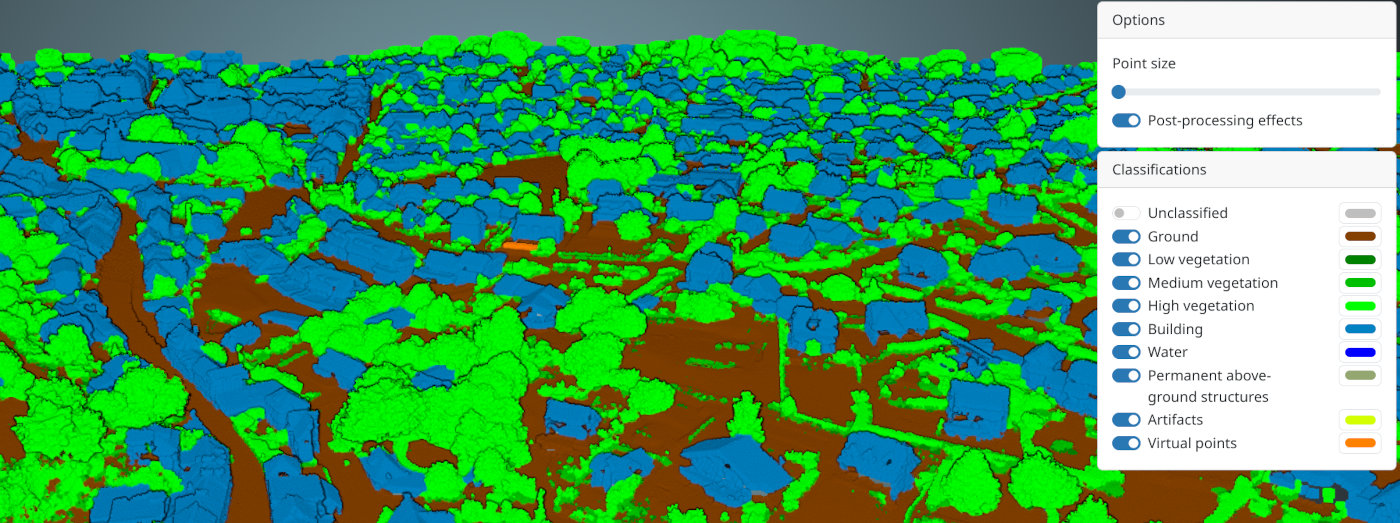
Nuages de points classifiés
Les intensitésVoir l’exemple complet sur le site Giro3D.
L’intensité d’un point est une valeur numérique décrivant la quantité d’énergie réfléchie par la surface (et donc la quantité absorbée). Dans une scène lidar typique, les arbres absorbent plus d’énergie laser que les champs agricoles par exemple, ce qui leur donnera une intensité moindre.
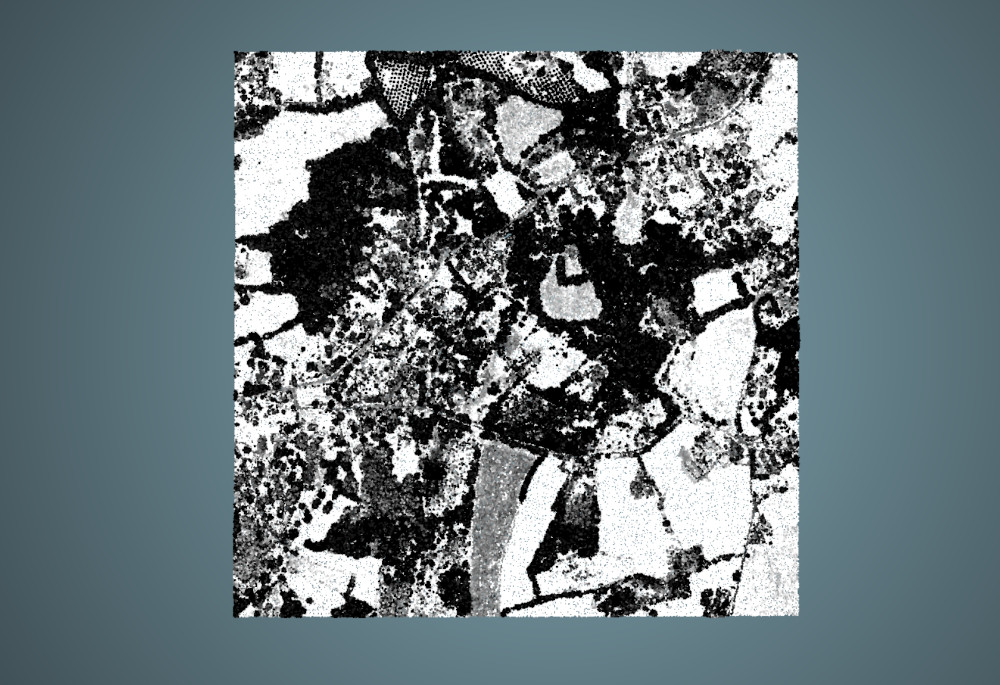
L’intensité des champs est plus importante que celle des arbres
Dans Giro3D, l’interprétation des valeurs d’intensité passe par une rampe de couleurs (ColorMap).
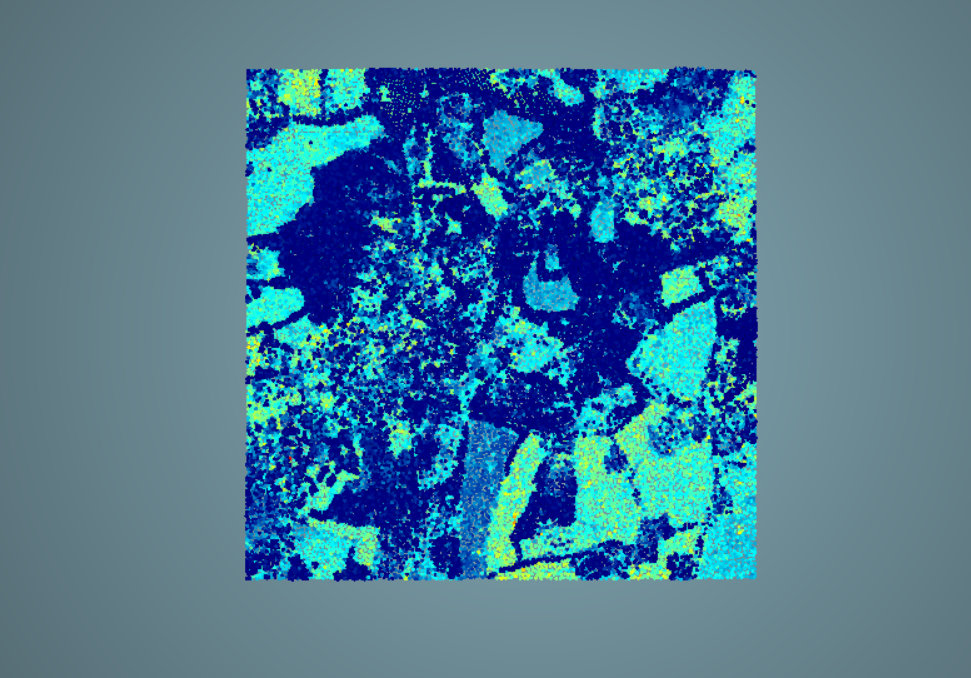
Le même nuage de point avec une rampe de couleur différente
Les opacités variablesLes rampes de couleurs Giro3D supportent des opacités variables. Chaque couleur de la rampe de couleur peut également être associé à un valeur d’opacité (de 0 à 1), indiquant le degré de transparence de cette couleur.
Cela permet par exemple de rendre semi-transparente ou invisibles certaines valeur d’intensité, comme les arbres:
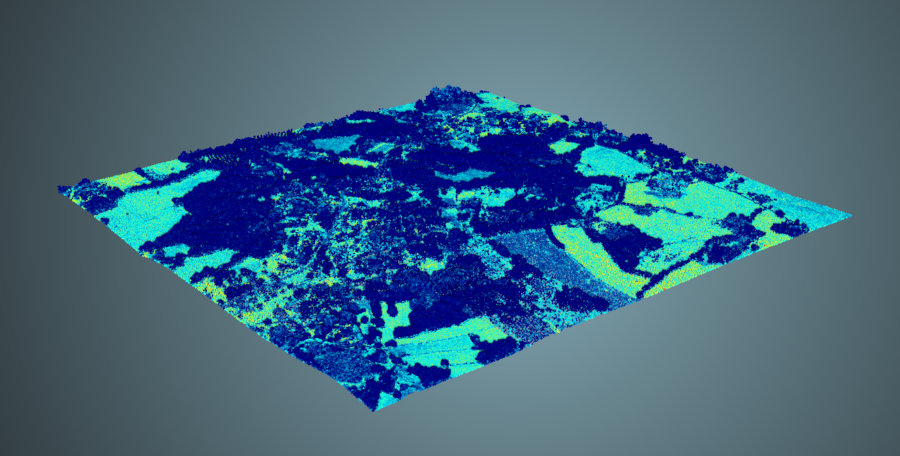
Le nuage de point par défaut.
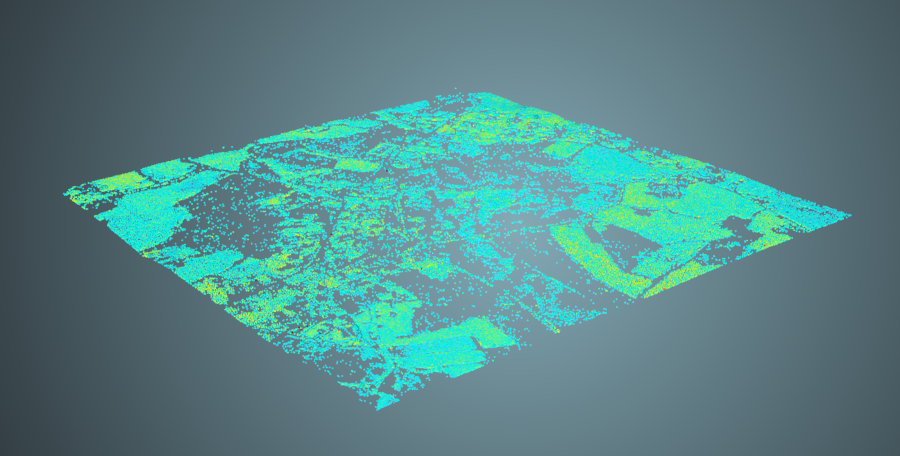
Les intensités inférieure à un seuil sont masquées, masquant les arbres.
-
sur OTB Team: OTB User Days 2024
Publié: 9 October 2024, 6:46pm CEST
Dear all, The OTB User Days 2024 will be held from November 21th to November 22th in Toulouse, France. The event will be held at Artilect Fablab On November 21th, presentations will be held in the morning, and brainstorming in the afternoon : On November 22th : Please register here if you plan to come and you […]
-
sur Sortie de QField 3.4 « Ebo »
Publié: 9 October 2024, 5:00pm CEST par Vincent Picavet
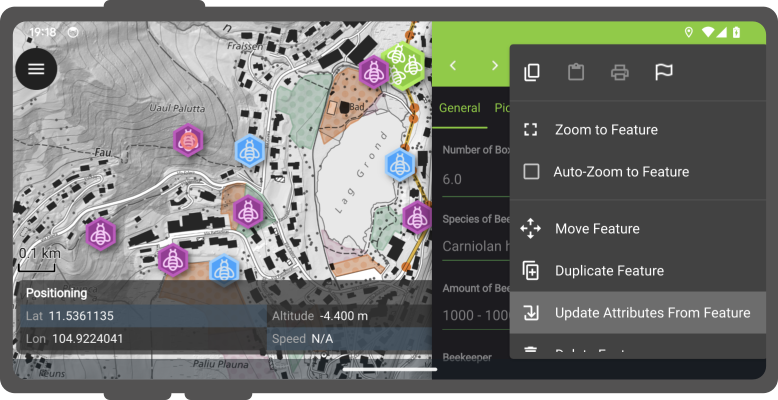
Oslandia est le partenaire principal d’OPENGIS.ch pour QField. Nous sommes fiers aujourd’hui de relayer l’annonce de la nouvelle version 3.4 « Ebo » de QField. Cette version introduit le « Geofencing » et le support d’algorithmes de traitements.
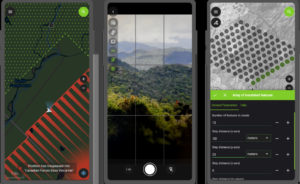 Geofencing
Geofencing
Un nouveau framework pour le « Geofencing » est arrivé, qui permet aux utilisateurs de configurer le comportement de QField avec des zones-barrières. En fonction de la géolocalisation de l’utilisateur et des zones-barrières définies, QField va pouvoir afficher des alertes ou autoriser l’édition. Les zones-barrières sont définies au niveau du projet, par l’intermédiaire de polygones d’une couche vectorielle. Il existe trois options de comportement de geofencing dans cette version de QField :
- Alerter l’utilisateur lorsqu’il est à l’intérieur d’une zone définie
- Alerter l’utilisateur lorsqu’il est à l’extérieur de toutes les zones définies
- Informer l’utilisateur lorsqu’il entre ou sort d’une zone polygonale donnée
En plus de l’alerte ou l’information, les utilisateurs peuvent aussi configurer QField pour que l’édition soit désactivée lorsqu’ils sont à l’intérieur d’une zone ou à l’extérieur des zones définies. La configuration de cette fonctionnalité se fait dans QGIS par le plugin QFieldSync.
Traitement des objets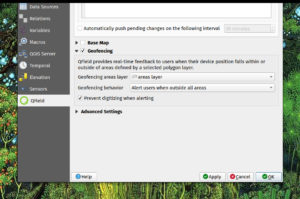
QField offre également dans cette version un accès aux algorithmes de traitements géométriques. Une « processing toolbox » qui contient plus d’une dizaine d’algorithmes est accessible directement dans QField, et permet de manipuler les géométries numérisées sur le terrain. Cette fonctionnalité repose sur le cœur de QGIS, plus particulièrement sur le framework Processing de QGIS et les nombreux algorithmes disponibles dans ce module.
La disponibilité de ces algorithmes dans QField ouvre la porte à de nombreuses nouvelles possibilités pour la modification des géométries : orthogonalisation, lissage, tampon, rotation, transformation affine, etc. Lorsque l’utilisateur configure les paramètres d’un algorithme, une prévisualisation en grisé de la sortie est visible en surimpression du canevas de carte.
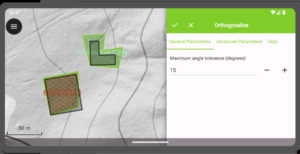
Pour accéder à la boîte de traitement de QField, sélectionnez un ou plusieurs objets avec une pression longue dans la liste des objets de la carte, ouvrez le menu à 3 points et cliquez sur l’action « Traiter les objets sélectionnés ».
Si cette fonctionnalité vous plaît, vous pouvez remercier le National Land Survey of Finland, qui a financé ces développements.
Améliorations de la caméraLa caméra de QField a de nouvelles fonctionnalités : les ratios et dimensions des photos sont personnalisables. Elle permet également d’incruster dans la photo capturée les éléments de date de captation, et de localisation. Les dernières versions de QField ont largement amélioré la fonctionnalité de caméra QField, de telle sorte que c’est désormais la solution par défaut dans QField pour la prise de vue. Les utilisateurs peuvent toujours désactiver cette caméra pour utiliser la caméra native de leur système.
.. et toujours plusDe nombreux autres développements ont vu le jour pour cette version, tel que l’édition des variables projet par un éditeur, l’intégration de la documentation dans la barre de recherche, ou la possibilité de rechercher dans la liste des projets cloud. Toutes ces fonctionnalités sont détaillées dans le Changelog complet de la 3.4.
À votre tour !Vous avez des questions sur QField ? Intéressés par sa mise en œuvre, n’hésitez pas à contacter Oslandia !
-
sur Oslandia: (Fr) Du nouveau pour [CityBuilder] CityForge
Publié: 9 October 2024, 1:04pm CEST
Sorry, this entry is only available in French.
-
sur Mappery: Gordon the Globe
Publié: 9 October 2024, 1:00pm CEST
Pièce jointe: [télécharger]

Elizabeth spotted this advert on the London Underground. Is Gordon smiling or shocked or ..?
-
sur Oslandia: New release for QField : 3.4 “Ebo”
Publié: 8 October 2024, 7:46pm CEST
Oslandia is the main partner of OPENGIS.ch around QField. We are proud today to forward the announcement of the new QField release 3.4 “Ebo”.
Main highlights
A new geofencing framework has landed, enabling users to configure QField behaviors in relation to geofenced areas and user positioning. Geofenced areas are defined at the project-level and shaped by polygons from a chosen vector layer. The three available geofencing behaviours in this new release are:
- Alert user when inside an area polygon;
- Alert user when outside all defined area polygons and
- Inform the user when entering and leaving an area polygons.
In addition to being alerted or informed, users can also prevent digitizing of features when being alerted by the first or second behaviour. The configuration of this functionality is done in QGIS using QFieldSync.

Pro tip: geofencing settings are embedded within projects, which means it is easy to deploy these constraints to a team of field workers through QFieldCloud. Thanks Terrex Seismic for sponsoring this functionality.
QField now offers users access to a brand new processing toolbox containing over a dozen algorithms for manipulating digitized geometries directly in the field. As with many parts of QField, this feature relies on QGIS’ core library, namely its processing framework and the numerous, well-maintained algorithms it comes with.
The algorithms exposed in QField unlock many useful functionalities for refining geometries, including orthogonalization, smoothing, buffering, rotation, affine transformation, etc. As users configure algorithms’ parameters, a grey preview of the output will be visible as an overlay on top of the map canvas.

To reach the processing toolbox in QField, select one or more features by long-pressing on them in the features list, open the 3-dot menu and click on the process selected feature(s) action. Are you excited about this one? Send your thanks to the National Land Survey of Finland, who’s support made this a reality.
QField’s camera has gained support for customized ratio and resolution of photos, as well as the ability to stamp details – date and time as well as location details – onto captured photos. In fact, QField’s own camera has received so much attention in the last few releases that it was decided to make it the default one. On supported platforms, users can switch to their OS camera by disabling the native camera option found at the bottom of the QField settings’ general tab.
Wait, there’s moreThere are plenty more improvements packed into this release from project variables editing using a revamped variables editor through to integration of QField documentation help in the search bar and the ability to search cloud project lists. Read the full 3.4 changelog to know more, and enjoy the release!
Contact us !A question concerning QField ? Interested in QField deployment ? Do not hesitate to contact Oslandia to discuss your project !
-
sur Mappery: The Map Shop
Publié: 8 October 2024, 1:00pm CEST
Pièce jointe: [télécharger]

Reinder spotted this selection of maps for sale in a souvenir shop at Wawel Castle, Cracow, Poland. They like a map there!

-
sur OPENGIS.ch: QField 3.4 “Ebo”: Geofencing and processing out of the box
Publié: 8 October 2024, 8:45am CEST
QField 3.4 is out, and it won’t disappoint. It has tons of new features that continue to push the limits of what users can do in the field.
Main highlights
A new geofencing framework has landed, enabling users to configure QField behaviors in relation to geofenced areas and user positioning. Geofenced areas are defined at the project-level and shaped by polygons from a chosen vector layer. The three available geofencing behaviours in this new release are:- Alert user when inside an area polygon;
- Alert user when outside all defined area polygons and
- Inform the user when entering and leaving an area polygons.
In addition to being alerted or informed, users can also prevent digitizing of features when being alerted by the first or second behaviour. The configuration of this functionality is done in QGIS using QFieldSync.

Pro tip: geofencing settings are embedded within projects, which means it is easy to deploy these constraints to a team of field workers through QFieldCloud. Thanks Terrex Seismic for sponsoring this functionality.
QField now offers users access to a brand new processing toolbox containing over a dozen algorithms for manipulating digitized geometries directly in the field. As with many parts of QField, this feature relies on QGIS’ core library, namely its processing framework and the numerous, well-maintained algorithms it comes with.
The algorithms exposed in QField unlock many useful functionalities for refining geometries, including orthogonalization, smoothing, buffering, rotation, affine transformation, etc. As users configure algorithms’ parameters, a grey preview of the output will be visible as an overlay on top of the map canvas.

To reach the processing toolbox in QField, select one or more features by long-pressing on them in the features list, open the 3-dot menu and click on the process selected feature(s) action. Are you excited about this one? Send your thanks to the National Land Survey of Finland, who’s support made this a reality.
QField’s camera has gained support for customized ratio and resolution of photos, as well as the ability to stamp details – date and time as well as location details – onto captured photos. In fact, QField’s own camera has received so much attention in the last few releases that we have decided to make it the default one. On supported platforms, users can switch to their OS camera by disabling the native camera option found at the bottom of the QField settings’ general tab.
Wait, there’s moreThere are plenty more improvements packed into this release from project variables editing using a revamped variables editor through to integration of QField documentation help in the search bar and the ability to search cloud project lists. Read the full 3.4 changelog to know more, and enjoy the release!
-
sur QGIS Blog: Plugin Update – September, 2024
Publié: 7 October 2024, 8:49pm CEST
In September a total of 20 new plugins were published in the QGIS plugin repository.
HighlightIn the last month some AI-related plugins became available for users, namely IntelliGeo and TreeEyed, which in addition to the increasing number of tools, greatly contribute for the adaptation of QGIS to current and future needs, showcasing it as one of the best options for beginners and experts alike to conduct a number of geospatial analyses.
As stated by their authors, with IntelliGeo there’s a chat interface where users can detail their requests, and the output is either a PyQGIS code or a graphical processing model, which can in turn be executed directly in QGIS.

As for the TreeEyed plugin, its main objective is the monitoring of trees by generating vector and raster datasets from high resolution RGB imagery.
 Overview
Overview
Here follows the quick overview in reverse chronological order. If any of the names or short descriptions catches your attention, you can find the direct link to the plugin page in the table below:
Project Setup Sets up a QGIS project to my personal specs. Continuous Network Analysis (Processing) Processing plugin that adds several scripts to assist in decision making and validation of line-type vector networks by generating inconsistencies, further expanding the “Network Analysis” tool. Oslandia Official plugin for Oslandia customers. Reach Enables the use of real transit time as a spatial predicate for selects and joins. Data Clock Polar plot of seasonal data. QGIS Light QGIS made simple – a light user interface for core GIS functions. Attribute Searcher A minimalistic plugin to search for values in attributes quick and easy. Topo Maps ????????Generate Topographic Maps. IntelliGeo IntelliGeo is QGIS plugin that facilitates interaction with Large Language Models in QGIS environment. CartAGen Cartographic generalization. RiverBankErosionAndAccretion This plugin calculates the erosion and accretion along a river’s course. VectorStats Plugin for descriptive and statistical analysis of vectors, with chart generation. Jilin1Info(2023) 2023???50cm???????????? Historique Parcelle Historique des parcelles (cadastre français). String Writer Writes QGIS layers to Surpac string file format. TreeEyed TreeEyed is a QGIS plugin for tree monitoring using AI. SHP Buddy Quickly create shapefiles for breeding experiments. TEKSI Wastewater TEKSI Wastewater plugin to manage wastewater networks. KGR Finder By simply drawing polygons or clicking on existing polygons, this extension makes it possible to download data from OpenStreetMap (OSM) or the iDAI.gazetteer and display it on the map, including all existing attributes. The plugin is designed so that other services can also be easily integrated in the future. layer_style_master This QGIS plugin copies symbology, labels, and rendering settings from one layer to multiple other layers. -
sur Mappery: Hannoverian Bumper Sticker
Publié: 7 October 2024, 1:00pm CEST
Pièce jointe: [télécharger]

Marc-Tobias shared this. I like that Hannover becomes the centre of the world.

-
sur Free and Open Source GIS Ramblings: LLM-based spatial analysis assistants for QGIS
Publié: 6 October 2024, 11:25pm CEST
After the initial ChatGPT hype in 2023 (when we saw the first LLM-backed QGIS plugins, e.g. QChatGPT and QGPT Agent), there has been a notable slump in new development. As far as I can tell, none of the early plugins are actively maintained anymore. They were nice tech demos but with limited utility.
However, in the last month, I saw two new approaches for combining LLMs with QGIS that I want to share in this post:
IntelliGeo plugin: generating PyQGIS scripts or graphical modelsAt the QGIS User Conference in Bratislava, I had the pleasure to attend the “Large Language Models and GIS” workshop presented by Gustavo Garcia and Zehao Lu from the the University of Twente. There, they presented the IntelliGeo Plugin which enables the automatic generation of PyQGIS scripts and graphical models.
The workshop was packed. After we installed all dependencies and the plugin, it was exciting to test the graphical model generation capabilities. During the workshop, we used OpenAI’s API but the readme also mentions support for Cohere.
I was surprised to learn that even simple graphical models are actually pretty large files. This makes it very challenging to generate and/or modify models because they take up a big part of the LLM’s context window. Therefore, I expect that the PyQGIS script generation will be easier to achieve. But, of course, model generation would be even more impressive and useful since models are easier to edit for most users than code.
 Image source: https://github.com/MahdiFarnaghi/intelli_geo
ChatGeoAI: chat with PyQGIS
Image source: https://github.com/MahdiFarnaghi/intelli_geo
ChatGeoAI: chat with PyQGIS
ChatGeoAI is an approach presented in Mansourian, A.; Oucheikh, R. (2024). ChatGeoAI: Enabling Geospatial Analysis for Public through Natural Language, with Large Language Models. ISPRS Int. J. Geo-Inf., 13, 348.
It uses a fine-tuned Llama 2 model in combination with spaCy for entity recognition and WorldKG ontology to write PyQGIS code that can perform a variety of different geospatial analysis tasks on OpenStreetMap data.
The paper is very interesting, describing the LLM fine-tuning, integration with QGIS, and evaluation of the generated code using different metrics. However, as far as I can tell, the tool is not publicly available and, therefore, cannot be tested.
 Image source: [https:]]
Image source: [https:]]
Are you aware of more examples that integrate QGIS with LLMs? Please share them in the comments below. I’d love to hear about them.
-
sur Mappery: Johannes Kepler
Publié: 6 October 2024, 1:00pm CEST
Pièce jointe: [télécharger]

This portrait of Johannes Kepler was spotted by Reinder at the Collegium Maius in Cracow. Don’t you love the way old paintings so often have a globe or a map in the background (presumably a symbol of status)?
-
sur Mappery: Fire Finding with an Alidade
Publié: 5 October 2024, 1:00pm CEST
Pièce jointe: [télécharger]

Have you heard of an alidade? I hadn’t until Walter Schwartz sent me these pics.
He said “Behold the ingenious alidade, a surveying instrument here used as a fire finder. This one is displayed at the Cole Land Transportation Museum in Bangor, Maine. Forest rangers used these atop fire towers to report the distance and, in conjunction with another tower, the coordinates of fires. The map on this table covers an approximately 25 mile diameter (40 KM) inclusive of Augusta to Rockport Maine. The user viewed through a rectangular slot on one upright and rotated the metal structure to view the fire. Some tables were on slides so that the view would not be obstructed by parts of the tower structure. GPS and cameras solve the same problem today. “
Well who knew that? I found this great explanation of the alidade.

-
sur OSGeo Announcements: [OSGeo-Announce] FOSS4G 2022 Firenze (Italy) recordings are online
Publié: 4 October 2024, 7:49pm CEST
see news item: FOSS4G 2022 Firenze (Italy) recordings are online - OSGeo
FOSS4G 2022 has been a great event Firenze (Italy). The videos are now published on Youtube.
We hope you will enjoy them.
You find the videos of the talks at our FOSS4G Youtube Channel.
355 videos were uploaded.
We hope you like the videos and get valuable information. We would like to spread the world and we hope you will learn about our great software and our community.
We would like to thank all people involved organizing FOSS4G 2022.
About OSGeo
-------------------
The Open Source Geospatial Foundation (OSGeo) [13] is a non-profit organization dedicated to the development and promotion of open-source geospatial technologies and data. OSGeo serves as an umbrella organization for the collaborative development of open source geospatial software, and provides financial, organizational, and legal support to the broader geospatial community._______________________________________________
Announce mailing list
Announce@lists.osgeo.org
[https:]]1 post - 1 participant
-
sur Markus Neteler: Migration of grass-dev mailing list to OSGeo Discourse
Publié: 4 October 2024, 6:35pm CEST
The post Migration of grass-dev mailing list to OSGeo Discourse appeared first on Markus Neteler Consulting.
-
sur Mappery: Your world at Pied a Terre
Publié: 4 October 2024, 1:00pm CEST
Pièce jointe: [télécharger]

Reeinder said “At the Amsterdam bookstore Scheltema, one can put a post-it on a kind of world map display, to mark the spot where one has been.”
-
sur Les requêtes d’élévation dans Giro3D
Publié: 4 October 2024, 8:27am CEST par Sébastien Guimmara
Pièce jointe: [télécharger]
Cet article concerne des fonctionnalités publiées avec la version 0.36 de Giro3D.
Giro3D 0.36 introduit un système de requêtes d’élévation sur les Maps. Nous allons explorer cette API ainsi que quelques cas d’usages typiques.
Pré-requis: les couches d’élévationPour bénéficier de l’API de requêtes d’élévation, une Map doit être dotée d’une couche d’élévation. Les couches d’élévation peuvent lire des données de sources diverses, comme des GeoTIFF ou des couches tuilées (comme celles fournies par l’IGN ou Mapbox).
Requêter une élévation sur une coordonnéeUne fois notre Map et notre couche d’élévation prêtes, nous pouvons commencer à requêter les élévations. Cela passe par la méthode getElevation().
// Mont-Blanc const coordinates = new Coordinates('EPSG:4326', 6.864594, 45.833641); const elevationResult = map.getElevation({ coordinates });getElevation() ne renvoie pas directement une valeur unique, mais un objet contenant une série d’échantillons (samples). Nous pouvons ordonner ces échantillons par résolution, puis récupérer celui ayant la meilleure résolution.
if (result.samples.length > 0) { result.samples.sort((a, b) => a.resolution - b.resolution); const best = result.samples[0]; const elevation = best.elevation; console.log(`Elevation for coordinate: ${elevation} m`); }Il est ainsi possible de requêter plusieurs Maps simultanément, d’agréger leurs échantillons, puis de récupérer le meilleur.
Requêter plusieurs maps ?Dans un contexte typique, une scène ne contient qu’une seule map. Mais il existe des scénarios ou plusieurs map dotées de données d’élévation sont présentes simultanément dans une scène, voire se chevauchent.
C’est le cas par exemple d’une scène contenant une mosaïque hétérogène de rasters d’élévation (chacun étant réprésenté par une Map). Dans ce cas nous devrons créer un objet pour stocker les résultats plutôt que de laisser getElevation() le faire pour nous, puis requêter toutes les map en leur passant cet objet:
Positionner des labels sur un terrainconst coordinates = new Coordinates('EPSG:4326', 6.864594, 45.833641); const result = { samples: [], coordinates: options.coordinates }; for (const map of allMaps) { map.getElevation({ coordinates }, result); } if (result.samples.length > 0) { result.samples.sort((a, b) => a.resolution - b.resolution); const best = result.samples[0]; const elevation = best.elevation; console.log(`Best sample for coordinate: ${elevation} m`); }Pour en savoir plus, voir l’exemple complet sur le site de Giro3D.
Un cas d’usage typique des requêtes d’élévation est le positionnement de labels sur le terrain. Supposons que nous voulions mettre une label au sommet du Mont-Blanc, mais que nous ne disposions que de sa latitude et longitude et pas son élévation:
const labelObject = new CSS2DObject(/** options */); // Mont-Blanc const coordinates = new Coordinates('EPSG:4326', 6.864594, 45.833641).as('EPSG:3857'); labelObject.position.setX(coordinates.x); labelObject.position.setY(coordinates.y); // ... After elevation query on the coordinates labelObject.position.setZ(elevation);Il est ainsi possible de positionner rapidement un grand nombre d’objets à la surface du terrain.
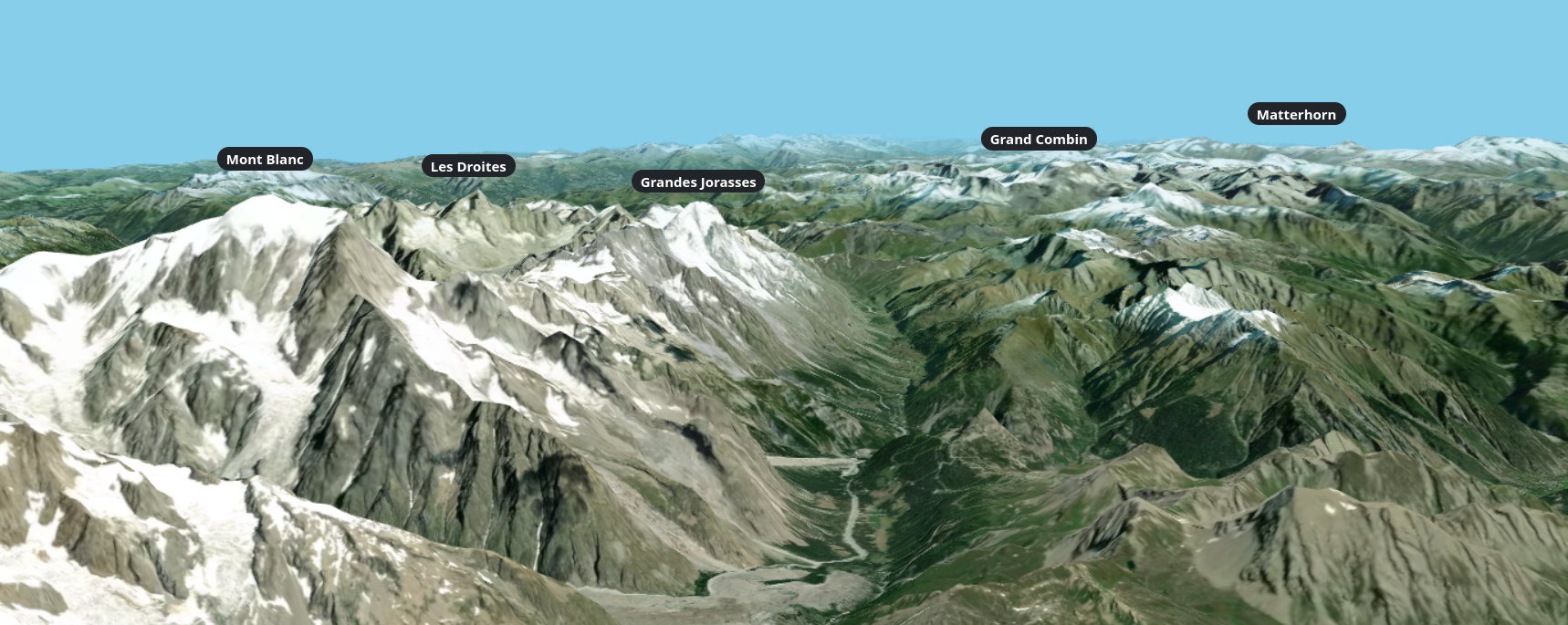
Positionnement de labels sur le terrain
LimitesLa requête d’élévation ne lit que les données actuellement présentes en mémoire, et ne fait aucune requête [HTTP.] Les données chargées dépendent du point de vue actuel : si la caméra est très éloignée du terrain, des données de faible résolution seront chargées. Cela peut avoir un impact sur la qualité du positionnement, notamment lorsque l’on se rapproche.
Pour pallier à ce problème, il suffit de procéder à une nouvelle requête d’élévation lorsque les données actuellement chargées changent. Nous pouvons pour cela ajouter un listener sur l’événement de changement d’élévation de la map, et mettre à jour les labels situées dans la zone de mise à jour (extent).
Créer un profil d’élévationfunction updateLabels(extent) { // Code } map.addEventListener('elevation-changed', ({ extent }) => updateLabels(extent));Pour en savoir plus, voir l’exemple complet sur le site de Giro3D.
Un autre scénario typique faisant usage des requêtes d’élévation est bien sûr le profil d’élévation. Il est relativement simple de créer un profil d’élévation en utilisant 3 composants:
- les requêtes d’élévation
- les outils de dessins Giro3D que nous avons présentés dans un article précédent.
- la librairie chart.js
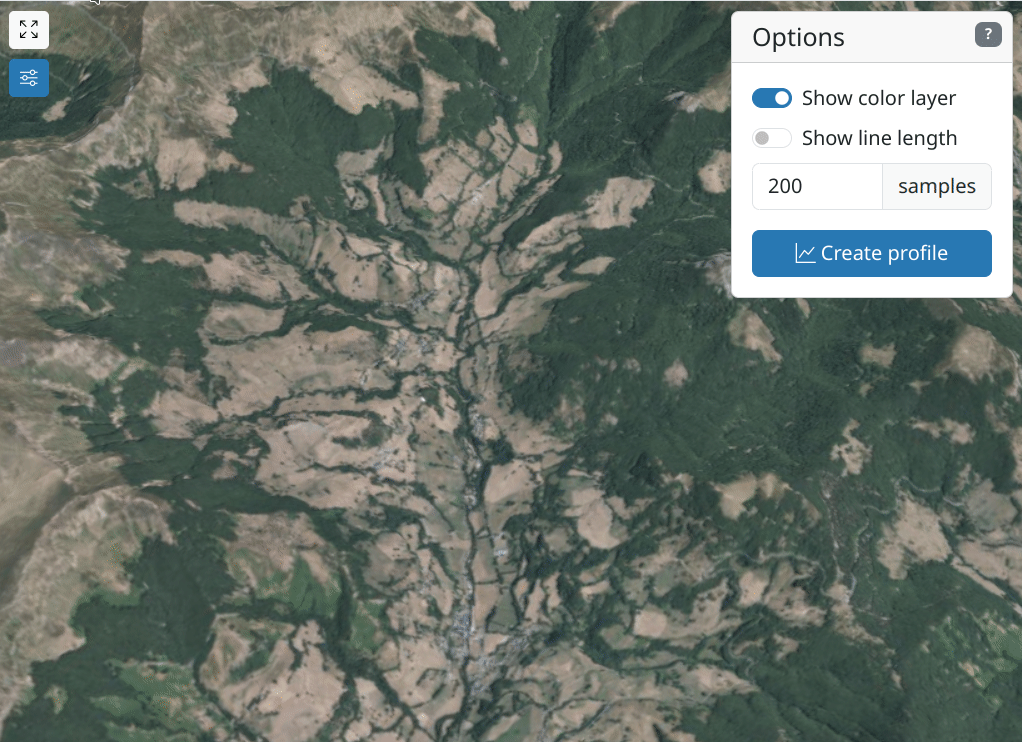
Dessin d’un profil d’élévation
Le profil est créé en requ?tant des dizaines, voire centaines d’élévations en un temps très court (moins d’une seconde généralement).
Bien sûr, les mêmes limites s’appliquent: il s’agit de requêter uniquement les données chargées, et aucune requête HTTP supplémentaire n’est effectuée par Giro3D. Il s’agit donc d’un cas idéal pour fournir aux utilisateurs un aperçu très rapide sans surcharger les serveurs.
Les performancesLes requêtes d’élévation sont généralement très rapides: de l’ordre de la dizaine de millisecondes.
Dans l’exemple Giro3D des profils">[https:] d’élévation, les 200 échantillons sont obtenus en moins de 200 millisecondes. Un profil de 10 000 échantillons est réalisé en moins de 400 millisecondes.
ConclusionLes requêtes d’élévation sont un moyen souple et performant de combler le fossé entre la géomatique 2D et 3D, sans nécessiter de service additionnel de type OGC WPS.
-
sur GeoServer Team: GeoServer 2024 Q4 Developer Update
Publié: 4 October 2024, 4:00am CEST
The GeoServer team working on sharing our roadmap plans plans and providing greater transparency on our community participation and funding goals.
GeoServer Developer ForumIf you have sent email to
geoserver-devellist this week you have been met with the following reply:This list is now closed, join us on geoserver developer forum: [https:]That is right, developer communication has moved to GeoServer Developer on discourse.
- To post join the geoserver-developer group.
- About the GeoServer Developer category has all the details (even email).
- There are improved instructions on how to sign up using github.
How to help:
- Accept the invite - it is quick and easy joining the group and navigate to the forum in one go.
- Update communication details for website and developer guide.
GeoServer 3 Crowdfunding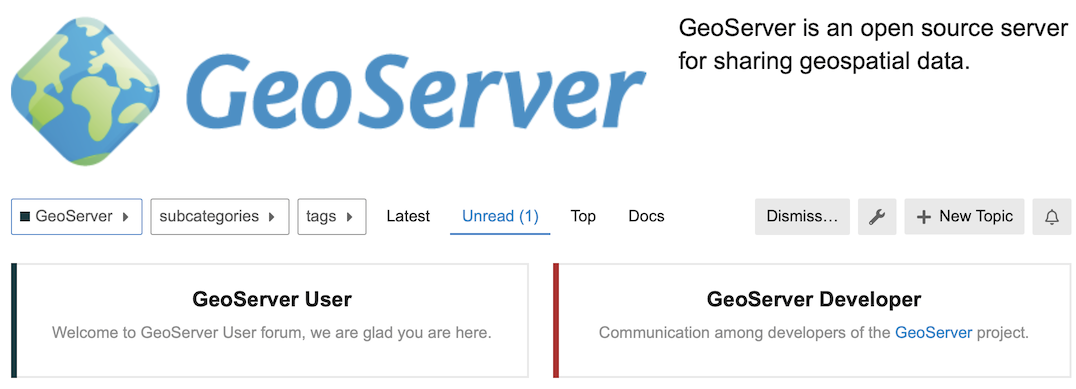
The consortium of Camptocamp, GeoSolutions and GeoCat have responded to our roadmap challenge with a bold GeoServer 3 Call for Crowdfunding established as a multi-party contract.
- The fundraising target has now been set, see updated post, and milestone deliverables established.
- GSIP-226 - GeoServer 3
How to help:
- Share the call for crowdfunding in your region.
- To express your interest or pledge support contact us directly at gs3-funding@googlegroups.com, or via online form.
Wicket 9 upgrade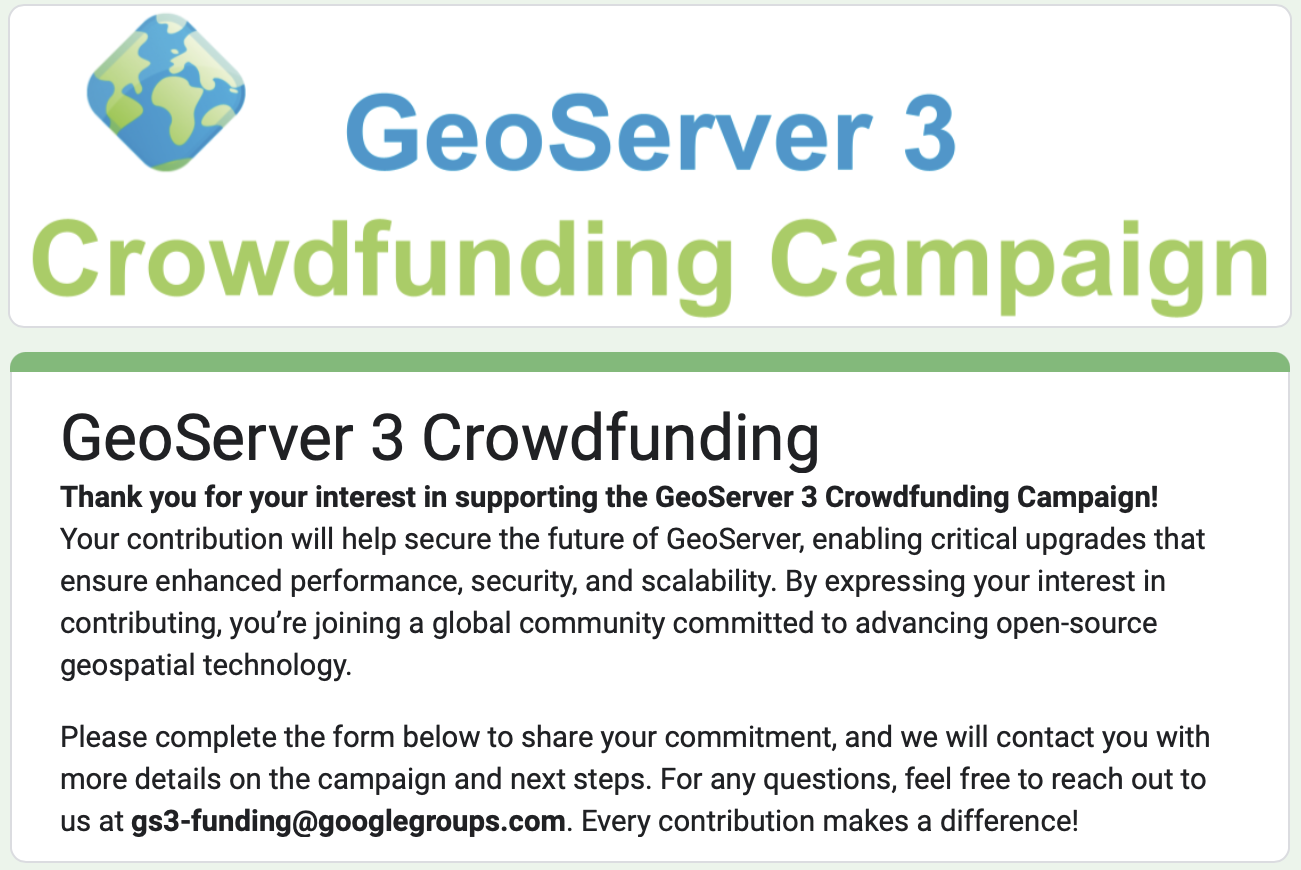
GEOS-11275: Brad and David have made considerable progress on Wicket UI updates. After a year of effort the first results towards Wicket 10 are being merged onto the
mainbranch.Thanks to Brad for doing much of the difficult work starting this activity, and to David for working hard to stabilize this work for testing.
Peter and Jody started a wicket test plan and evaluated an initial 2.26-M0 milestone release.
How to help:
- Test a 2.27.x nightly build, clearly noting problems in the Wicket Test Plan.
- Urgent: Developer assistance is needed to restore JUnit tests for the Wicket modules. Many are failing just due to the contents of the page being slightly altered.
- Developer assistance is needed to resolve the content-security-policy warnings reported during testing.
- David has outlined what is needed for a new GSModalDialog to replace the functionality being removed in Wicket 10.
Spring Security 5.8 updatedocker pull docker.osgeo.org/geoserver:2.27.x docker run -it -p8081:8080 docker.osgeo.org/geoserver:2.27.xGEOS-11271: Andreas Watermeyer (ITS Digital Solutions) has completed this activity ahead of the GeoServer 2.26.0 release.
How to help:
- The next step is going through the Preparing for 6.0 checklist
GEOS-11272: Andreas Watermeyer (ITS Digital Solutions) set up new community modules to work on this activity. This is a new implementation as the spring security internals have changed, and the new spring api allows for a cleaner implementation.
How to help:
- This work will require extensive testing in different environments.
- Ideas on unit testing and increasing test coverage with test containers are very welcome.
We would like to welcome a new project sponsor:
Route4Me - Simplify Last Mile Complexity: proven route planning and route optimization software.
The GeoServer project steering committee seeks sponsorship to fund maintenance activities, code sprints, and research and development that is beyond the reach of an individual contributor or organization.
- We have worked with OSGeo to provide sponsorship guidance for individual consultants, small organisation, companies and public institutions of different sizes.
- GeoServer has a new sponsorship page on our website collecting this information for our project.
- GeoServer now lists sponsors logos on our home page, alongside core contributors.
We would like to thank everyone who has responded thus far:
- Sponsors: How 2 Map, illustreets, and Route4Me.
- Individual Donations: Peter Rushforth, Marco Lucarelli, Gabriel Roldan, Jody Garnett, Manuel Timita, Andrea Aime
-
sur Mappery: 3D Globe
Publié: 3 October 2024, 1:00pm CEST
Pièce jointe: [télécharger]

Elizabeth shared this with us. She said “Would you call this a map? It is certainly a navigation aid.” I am not sure how you would describe this but it certainly is an interesting piece.
-
sur Mappery: I can’t explain
Publié: 2 October 2024, 1:00pm CEST
Pièce jointe: [télécharger]
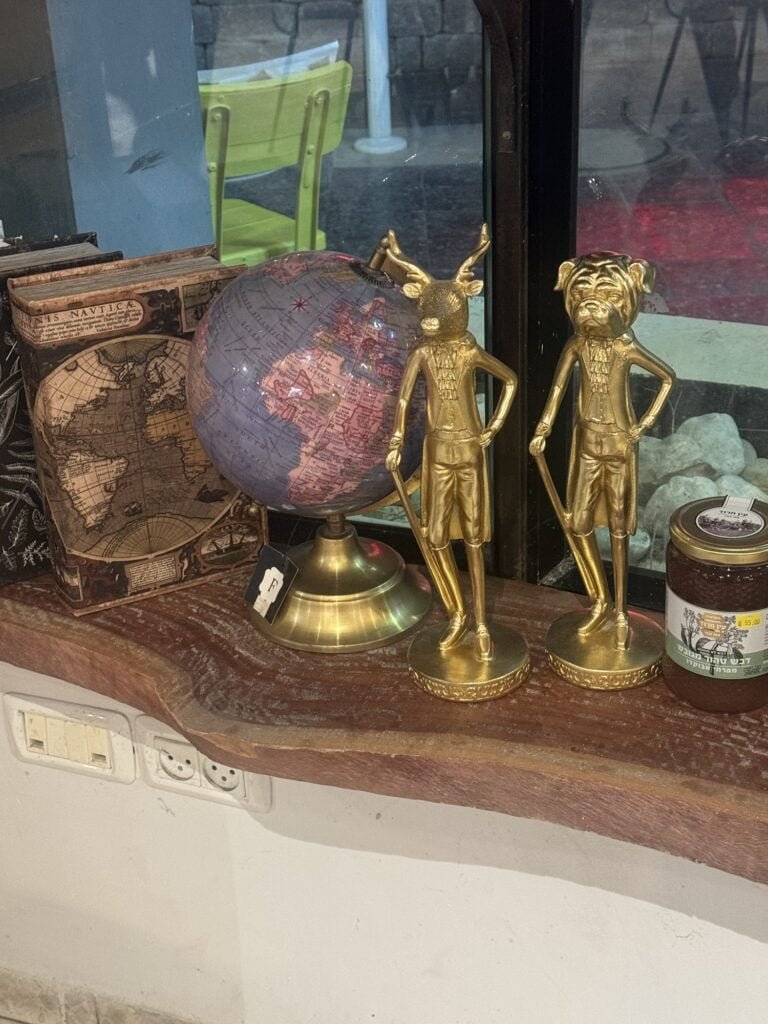
I spotted this globe at a wedding venue recently. I’ve no idea who the two figures aren’t? Feel free to make suggestions
-
sur GeoSolutions: GeoSolutions Participating at GIS-Pro 2024 in Portland, ME October 7-10
Publié: 2 October 2024, 11:12am CEST
You must be logged into the site to view this content.
-
sur Nouveau dans QGIS 3.40 : Le support CMJN
Publié: 2 October 2024, 8:41am CEST par Julien Cabieces
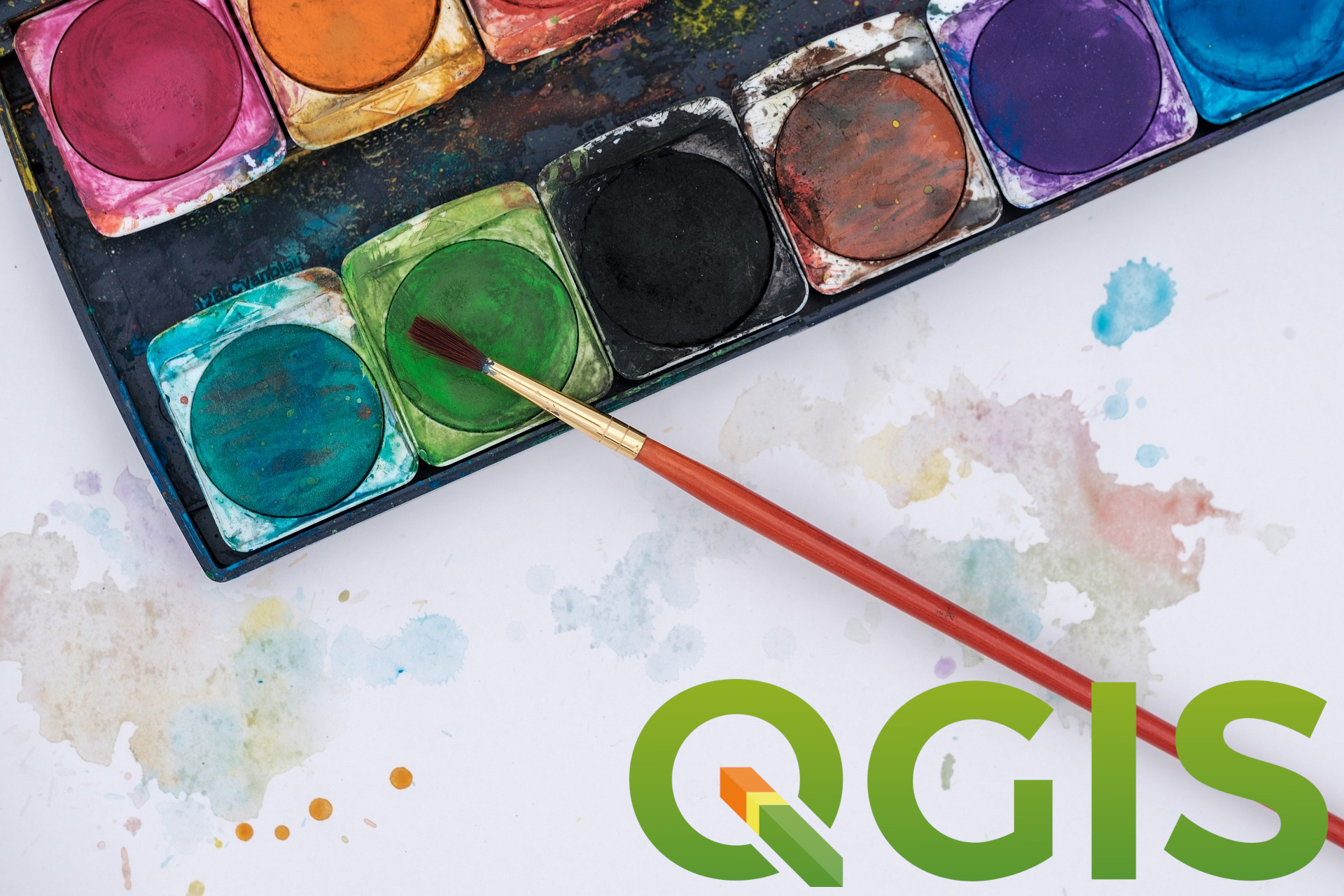
Crédits : Bru-nO (Pixabay Content License)
Grâce au financement de la Métropole de Bordeaux, j’ai eu la chance de travailler sur le support du CMJN (Cyan Magenta Jaune Noir, CMYK en anglais) dans QGIS. L’objectif de la métropole est de faire tomber la dernière barrière empêchant leur migration complète depuis ArcGIS vers QGIS.
Les développements sont maintenant terminés et seront disponibles dans la version 3.40 de QGIS, prévue pour être publiée en octobre 2024, avant de devenir la prochaine LTR en février 2025. Il est cependant à noter que le support du CMJN ne sera complet que dans les versions de QGIS construites avec Qt 6 (version encore non officielle) pour des raisons expliquées dans l’article. Sur Windows, cette version n’est actuellement installable qu’en utilisant OSGeo4W (version qgis-qt6-dev).
EDIT: En réalité, la version de QGIS construite à partir de Qt 6.8 qui embarque les modifications nécessaires pour l’export PDF CMJN n’est toujours pas disponible. Plus d’information ici.
C’est quoi le CMJN ?Vous connaissez certainement le RVB qui permet de coder une couleur sur écran en choisissant la quanté de rouge, vert et bleu de cette couleur. Il est aussi possible que vous utilisiez le TSL ou TSV.
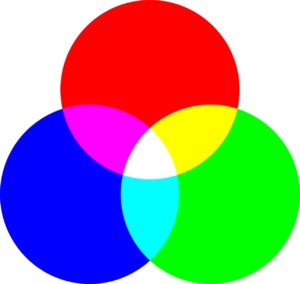
RVB – Crédits : Daniel Roberts (Pixabay Content License)
Ces 3 référentiels de couleurs permettent de coder une couleur pour un écran, le CMJN cible quant à lui les imprimantes en permettant de saisir la quantité exacte d’encre qui sera libérée lors de l’impression (d’où les 4 composantes CMJN, une par cartouche d’encre).

CMJN ( ici de gauche à droite, NCMJ ) – Crédits : Magnascan (Pixabay Content License)
Les caractéristiques du CMJN diffèrent fortement du RVB, on parle notamment de mode colorimétrique soustractif, car l’encre absorbe la lumière au contraire du RVB qui est dit additif, plus vous avez de rouge, vert, bleu plus vous vous rapprochez de la pleine lumière, le blanc.
La nature intrinsèquement différente de ces 2 espaces colorimétriques font qu’il est fortement déconseillé de convertir l’un vers l’autre. Le mieux est de choisir une couleur dans un espace (CMJN pour l’impression, RGB pour le rendu sur écran) et de s’y tenir.
Pire, l’impression d’une même couleur est différente selon l’imprimante, l’encre, le papier… Le choix d’une couleur CMJN se fait dans un espace de couleur, représenté par un fichier de profil ICC, fourni par votre imprimeur. C’est un peu l’équivalent d’un nuancier utilisé lors d’un choix de peinture.

Vous pouvez maintenant vous écharper sur la VRAIE bonne couleur d’une ligne de route – Crédits : Yanis Ladjouzi (Pixabay Content License)
Implémentation dans QGIS… et QtSuite aux développements, il est maintenant possible dans QGIS de :
- Saisir des couleurs au format CMJN, et en précision flottante ;
- Définir son mode de couleur préférentiel (RVB ou CMJN) et son espace de couleur ;
- Générer un fichier au format PDF/X-4 (prêt pour l’impression) embarquant un espace de couleur et utilisant des couleurs CMJN ;
- Permettre au moteur d’expression de manipuler des couleurs CMJN sans les convertir en RVB ;
- Gérer les rampes de couleurs CMJN ;
- Plein d’autres petites améliorations et corrections autour de la thématique des couleurs.
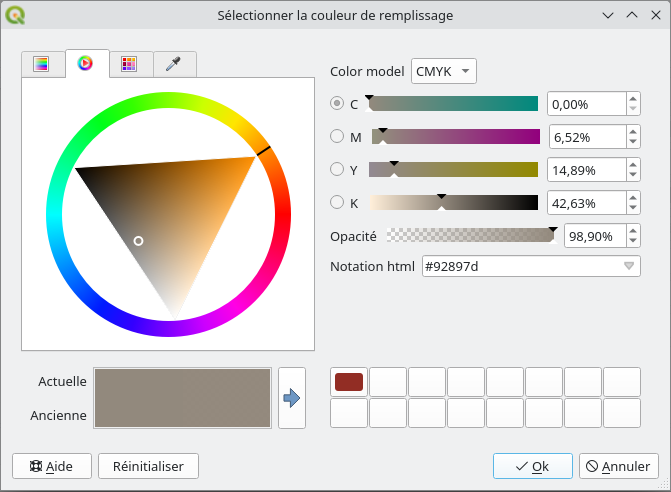
Selection des couleurs dans QGIS en CMJN
La belle histoire de l’Open sourceJ’ai pris un grand plaisir à participer à ce développement car il est le fruit de la collaboration de nombreux acteurs du logiciel libre.
Lors d’une première phase d’étude concernant le support du CMJN dans QGIS, on identifie rapidement que Qt, le cadriciel (framework) utilisé par QGIS pour le rendu des cartes, présente des limitations. Il convertit toutes les couleurs en RVB lors du rendu des cartes au format PDF et son support des espaces de couleurs CMJN est incomplet.
Il est donc nécessaire de le faire évoluer. Nous nous adressons donc à notre partenaire privilégié lorsqu’il s’agit de Qt, KDAB, et plus précisément Giuseppe D’Angelo qui réalise alors les développements nécessaires.
S’agissant de nouvelles fonctionnalités, ces dernières sont disponibles uniquement dans Qt 6 (Qt 5 est en fin de vie). C’est pour cette raison que le support du CMJN est incomplet dans les versions officielles de QGIS reposant encore sur Qt 5.
QGIS.org, l’association qui chapeaute le projet QGIS, a décidé de financer les développements sur Qt, charge ensuite à Oslandia de piloter ces développements puis de réaliser l’intégration dans QGIS. Cette intégration ainsi que les évolutions fonctionnelles afférentes été financé par la métropole de Bordeaux.
Mes développements ont ensuite été relus par d’autres contributeurs QGIS. (Si vous voulez en savoir plus sur le processus de contribution QGIS, vous pouvez lire un précédent billet de blog sur la qualité logicielle dans QGIS)
Enfin, je tenais à remercier spécialement Jehan, développeur sur le projet GIMP. Sa disponibilité et son exhaustivité dans nos correspondances électroniques m’ont grandement aidé à comprendre les enjeux à la fois techniques et fonctionnels du CMJN, et ont très certainement contribué à la qualité du résultat obtenu.
La suiteQGIS 3.40 sera donc capable de générer un fichier PDF/X-4 utilisant des couleurs CMJN. Qt, de son côté, améliore le support du CMJN, l’écriture PDF, et la gestion des espaces de couleurs.
Encore merci à la métropole de Bordeaux et QGIS.org pour avoir financé ces développements, et toutes les personnes impliqués dans la réalisation de ceux ci.
Nous serions ravis d’avoir des retours d’utilisateurs sur vos cas d’utilisation liés à la gestion des couleurs dans QGIS. N’hésitez pas à nous écrire ou à commenter nos posts pour nous dire comment vous utilisez ces fonctionnalités.
Ces fondations dans la gestion des espaces colorimétriques dans QGIS ouvrent la porte à de futurs perfectionnements. Si le sujet vous intéresse et que vous souhaitez contribuer, n’hésitez pas à nous contacter à infos+qgis@oslandia.com et consulter notre offre de support à QGIS.
-
sur Mappery: A Wild Map in a Nuclear Bunker
Publié: 1 October 2024, 1:00pm CEST
Pièce jointe: [télécharger]

Rollo spotted this Mapsinthewild in a late 1940’s nuclear bunker operations room in York with the ‘most advanced map of the time’ laid out. This facility was designed to monitor impact and fall out. It would support a team of 60 for 30 days underground…. apparently design was out dated almost immediately (1950) but was still manned for 30 years!!!!
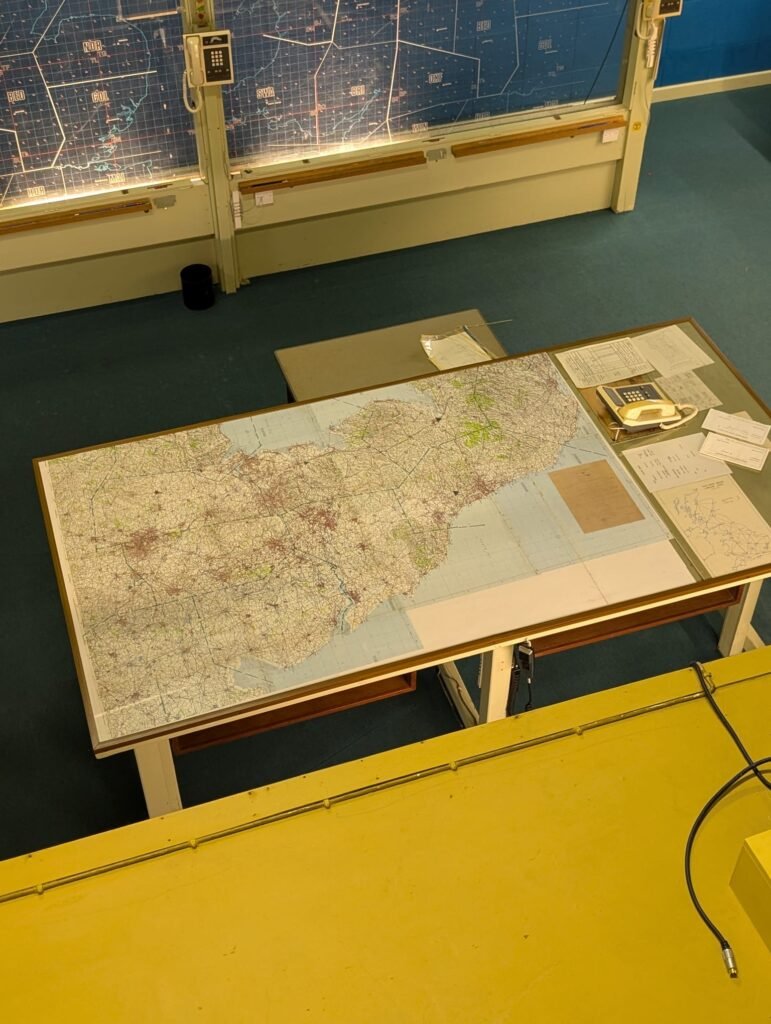
And here is the 1980’s tech update …

-
sur Camptocamp: Generative AI in geospatial: A Pyramid of Increasing Complexity
Publié: 1 October 2024, 4:00am CEST
Pièce jointe: [télécharger]
Large Language Models LLMs like GPT have emerged as game-changers in the way we interact with technology, automate processes and generate content. -
sur OSGeo Announcements: [OSGeo-Announce] We are pleased to announce that OTB version 9.1.0 is out!
Publié: 30 September 2024, 8:16pm CEST
Ready to use binary packages are available on the package page of the website:
* OTB-9.1.0-Linux.tar.gz
<https://www.orfeo-toolbox.org/packages/OTB-9.1.0-Linux.tar.gz>\(Ubuntu/Debian\)
* OTB-9.1.0-Linux_RedHat.tar.gz
<https://www.orfeo-toolbox.org/packages/OTB-9.1.0-Linux_RedHat.tar.gz>\(Linux\)
* OTB-9.1.0-Win64.zip
<https://www.orfeo-toolbox.org/packages/OTB-9.1.0-Win64.zip>\(Windows
64 bits)Docker images are available with different python versions (3.8 by default, 3.10 for 9.1.0_ubuntu22, 3.12 for 9.1.0_ubuntu24) :
|docker pull orfeotoolbox/otb:9.1.0|
It is also possible to checkout the branch with git:
|git clone Main Repositories / otb · GitLab OTB -b release-9.1|
The documentation for OTB 9.1.0 can be found here <https://www.orfeo-toolbox.org/CookBook-9.1/>\.
To download the packages one by one for a modular installation, you can download them here < [https:]] follow the instructions in the cookbook <https://www.orfeo-toolbox.org/CookBook-9.1/Installation.html>\.
*Changes*
This release introduces bug fixes, important dependencies update (jpeg turbo, geotiff and GDAL), documentation improvement and *the support of SPOT5* (previously drop in OTB8 as OSSIM dependency was removed).
The full changelog can be accessed here <https://gitlab.orfeo-toolbox.org/orfeotoolbox/otb/-/blob/release-9.1/RELEASE_NOTES.txt>\.
We welcome your feedback and requests on OTB’s GitLab <Sign in · GitLab; and if you find a bug, please report it!
*Reminder from OTB 9.0:*
The *whole new packaging system* is entirely made with CMake / CPack, to make the toolbox more modular. You still have the possibility to have a full package for Linux and Windows, but for those who want to install only a part of the toolbox it is possible since v9. The modules list is available in the cookbook with their associated applications. All the packages are now in tar.gz and the installation is movable unlike OTB < 9.
*All GUI has been dropped*. QGIS is now the official visualization tool. We support the development of a plugin which you can use with the following instructions <https://www.orfeo-toolbox.org/CookBook/QGISInterface.html>\. Thus *like 9.0 the version 9.1 does not include Monteverdi or Mapla*.
Like version 9.0, Mac version is not supported, you can use docker image.
Laurent Tristan
OTB Team1 post - 1 participant
-
sur Mappery: Battersea Park Playground
Publié: 30 September 2024, 1:00pm CEST
Pièce jointe: [télécharger]

The Geomob speaker, known as the Geospatial Index, shared this picture from a Battersea Park playground in London.
-
sur Paul Ramsey: Cancer 12
Publié: 30 September 2024, 4:00am CEST
Back to entry 1
I was glancing at the New York Times and saw that Catherine, the Princess of Wales, had released an update on her treatment. And I thought, “wow, I hope she’s doing well”. And then I thought, “wow, I bet she gets a lot of positive affirmation and support from all kinds of people”.
I mean, she’s a princess.

Even us non-princesses, we need support too, and I have to say that I have been blown away by how kind the people around me in my life have been. And also how kind the other folks who I have never really talked with before have been.
I try to thank my wife as often as I can. It is hard not to feel like a burden when I am, objectively, a burden, no matter how much she avers I am not. I am still not fully well (for reasons), and I really want to be the person she married, a helpful full partner. It is frustrating to still be taking more than I’m giving.
From writing about my experience here, I have heard from other cancer survivors, and other folks who have travelled the particular path of colorectal cancer treatment. Some of them I knew from meetings and events, some from their own footprint on the internet, some of them were new to me. But they were all kind and supportive and it really helped, in the dark and down times.
From my work on the University of Victoria Board of Governors, I have come to know a lot of people in the community there, and they were so kind to me when I shared my diagnosis. My fellow board members stepped in and took on the tasks I have not been able to do the past few months, and the members of the executive and their teams were so generous in sending their well-wishes.
And finally, my employers at Crunchy Data were the best. Like above and beyond. When I told them the news they just said “take as much time as you need and get better”. And they held to that. My family doctor asked “do you need me to write you a letter for your employer” and I said “no, they’re good”, and he said, “wow! don’t see that very often”. You don’t. I’m so glad Crunchy Data is still small enough that it can be run ethically by ethical people. Not having to worry about employment on top of all the other worries that a cancer diagnosis brings, that was a huge gift, and not one I will soon forget.
I think people (and Canadians to a fault, but probably people in general) worry about imposing, that communicating their good thoughts and prayers could be just another thing for the cancer patient to deal with, and my personal experience was: no, it wasn’t. Saying “thanks, I appreciate it” takes almost no energy, and the boost of hearing from someone is real. I think as long as the patient doesn’t sweat it, as long as they recognize that “ackknowledged! thanks!” is a sufficient response, it’s all great.
Fortunately, I am not a princess, so the volume was not insuperable. Anyways, thank you to everyone who reached out over the past 6 months, and also to all those who just read and nodded, and maybe shared with a friend, maybe got someone to take a trip to the gastroenterologist for a colonoscopy.
Talk to you all again soon, inshala.

-
sur Mappery: Sanssouci Park
Publié: 29 September 2024, 1:00pm CEST
Pièce jointe: [télécharger]

Reinder said “These images show a 3D plan in bronze or something, from the park ‘Sanssouci’ in Potsdam. A beautiful place with an unrivaled amount of quite impressive palaces. [https:]] “
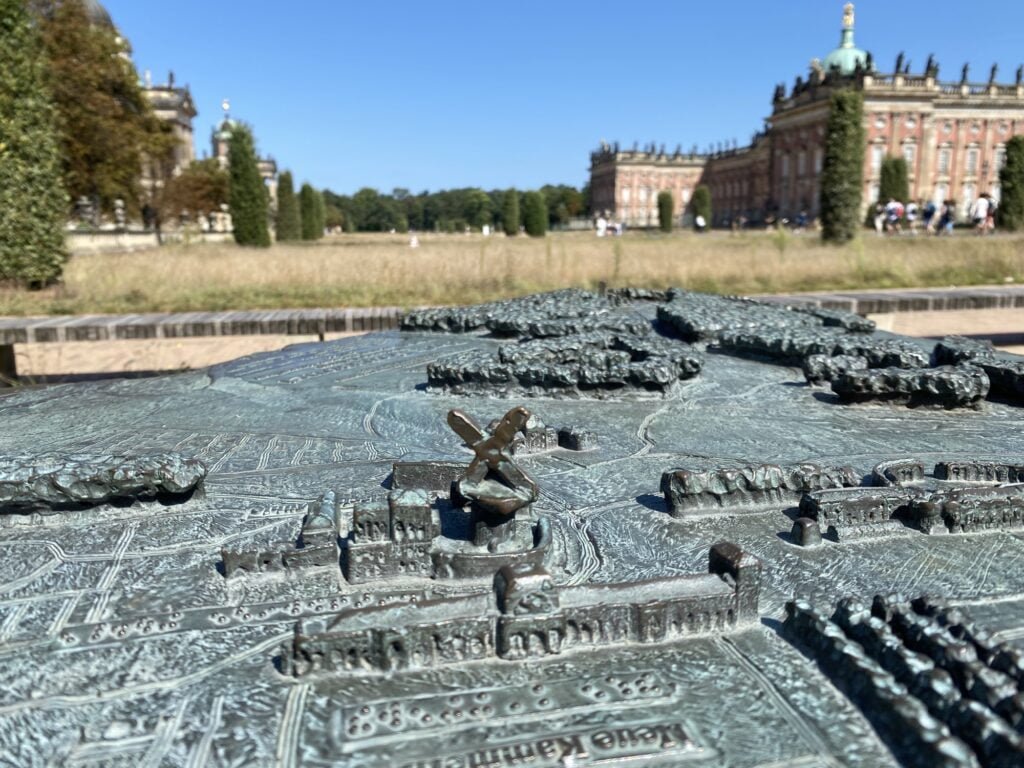
-
sur Mappery: Globe 1639 at Magic Mushroom
Publié: 29 September 2024, 1:00pm CEST
Pièce jointe: [télécharger]
 Screenshot
Screenshot
Reinder spotted this on Spuistraat, Amsterdam.
“Now it is a branch of Magic Mushroom – but in 1639 a globe was bricked into the facade.”
I had to check that Magic Mushroom was what I thought it was, and it was! No endorsement but I guess your maps get super wild afgter a trip to this place.
-
sur QGIS Blog: Catching up with the QGIS User Conference 2024 & Save the Date for 2025
Publié: 28 September 2024, 9:26pm CEST
This year’s user conference took place in Bratislava, organized by the Slovak QGIS User Group and hosted at the Slovak University of Technology Faculty of Civil Engineering. The event was sold out early and the venue was full of energy and excitement.
If you missed the conference or couldn’t make it to a talk due to too many great overlapping sessions, you now have the opportunity to catch up with everything on the UC 2024 playing list:
Thanks to the organizers, speakers, sponsors, and all participants for the wonderful event.
If you want to read some personal reports from community members, here’s Ujaval Gandhi’s report: [https:]] ; and here’s Hans van der Kwast’s: [https:]]
Last but not least, we want you to save the date for next year’s user conference:

The QGIS User Conference will be in Norrköping, Sweden from 2-3 June 2025, and contributor meeting there after 4-7.
-
sur Markus Neteler: GRASS GIS PSC Elections 2024: nomination period ongoing
Publié: 28 September 2024, 5:41pm CEST
The post GRASS GIS PSC Elections 2024: nomination period ongoing appeared first on Markus Neteler Consulting.
-
sur Mappery: Tire-Lire bookshop
Publié: 28 September 2024, 1:00pm CEST
Pièce jointe: [télécharger]
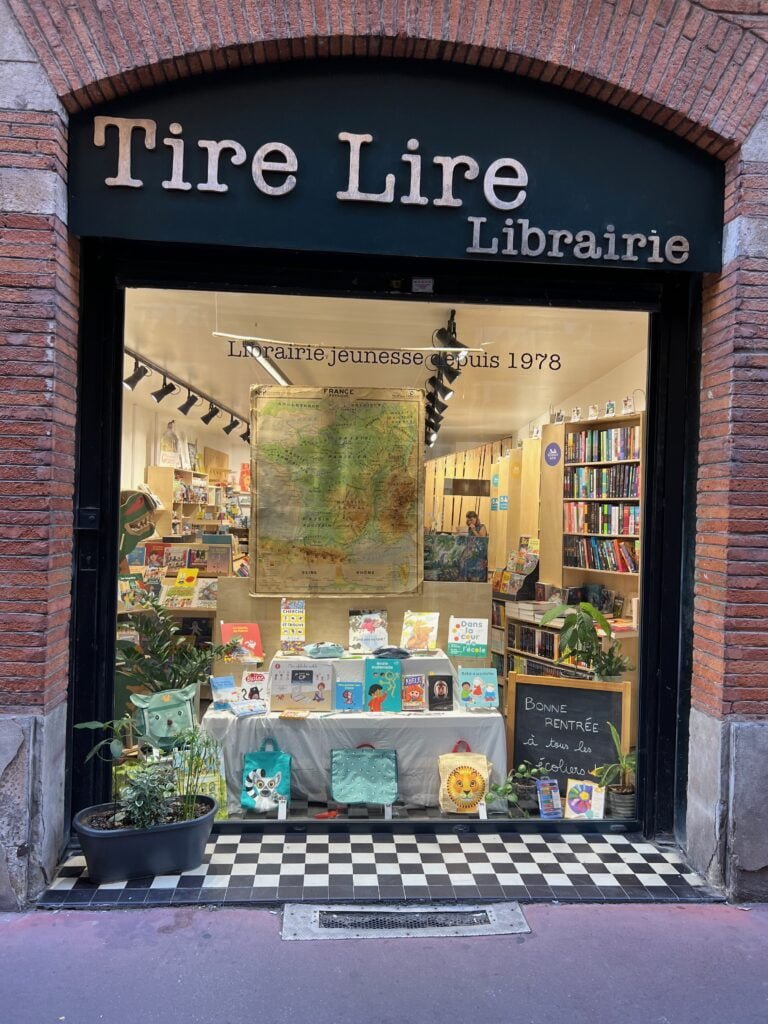

A bookshop in Toulouse, France, displaying a vintage school map
-
sur OTB Team: OTB Release 9.1.0
Publié: 27 September 2024, 10:52pm CEST
Dear OTB community, We are happy to announce that OTB version 9.1.0 has been released! Ready to use binary packages are available on the package page of the website: The Docker image is available :docker pull orfeotoolbox/otb:9.1.0 For those who want to use docker with python 3.10 or 3.12, you can respectively pull images 9.1.0_ubuntu22 […] -
sur Mappery: Place Mat
Publié: 27 September 2024, 1:00pm CEST
Pièce jointe: [télécharger]
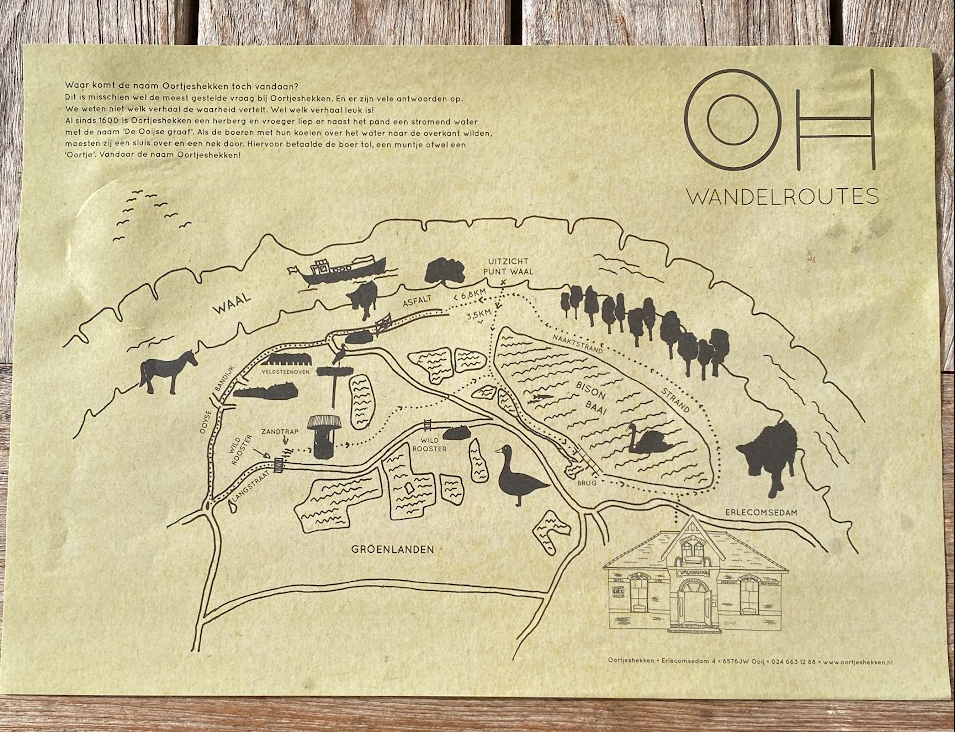
This is clever. Reinder shared this place mat from the restaurant ‘Oortjeshekken’, in the Ooijpolder, near Nijmegen. Yes it is a place mat for your plate and cutlery in the restaurant and it is also a place map for the surrounding area.
-
sur DuckDB pour QGIS : nouveautés de QDuckDB version 1.0.0
Publié: 27 September 2024, 8:51am CEST par Florent Fougères
Le plugin
Il y a près d’un an, en novembre 2023, dans cet article, nous vous avions présenté le plugin QDuckDB, financé par l’IFREMER et développé par Oslandia. Dans ce précédent article, nous présentions DuckDB et les caractéristiques fonctionnelles du plugin.
Depuis, en plus du financement de l’IFREMER, Oslandia a auto-investi du temps de maintenance pour corriger les bugs remontés par les utilisateurs et stabiliser les performances du fournisseur de données (provider) que contient le plugin.
Pour rappel, un provider QGIS est une interface ou une couche logicielle qui lui permet d’accéder à différentes sources de données géospatiales. Autrement dit, c’est un composant qui gère la connexion entre QGIS et les données géospatiales dans différents formats.
Cas d’usage- Récupérer les données Overtures Maps directement dans une base de données DuckDB puis les charger dans QGIS via le plugin pour les représenter ou bien effectuer des analyses spatiales. Cela apporte un vrai cas d’usage au plugin puisqu’il n’est pas possible de récupérer les données Overtures Maps dans un format SIG plus classique (shapefile, geojson par exemple)
- Chargement des données INSEE et croisement avec la BD TOPO chargée en gpkg. L’INSEE fournit des données au format parquet et avec l’extension spatiale DuckDB est bien sûr capable de charger des gpkg.
- Ce plugin est utilisable aussi bien dans l’application bureau de QGIS qu’avec QGIS Serveur. Ainsi, l’IFREMER utilise ce plugin pour diffuser sur le web des données enregistées dans une base de données DuckDB. Elles peuvent être représentées sous forme d’images (flux WMS) ou de données géométriques (flux WFS). Cette solution a l’avantage d’être facile à mettre en place (il n’y a pas besoin d’un service de base de données, les données étant enregistrées dans un fichier), tout en profitant de la vitesse du format DuckDB.
Depuis l’année passée, les deux grands axes de développement ont été les performances du plugin et la stabilité.
Par performance, on entend augmenter la vitesse de chargement des entités dans QGIS. Nous avions par exemple des coins d’ombre sur la latence, voire des crash lorsqu’une table provenant de DuckDB possédait beaucoup d’entités.
Le provider initial avait été implémenté avec le strict minimum pour fonctionner. Depuis nous avons ajouté tous les composants nécessaires à QGIS pour permettre d’être plus performant.
Enfin, le second axe de développement a été la stabilité. Ce travail a été permis par les utilisateurs qui ont remonté des bugs, que nous avons corrigés. Nous avons aussi renforcé la partie test unitaire. Parmi les choses que nous avons améliorées, on peut citer par exemple, le support des tables non géographiques, le support des vues ou encore la prise en charge des types de colonnes DATE et TIME.
Si vous souhaitez plus de détail sur ces deux points, vous pouvez consulter le changelog du projet.
Nous répercutons également chaque nouvelle version de DuckDB dans le plugin dans les jours qui suivent celle-ci, comme par exemple la sortie de DuckDB 1.1.0.
Release 1.0.0Après avoir amélioré les performances et la stabilité, nous sommes donc arrivés à un premier jalon important du provider. Nous avons implémenté tous les composants que propose QGIS pour la construction d’un provider tiers personnalisé.
Cet article annonce donc officiellement la en version 1.0.0 du plugin QDuckDB ainsi que la disparition du flag
Et ensuiteexperimental.Mais le travail n’est pas fini pour autant. Pour rappel le plugin ne fait actuellement que du read only (lecture seule). L’étape suivante serait donc de développer le mode écriture.
On souhaite également améliorer l’intégration du plugin dans QGIS, par exemple en ajoutant une nouvelle entrée DuckDB dans l’explorateur des sources de données natif de QGIS.
Pour toutes ces nouvelles fonctionnalités à développer, nous sommes à la recherche de financement. Vous pouvez retrouver une liste non exhaustive des développements à venir en regardant les tickets taggés
To be fundeddans le projet Gitlab. Il est également possible d’ouvrir de nouveaux tickets pour des fonctionnalités auxquelles nous n’aurions pas pensé.Si vous êtes intéressé(e), vous pouvez vous signaler dans les tickets, nous contacter sur Linkedin ou bien par email à qgis@oslandia.com. Toute contribution est la bienvenue : code, documentation, financement…
Liens importants- Le code source (sous licence GPL2+)
- La documentation
- Le plugin sur le dépôt officiel QGIS
-
sur OSGeo Announcements: About the Announce category
Publié: 27 September 2024, 6:24am CEST
-
sur Even Rouault: Those concepts in the geospatial field that have cost us millions of $$$
Publié: 27 September 2024, 12:52am CEST
Every domain has its baggage of concepts, which at first sight don't appear to be that terrible, but which are in practice.
Let's start with a non-geospatial example. A lot of programming languages have the concept of a "null" pointer. It is available in the C and C++ programming languages in particular, but in Java as well, or Python, etc.. Tony Hoare, null's creator, regrets its invention: "I call it my billion-dollar mistake." While very useful in some contexts, that feature also happens to cause a lot of bugs, with severe criticity in some cases. The Rust language has for example (almost) removed the null pointer concept and replace it with optional references, where the compiler enforces that the code explictly checks for the validity of the reference before using it. At the minute, I'm writing this, I'm debating about that very issue with a colleague.
The geospatial field is not free of concepts that are a never-ending source of troubles, and I will come with my own list, with my perspective of software developer.
- Geometry model. Point, lines, polygons. What could be most simple than that? Well, the commonly-used OGC Simple Features model allows those objects to be empty. How is that useful in practice? Hard to tell: NULL geometries are (somewhat paradoxically given the above paragraphy) actually a better replacement. My own perception of that "feature" is that it is mostly a huge headache that goes into your way when trying to write robust code. One evidence of that is that the same standard that invented it neglected to specify how to export an empty point in the Well Known Binary representation. Over the years, the tradition has become to use the Not-A-Number value for the X and Y value of an empty point. Which by itself may cause interesting consequences for applications that would neglect to make a special case. A Not-A-Number is ... well ... not a number, and for example it is not equal to itself ... (and in the IEEE-754 representation, there are litteraly billions of different binary potential encodings of a NotANumber). Everything you learnt at school in your math courses will break with it (this is actually quite general when crunching numbers with computers. Finite precision break a lot of the expected properties of ideal numbers). An empty line has the undesirable property of not having a start or end point: any algorithm must be ready for that. Another annoyance is that there is not just one "geometry empty" object, but a "point empty", a "line empty", a "polygon empty", etc. What is the expected intersection of an empty line with an empty polygon ? An empty line, an empty polygon, an empty point, ... ? The developers of the GEOS library or the PostGIS spatial extension have unfortunately to regularly debate at length about those topics. One can but think there would be a better use of their expertise and time than having to deal with such esoteric subjects (I didn't ask them, so they may actually be thrilled by them. You never know...)
- Coordinate reference system (CRS) axis order. CRS, such as WGS 84 geographic, or UTM 31N / ETRS89 have several axis. For geographic CRS, this will be the longitude, the latitude, and optionally the ellipsoidal height. When expressing coordinates in a CRS, one must decide in which order they are specified. They are lengthy debates whether this should be longitude first, latitude second, or the reverse. The ISO 19111 / OGC Abstract Topic 2 specification or geodetic registries have decided to not take a firm stance on that, and have allowed authorities responsible for CRS definition and maintenance, to submit CRS definitions with the axis order they wish. Excellent! Well no. The issue is that while non-geomaticians user may chose to express a coordinate in prose like "50 degree of latitude north, 15 degree of longitude east", or "15 degree of longitude east, 50 degree of latitude north", that doesn't mean it is a good idea that the software systems reflect that liberty of speech. Some GIS formats have no way of clearly expressing the CRS, or if they have, they might use an incomplete way of specifying it, in particular lacking the way to express the axis order. The usual practice is to generally specify the longitude as the first value (as corresponding to the X/horizontal axis of a Cartesian plan) and latitude next (Y/vertical axis), refleting the natural mapping to make a graphical representation. Other formats (GML in particular) require that the coordinates are expressed in the order of the CRS definition, which require access to a database to get the axis order, given that in GML vector files, the CRS is only referenced through a code, and not defined inline. Depending on whether the persons responsible to design the protocol/file format, the order may be the "GIS friendly one" (longitude-latitude), or the "CRS pedantic one" (latitude-longitude for example for geographic CRS defined by the EPSG geodetic registry). This is an eternal source of confusion. Sometimes with absurd situations. The OGC GeoPackage file format captures a full definition of the CRS used in the vector tables it contains, including in particular the official axis order, but to reflect the long-GIS tradition, as an amendment, specify that the encoding of coordinates in its (extension of) the WKB format mentionned in the previous paragraph should be longitude-latitude (for geographic CRS) or easting-northing (for projected CRS). I will not blame anyone particular for this. This is an "overall system error". In the ideal situation, a courageous geomatician in a standard organization or in a geodetic registry should have said "here, we are geomaticians: geographic CRS are always longitude-latitude, and projected CRS are always easting-northing. It is your responsibility as users of our system to provide data always in that order". Failing to have access to a time-travel machine to warn in advance my glorious predecessors about the incoming catastrophe, the only solution I see to solve the issue it is to ask all population to relocate on the line of longitude=latitude, and exclude any mapping outside of it.
- Raster cell registration issues, a.k.a pixel-centre versus pixel-corner, or pixel-is-point versus pixel-is-area, a.k.a the half-pixel shift error. A raster cell is both an entity you reference with a (column, line) integer pair, so perceived as a discrete point, but when displayed, it actually occupies a non-zero area on your display device. When that raster cell is registered against geospatial coordinates, one debate is: "what exact place in that cell does this (longitude, latitude) or (easting, northing) refer to? Is that the center of the pixel, or maybe its top-left corner?" . Obviously, whenever there is a choice, file format and service specifications never agree together. The GDAL software has courgeously decided to "standardize" its internal model to the convention where that the georeferenced coordinate associated to a pixel qualifies the location of the top-left corner. GDAL format drivers do the necessary dance of applying and de-applying a half-pixel shift to go into that convention ... when they have access to the convention of the underlying format.
A temptative conclusion could be that any proposed standard or specification should go to the step of having an actual real-world implementation of it, not just a "working prototype" ("toy implementation" more casually), to check whether some apparently minor details are not a major source of inconvenience.
-
sur GeoTools Team: GeoTools 32.0 released
Publié: 27 September 2024, 12:33am CEST
GeoTools 32.0 released The GeoTools team is pleased to announce the release of the latest stable version of GeoTools 32.0: geotools-32.0-bin.zip geotools-32.0-doc.zip geotools-32.0-userguide.zip geotools-32.0-project.zip This release is also available from the OSGeo Maven Repository and is made in conjunction with GeoServer 2.26.0 and GeoWebCache 1.26.0


